

20 Things to Do in Bavarian Alps: 5 Towns, 15 Attractions
Before, when I thought of Germany as a destination, my imagination would instantly turn to its beer festivals, cutting-edge car museums, and a wide range of historical attractions, from age-old medieval villages to significant World War II monuments.
It wasn’t until I discovered the Bavarian Alps, located in the southernmost part of Germany, that I realized Germany also boasts stunning natural landscapes. Despite the Bavarian Alps being just a small part of the country, I was surprised to find that it’s home to some of Germany’s most beautiful destinations — the places provide a unique blend of culture, adventure, and breathtaking scenery.
What’s more exciting? The Bavarian Alps are home to some of the country’s unique and iconic destinations. These include the enchanting Neuschwanstein Castle, Zugspitze – the highest peak in Germany, and Oberammergau, a village renowned for its Passion Play.
There are even more incredible destinations waiting for you in the Bavarian Alps, and the three mentioned are just the beginning. Allow me to introduce you to the most remarkable attractions and activities that this splendid region has to offer.
This post contains affiliate links. I may receive a tiny commission at no additional cost to you.
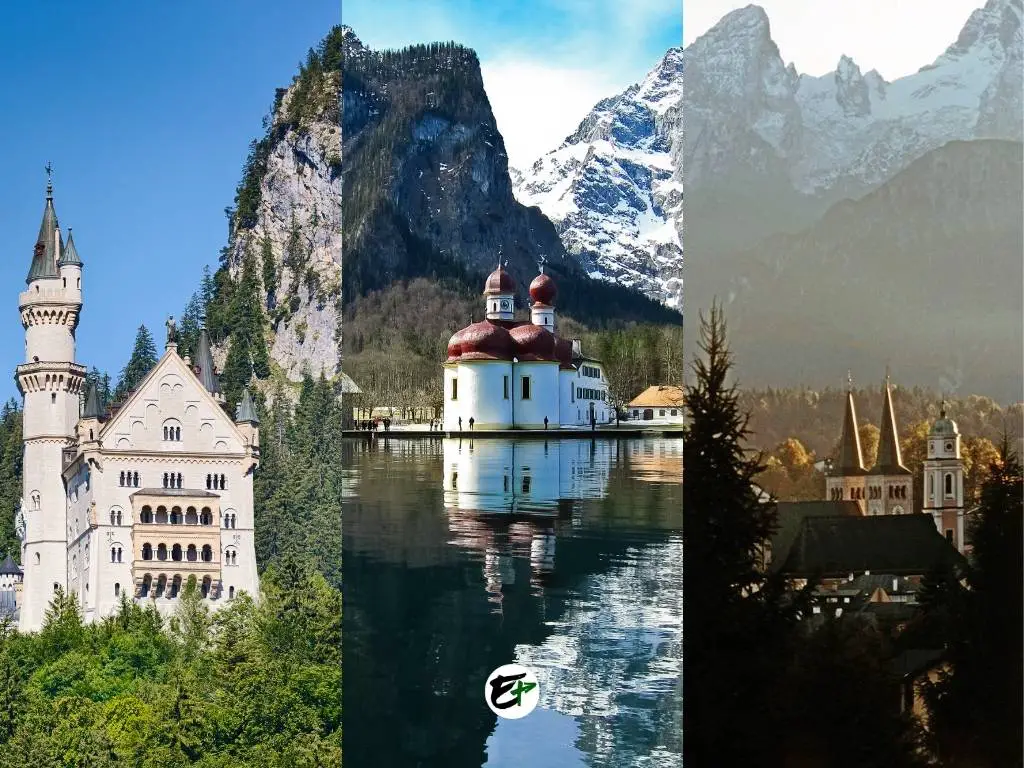
Use the table of contents to skip to topics.
Good to know : This post can also help you create your own Bavarian itinerary with the tips and travel information after the discussion about the destinations in Bavarian Alps.
- If you are in need of a pre-made Bavarian Alps itinerary, you can refer to my 3-day Bavarian Alps Itinerary . This is best suited for weekend trips.
- Alternatively, you might consider the 7-day Bavarian Alps Itinerary . This is a week-long trip that offers the region’s best experiences.
- Lastly, for the ultimate trip that includes all the highlights, you can check out the 10-day Bavarian Alps Itinerary .
To put it simply, the Alps in Germany are situated in the southernmost part of the country, stretching along the German-Austrian border from Lindau to Berchtesgaden, from west to east. The German Alps are entirely within the state of Bavaria, hence the name Bavarian Alps.
Scattered along the Bavarian Alps, you’ll find charming alpine towns and villages that are not only travel destinations but also bases for exploring nearby natural attractions and adventures. Five towns and villages caught my attention; from east to west, they are Berchtesgaden, Mittenwald, Garmisch-Partenkirchen, Oberammergau, and Hohenschwangau.
These locations provide quick access to the top attractions in the Bavarian Alps and memorable outdoor adventures like:
Eagle’s Nest
Leutasch gorge, hummock meadows.
- Olympia-Skistadion Sprungschanze (Olympic ski stadium ski jump)
Ettal Abbey
Linderhof palace.
- Alpine Coaster
Neuschwanstein Castle
Hohenschwangau castle.
Essentially, they are the highlights of the Bavarian Alps and should be included in your travel plans.
Find the best hotel deals in Bavarian Alps here.
Berchtesgaden
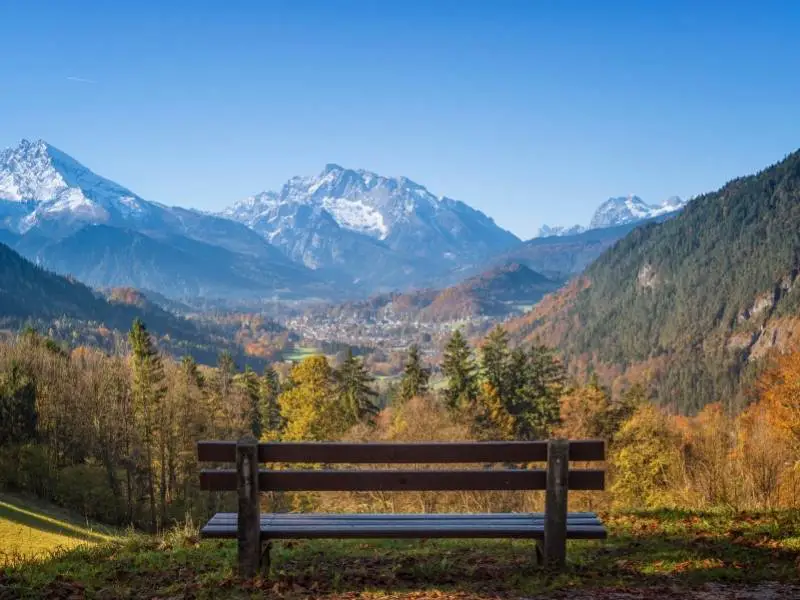
Fascinatingly, one of the most stunning locations to explore in all of Germany, is not in the heart of the country. Instead, it is situated in the country’s southeast corner: Berchtesgaden.
I often liken Berchtesgaden to Switzerland’s Lauterbrunnen or Jungfrau region , primarily due to the three peaks of the Watzmann Range, which remind me of Jungfrau, Monch, and Eiger. And if you’re an outdoor lover, Berchtesgaden is sure to give you a trip you will not forget! There’s a certain charm in extremes, as you’ll discover when we explore the highlights of a visit to Berchtesgaden.
Famed for its salt mine and the pristine Lake Konigs (Konigssee or King’s Lake), Berchtesgaden is a town that boasts a variety of natural wonders. This town serves as a gateway to Germany’s tallest waterfalls, the most charming chapel nestled by a lake, and a breathtaking WWII scenic landmark.
Situated in the extreme southeast of Germany, Berchtesgaden is nearly completely encircled by Austria. The town’s only connection to the rest of Germany extends northwest, towards Munich. In fact, Berchtesgaden is closer to the Austrian city of Salzburg than it is to Munich. Just a short 30-minute journey from Salzburg will bring you to Berchtesgaden.
If you plan to visit Berchtesgaden, the three things that you would not want to miss experiencing are:
- Cruising in Konigssee’s crystal clear lake water
- Seeing the epic view of the Bavarian Alps from Eagle’s Nest
- Viewing the spectacular tunnels in Salt Mine
You can cover Konigssee and Eagle’s Nest, the two main attractions in Berchtesgaden, in a single day tour. However, it’s advisable to set aside 2 to 3 days for your trip to Berchtesgaden, as the region boasts many more beautiful places to explore.
Berchtesgaden is brimming with numerous scenic spots waiting to be discovered, making it an ideal location for hiking. Given this, you might find yourself wanting to extend your stay to 4 to 5 days, or even up to a week.
Uncover all the details about Berchtesgaden in my article, which includes my personal reasons for considering Berchtesgaden as a must-visit destination or take a sneak peek at the scenic spots in Berchtesgaden .
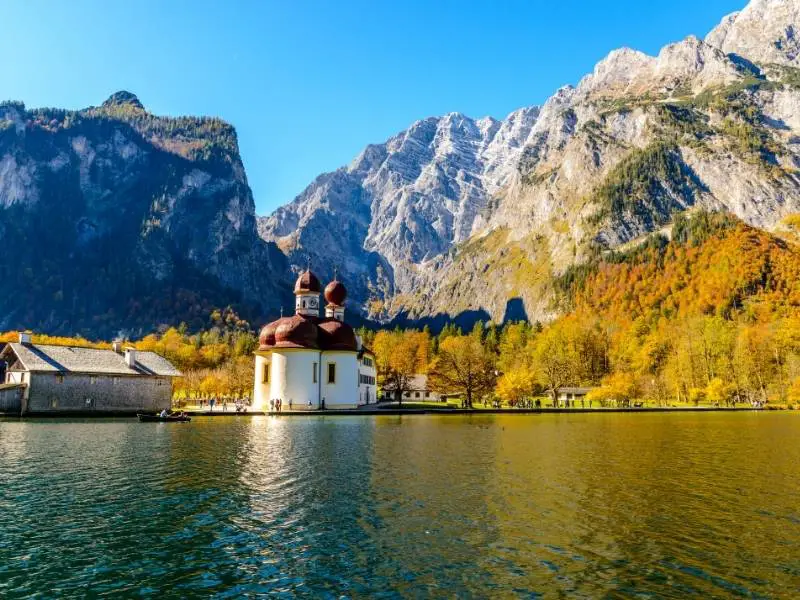
Konigssee, often referred to as the king’s lake, is widely regarded as Germany’s most stunning lake. Its beauty is undeniable, and it’s also one of the country’s cleanest bodies of water. The sight of Konigssee is something you could gaze at endlessly. The gentle waves, the shimmering, reflective surface, and its occasional misty demeanor will leave you in a state of pure bliss.
But that’s not all. You may have seen images on social media of a picturesque peninsula at Konigssee. This is where a charming pilgrimage church stands. The church of Saint Bartholomew is a sight that will captivate you more than you can imagine.
A trip to Konigssee also brings you within reach of three other stunning attractions in Berchtesgaden. These include the Ice Kapelle, Obersee, and the Röthbach waterfall, which holds the title of Germany’s tallest waterfall. So, a visit to Konigssee is not just about the lake, but an opportunity to explore these additional natural wonders.
Visiting information: koenigssee.de

Berchtesgaden boasts several viewpoints, but none are as renowned as the Eagle’s Nest. This historic site was once a meeting place for the Nazis. The name “Eagle’s Nest” was coined during a rare diplomatic meeting with the French ambassador, André François-Poncet.
Perched on a ridge of the Hoher Goll mountain range, the Eagle’s Nest sits at an elevation of 1834 meters or 6017 feet. From this vantage point, you can witness the breathtaking transition of the Bavarian Alps into flatlands from south to north. On a clear day, you can easily spot Konigssee and Salzburg.
The Eagle’s Nest also houses a restaurant, offering a unique dining experience with a view. As you savor your meal, your eyes feast on the stunning panorama. To enrich your visit, historical tours are available. Participating in a tour is a great way to learn more about this fascinating location.
Visiting information: kehlsteinhaus.de
Berchtesgaden offers unforgettable experiences, whether you’re on top of the mountains, drifting on the lake’s surface, or beneath the earth. If you’re looking for something unique on your journey in the Bavarian Alps, Berchtesgaden’s Salt Mine is worth a visit.
The tour inside the Salt Mine is a mix of fun activities, salt exhibitions, and experiences with technology used in extracting salt from the Alps. Laser shows, slides through tunnels, trains, and elevators provide insights into the 500-year-old Berchtesgaden salt mining culture. This activity would be great for kids, but for young adults like me, it might not be the best fit.
However, if you still have energy, you should focus on the absolutely scenic, breathtaking, and beautiful vantage points of the Bavarian Alps in Berchtesgaden. Some of these scenic spots in Berchtesgaden require a hike, but they are definitely worth it. If you visit Berchtesgaden during fantastic weather, your camera’s storage will fill up quickly.
Visiting information: salzbergwerk.de

Do you love to wander aimlessly while traveling? If so, Mittenwald in the Bavarian Alps could be the perfect destination for you. Nestled close to the mountains and adorned with Lüftlmalerei throughout its town center, Mittenwald is sure to satisfy your desire for leisurely exploration.
Imagine strolling along a street lined with houses adorned with Lüftlmalerei, with the backdrop of snowy mountain peaks scraping the sky. It’s like walking through the pages of a fairytale! That’s the experience Mittenwald offers.
But where exactly is Mittenwald? It’s located in the heart of the Bavarian Alps, at the foot of the Karwendel mountain range. Its proximity to the German-Austrian border is such that a less than 30-minute hike can land you in Austria!
Mittenwald is also renowned for its violins. Centuries ago, people across Europe recognized Mittenwald as the source of high-quality violins. Today, you can delve into this centuries-old craft at the village’s Violin Making Museum, situated in the heart of the town.
You will love going to Mittenwald if these activities fit your liking:
- Dammkar Skiroute – Skiing in Germany’s longest
- Leutasch Gorge – Exploring a gorge with folklores
- Hummock Meadows – See mesmerizing, picturesque meadows
Wondering how long to stay in Mittenwald? If you’re planning to ski, take a short hike, explore the town, and visit Buckelwiesen and Leutasch Gorge, a 1 to 2-day stay is recommended. However, if you’re keen to visit the charming mountain huts and explore more of Karwendel by hiking, you might want to extend your stay.
Mittenwald also hosts events that you might want to experience, such as Mittenwalder Musiksommer and the Bringing in Sheep/Goats/Cattle in town. These unique local events could be worth scheduling your visit around.
Explore the different experiences and tourist attractions that await you in Mittenwald .
Dammkar Ski Route
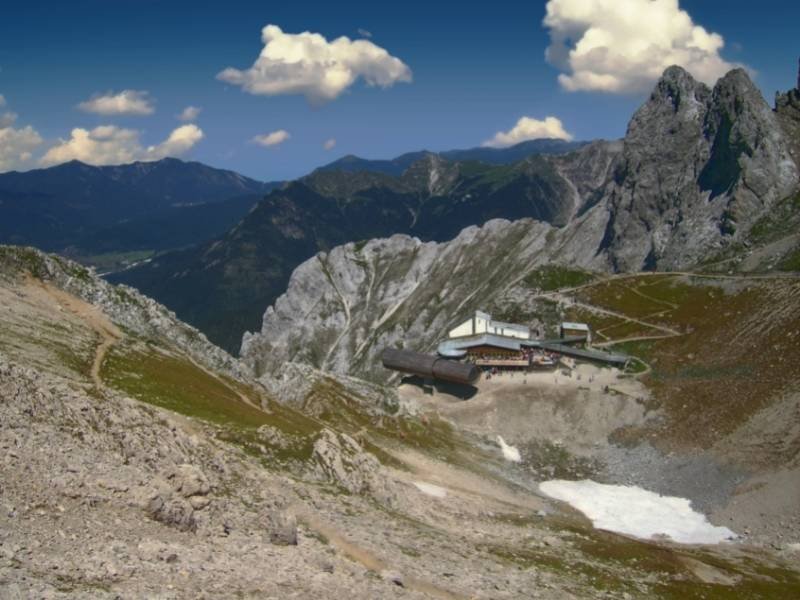
While Mittenwald may not boast views as grand as those in Berchtesgaden, it is home to the Dammkar Ski Route. This is one of Germany’s most exciting adventures and offers some of the best slopes in the Alps. It’s a dream come true for off-piste skiing enthusiasts.
The Dammkar Ski Route stretches over 7 kilometers, descending 1300 meters from Karwendel to Mittenwald. Along this route, you’ll encounter firm, powdery snow interspersed with slushy mogul fields. It’s the perfect playground for skiing aficionados!
Before you even begin your journey on the Dammkar Ski Route, there are exciting things to explore. The top station of the Karwendelbahn cable car, your gateway to Dammkar, is designed like a giant telescope overlooking the valley below. Adjacent to the top station, you’ll find an easy hiking trail offering views of the Northern Limestone Alps’ cirques.
Don’t forget to stop by the restaurant at the top station. Here, you can enjoy a meal or a beer on the sunny terrace, feasting your eyes on the stunning panorama as you satisfy your hunger.
Visiting information: karwendelbahn.de

Near Mittenwald, you’ll find another must-visit destination known for its record-breaking length. This is the Leutasch Gorge, the longest accessible gorge in the Eastern Limestone Alps.
The gorge is also referred to as the spirit gorge due to local myths that suggest it’s home to goblins and other supernatural beings. As you traverse the gorge, you’ll have the opportunity to face your fear of heights. This is thanks to the meshed steel pathways that offer views of the ground tens of meters below you.
These steel pathways, which are attached to the limestone walls of the gorge, lead you to the most breathtaking spots in the Leutasch Gorge. Here, you’ll encounter narrow rivers, views of the mountains nestled between giant rocks, and much more.
You will need at least two hours to visit every part of Leutasch gorge:
- Klammgeistweg – the place where you will learn the gorge’s myths, geology, and ecology.
- Koboldpfad – More exciting and trilling pathways
- Wasserfallsteig – The gem at the end of the gorge, a gorgeous waterfalls 23 meters high.
Visiting information: seefeld.com
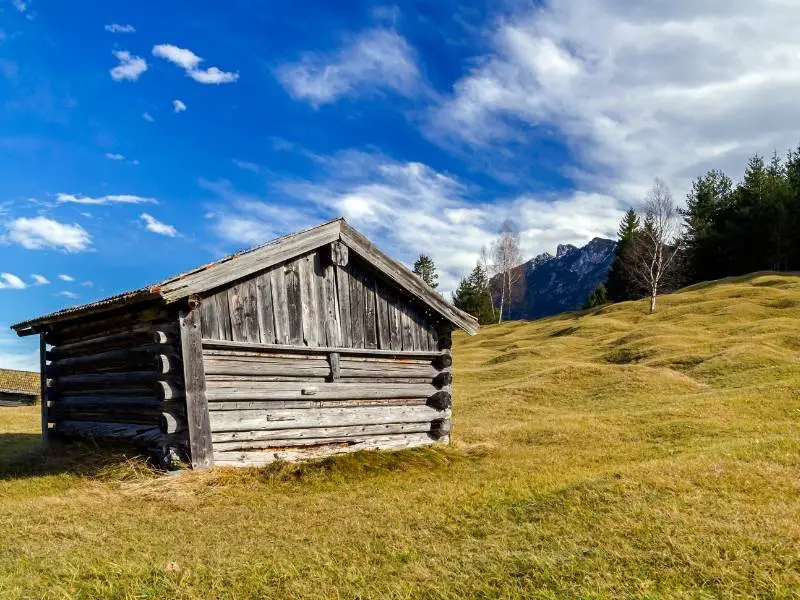
Mittenwald’s Hummock Meadows, or Buckelwiesen, is a unique and rare sight in the Bavarian Alps. This meadow is characterized by thousands of lumps and bumps, creating a whimsical, otherworldly landscape. The play of light and shadow during the golden hour, when the sun is at a low angle, accentuates these features, making them even more pronounced.
These meadows are scattered throughout Mittenwald. One can be found to the north of Lautersee, near a picturesque chapel, while another lies next to the Kranzberg Gipfel-Huette. While you can drive to these locations, exploring them on foot or by bicycle allows for a more intimate experience. As you travel, you’ll be treated to the charming scenery of the German countryside.
The Hummock Meadows are meticulously maintained and preserved by local farmers. Their efforts have not gone unnoticed – the Buckelwiesen has been recognized with awards in the past, including a diploma for conservation from the European Heritage Europa Nostra Awards.
Garmisch-Partenkirchen

Let’s turn our attention to Garmisch-Partenkirchen, the largest town in the Bavarian Alps. This town has some interesting history, having hosted the Winter Olympics in 1936 — an event that marked the unification of the towns of Garmisch and Partenkirchen under Adolf Hitler’s regime.
Today, Garmisch-Partenkirchen, often referred to as GaPa, is a premier destination in the Bavarian Alps. It offers a wide range of activities for visitors. Whether you’re looking for serene lakes, towering peaks, hiking trails, shopping opportunities, charming streets, or delicious Bavarian cuisine, GaPa has it all. It truly is the ultimate destination in the region.
That’s not to say other towns don’t have their own unique attractions. But in Garmisch-Partenkirchen, you’ll find numerous vantage points for breathtaking views. One such spot is Alpspix, an observation deck that juts out from a cliff near Alpspitze. From here, you can take in the stunning panorama of GaPa nestled in the valley, surrounded by mountains and verdant fields.
Among the towns nestled in the Bavarian Alps, Garmisch-Partenkirchen boasts the most diverse range of activities. My article about GaPa (link is found later) provides a thorough rundown of the attractions and activities available. Yet, if I had to choose, these would be my top three picks:
- Olympia-Skistadion Ski Jump
Wondering how long to stay in Garmisch-Partenkirchen? Given the size of the town and the abundance of attractions, a stay of 2 to 3 days is generally recommended. This should give you ample time to explore all that the town has to offer.
However, if you’re planning to take advantage of the hiking trails, visit the picturesque lakes, explore the idyllic hamlets, and take in the stunning viewpoints around the town, you might find yourself wanting to extend your stay. Indeed, the beauty and charm of Garmisch-Partenkirchen could easily entice you to linger for much longer.
To truly appreciate Garmisch-Partenkirchen, make the most of your visit by exploring not just the top attractions around the village, but also its hidden gems. You can find more details about these lesser-known spots in my post titled ‘ Why Garmisch-Partenkirchen is worth visiting .’

Garmisch-Partenkirchen, or GaPa, serves as the gateway to Zugspitze, Germany’s tallest mountain. The peak of Zugspitze reaches an impressive 2,962 meters (9717 feet) above sea level.
Visitors flock to the top of Zugspitze for the vantage point, which offers panoramic views extending from Germany to Austria and Switzerland. On clear days, you can even see as far as the mountain ranges in northern Italy.
Like many other renowned peaks in the Alps, Zugspitze is serviced by a cable car. While this service comes at a cost, it saves you the effort of hiking to the summit. The cable car journey to the top of Zugspitze is an experience in itself, traversing the world’s highest steelwork pylon, which stands at 127 meters tall. It also boasts the world’s most significant overall height difference for a cable car, at 1945 meters. This journey will have you soaring skyward, more than twice the height of the world’s tallest building, in just a matter of minutes!
Once you reach the summit, the incredible views are not the only thing to enjoy. You’ll also find Germany’s highest beer garden, where you can savor the beauty of the mountains while satisfying your appetite.
Visiting information: zugspitze.de
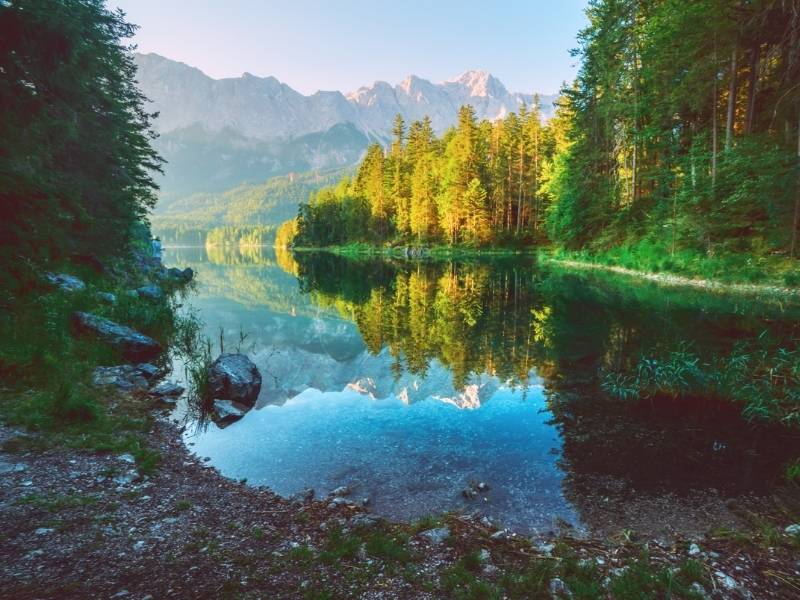
Near Eibsee, a lake located in Grainau, there’s a cable car station that will take you to the summit of Zugspitze. But before you embark on this journey, take some time to explore the lake.
Eibsee offers some of the best views of the Bavarian Alps, easily accessible from Garmisch-Partenkirchen. It’s a favorite among photographers. On calm days, when the surface of Eibsee is undisturbed, it serves as a giant mirror, reflecting Zugspitze and the surrounding peaks. This creates a stunning scene that is sure to garner likes on Instagram.
At times, Eibsee transforms into a magical lake, appearing misty and enchanting. Once the mist clears, you can rent kayaks and boats from nearby shops. Drift in the crystal clear water of Eibsee and visit the tiny islets scattered across the lake.
If you visit Eibsee during the less crowded season, you’ll find it incredibly peaceful. If you’re seeking a soothing retreat or a place to calm your mind, Eibsee is a “must include” in your Bavarian Alps itinerary.
Visiting Information: eibsee.de
Olympia-Skistadion Sprungschanze

While I may not be an Olympics enthusiast, the Olympia-Skistadion Sprungschanze in Garmisch-Partenkirchen is a reason to visit this town. It’s a unique attraction, and if you’re fortunate, you might even catch a glimpse of a ski-jumping athlete soaring through the air during your visit to GaPa!
I’ve never seen ski jump athletes in person, but watching videos of their performances on YouTube always leaves me in awe. The stadium is open to the public when there are no events taking place. If you’re interested in trying it out, you can register and request permission at the Garmisch-Partenkirchen tourism office.
In addition to the ski jump, Garmisch-Partenkirchen is also home to the Olympic Bobsleigh Run. This is where athletes once glided along curvy paths at speeds of up to 140 kph! However, it’s worth noting that the run is no longer open for public use as efforts are being made to preserve this historic landmark.
Visiting information: gapa-tourismus.de
Oberammergau
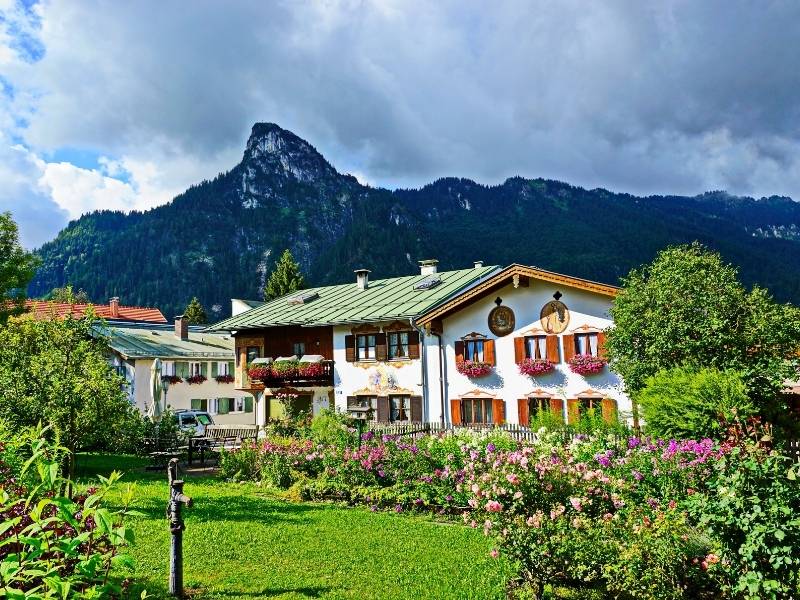
Oberammergau, nestled in the Bavarian Alps, offers a unique experience unlike any other town in the region. While it may not boast towering mountains, picturesque lakes, or fascinating gorges, it shines in its own right through its rich culture and tradition.
Known globally, particularly in the Christian West, Oberammergau is considered a must-visit destination in Germany due to its Passion Play. This event originated from a promise made by the villagers to God over 400 years ago. They vowed to perform the Passion Play every 10 years if they were spared from a plague. Miraculously, after making this promise, the villagers were indeed spared from the disease.
What’s truly inspiring is that the villagers of Oberammergau have remained steadfast in their commitment, even after centuries have passed. The Passion Play involves more than 2000 villagers participating in the re-enactment of the Passion of Christ. It’s a once-in-a-lifetime event that you’d be honored to witness.
But don’t worry if your visit to Oberammergau doesn’t coincide with the premiere of the Passion Play. The town is home to beautiful Lüftlmalerei and peaceful countryside vistas that are a feast for the eyes. Additionally, Oberammergau’s wood carving tradition is sure to fascinate you.
Even when the Passion Play isn’t taking place, Oberammergau has plenty to offer. Here are some attractions you can explore right away if you decide to stay in Oberammergau:
It’s worth noting that Ettal Abbey and Linderhof Palace make for excellent side trips from Garmisch-Partenkirchen. However, these attractions are much closer and more easily accessible from Oberammergau.
Let’s delve into each tourist attraction. But first, let’s address the question: how much time do you need in Oberammergau?
A single day in Oberammergau is sufficient to experience all the highlights of a visit to the village. In one day, you can explore the town, admire the beautiful Lüftlmalerei, watch the Passion Play (if it’s the 10th year), and enjoy the alpine coaster. If you plan to visit Ettal Abbey and Linderhof Palace, you’ll need to allocate an additional day.
To discover more about what the unique village of Oberammergau has to offer, I recommend reading my post, ‘ Reasons to Visit Oberammergau .’
Oberammergau’s Alpine Coaster
While many believe that Oberammergau is only worth visiting during the premiere of its Passion Play, there’s a compelling reason to visit even during ordinary times. The world’s longest weatherproof toboggan run with magnetic brakes is located right here in Oberammergau!
This thrilling ride stretches over a length of 2600 meters, starting from a mountain near the town and covering a 400-meter altitude difference from the top. As you make your way down the track, you’ll experience 73 alpine coaster turns, 9 jumps, and 7 waves, all while speeding down the slopes at 40kph!
Oberammergau is full of surprises, and this fun-filled adventure is one of them. The experience is even more enjoyable during good weather, as the views from the alpine coaster are simply breathtaking.
Visiting information : kolbensattel.de
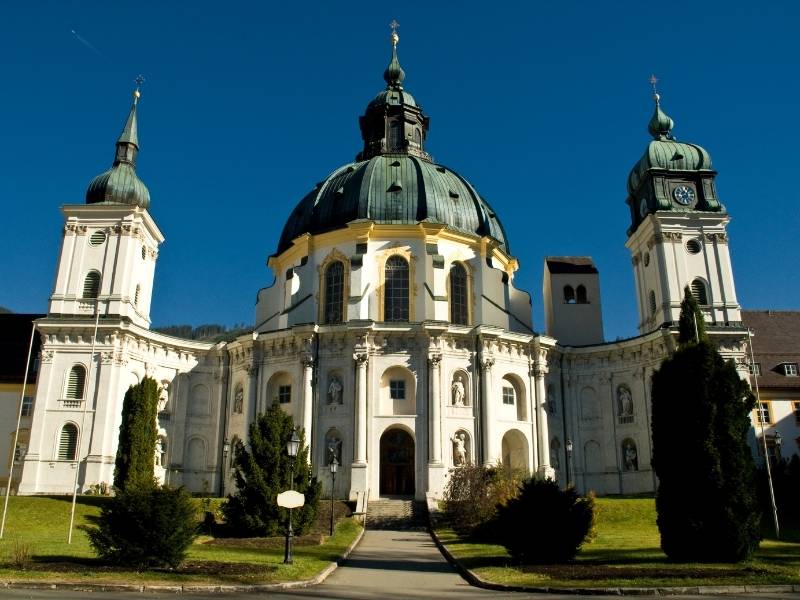
Ettal, a quaint village south of Oberammergau, is home to two architectural gems of the Bavarian Alps: Ettal Abbey and Linderhof Palace. Both attractions are just a short drive from Oberammergau, reachable within 20 minutes.
Ettal Abbey, the closer of the two, is a 14th-century Benedictine monastery that houses a brewery, hotel, and show dairy. The Abbey boasts an impressive dome adorned with mesmerizing frescoes. These captivating paintings could hold your gaze indefinitely! But be careful, you might end up with a stiff neck from looking up for too long. Just kidding!
Visiting information : klosterhotel-ettal.de
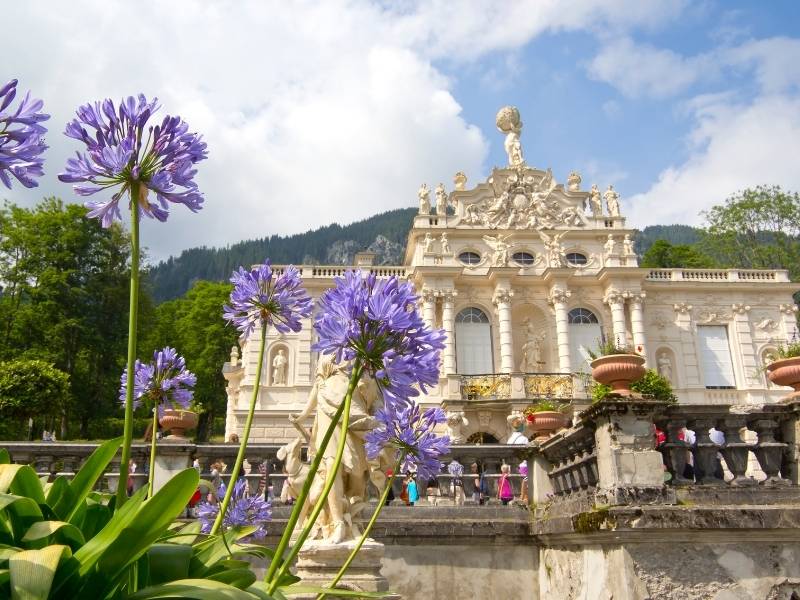
Linderhof Palace is nestled in the west of Ettal Abbey, a mere 15 to 20 minutes from Oberammergau. This palace is one of the three that King Ludwig II commissioned, and it stands out as the only one he lived to see finished. The interiors are a sight to behold, adorned with an impressive rococo design. Unfortunately, visitors are not permitted to capture this beauty in photographs.
The palace is complemented by a charming garden, which showcases a blend of architectural styles, including baroque and renaissance. As you wander through the garden, the ornate decorations, lush plants, and statues might make you feel like royalty enjoying a leisurely stroll.
While the main palace is compact, it is surrounded by other attractions that are equally pleasing to the eye. These additional features display a variety of cultures and architectural styles from diverse regions. The names of these attractions within Linderhof Palace give a hint of their inspirations.
- Venus Grotto
- Hunding’s Hut
- Gurnemanz Hermitage
- Moorish Kiosk
- Moroccan House
Visiting information : schlosslinderhof.de
Hohenschwangau
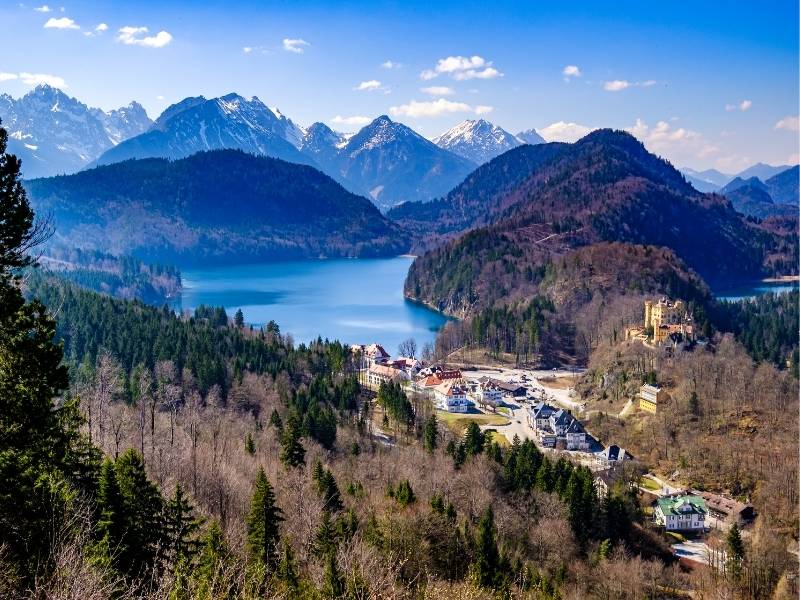
Hohenschwangau, the residence of King Ludwig II, is a must-visit destination nestled in the Bavarian Alps. Originally a small village within the Schwangau municipality, it transformed into a bustling urban district following the construction and subsequent popularity of Neuschwanstein Castle during the 19th and 20th centuries.
Today, Hohenschwangau welcomes approximately 2 million tourists and travelers each year. Its location on the northern edge of the Alps offers visitors breathtaking scenic views and the chance to explore fairytale-like castles perched atop the hills.
Here are the highlights of your visit to Hohenschwangau:
Wondering how long to stay in Hohenschwangau? Typically, a single day in Hohenschwangau is sufficient. It’s even possible to do a day tour if you’re coming from nearby cities or towns, especially if your main focus is visiting the Neuschwanstein and Hohenschwangau castles.
However, to make the most of your visit, it’s advisable to visit the castles early in the morning or later in the afternoon. This strategy helps avoid the crowds and enhances the magical experience of the town.
For a deeper familiarity of Hohenschwangau, I invite you to read my detailed post on its crown jewel, Neuschwanstein Castle . This article not only delves into the castle itself but also explores nearby attractions such as Hohenschwangau Castle and Alpsee.

Neuschwanstein Castle is undeniably the primary attraction drawing millions to Hohenschwangau. This fairytale castle was the brainchild of the “fairytale king,” Ludwig II, who tragically passed away before witnessing the completion of his magnificent creation.
As quoted from discovery.com , “While Ludwig’s story doesn’t have a happy ending, his castles inspired a man known for crafting happy endings: Walt Disney. Sleeping Beauty’s Castle was inspired by Ludwig’s Neuschwanstein, as was Cinderella’s Castle.” It’s clear that Neuschwanstein Castle has not only inspired one individual but countless others.
Throughout the years, the castle has received numerous comments filled with awe and admiration. It’s easy to see why, given that it’s a real castle built by a real royal.
To truly appreciate the castle, you must join a 30-minute tour (tickets tend to sell out quickly during the summer). The real highlight, though, are the viewpoints of Neuschwanstein Castle. From here, you can fully appreciate the castle’s grandeur and its picturesque surroundings. It’s a once-in-a-lifetime experience, especially for those of us not native to Europe.
Visiting information : hohenschwangau.de

On the other side of the village, you’ll find Hohenschwangau Castle, which was once the home of King Ludwig II. This castle, perched on a small hill and painted yellow, can be spotted from the balcony of Neuschwanstein Castle.
Hohenschwangau Castle was originally built in the 12th century. However, it has been destroyed, reconstructed, and improved numerous times over the centuries. The final touches on the castle were made by King Maximillian II, the father of King Ludwig II.
While it may not be as grand as Neuschwanstein, the interiors of Hohenschwangau Castle are fascinating, adorned with paintings that weave together a series of stories. From the outside of this castle, your view of Neuschwanstein Castle may be obscured by trees. However, you’ll have a clear view of Lake Alpsee from the castle’s gardens.
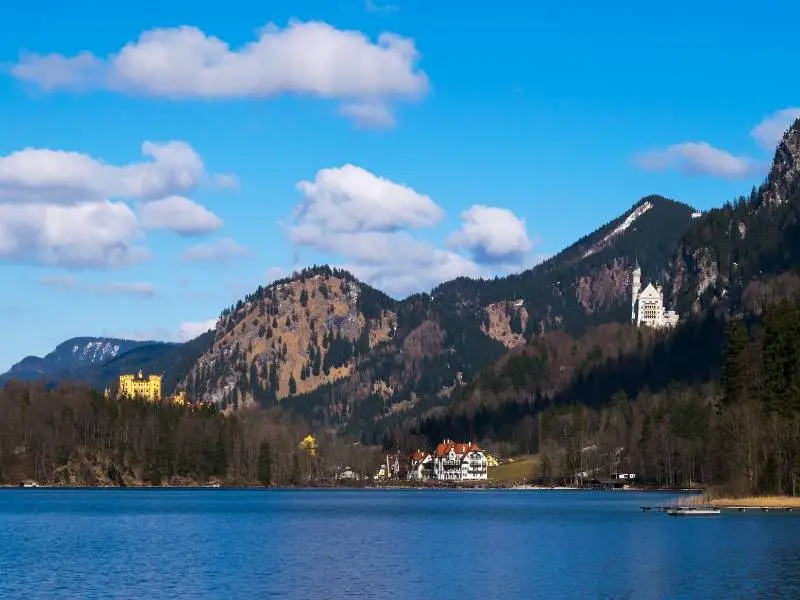
Alpsee is the ideal location if you wish to capture both Neuschwanstein and Hohenschwangau castles in a single frame. You have the option to rent a boat for the perfect vantage point or take a leisurely hike around the lake.
As you explore the area, you may come across charming wild swans gliding gracefully on the glittering water. The lake features a circular path for those who prefer a relaxed stroll. For the more adventurous, there are longer hiking trails available. Regardless of your choice, Alpsee promises a tranquil and soothing experience, offering a welcome respite from the bustling crowds.
Visiting Bavarian Alps: Plan Your Trip
Now that we’ve gone through the various towns and attractions in the Bavarian Alps, you should have a good idea of how to spend your time in this amazing region. Also, you’ve probably already decided which places you want to visit this time and which ones you’ll save for your next trip.
To help you plan your journey, I’ll provide you with some tables that show the distances between each town in the Bavarian Alps. Specifically, they are:
- Road distance and travel duration between towns in the Bavarian Alps
- Commute information and travel duration between towns in the Bavarian Alps
I’ll also provide information about:
- Road distance and travel duration from cities with airports to towns in Bavarian Alps
- Commuting information and travel duration from cities with airports to towns in Bavarian Alps
The tables I’ll show you provide the following information: road distance, travel duration using a car, commuting complexity, and travel duration using public transportation .
- The “ road distance ” data in the tables I’ll provide can help you estimate costs for mileage, fuel, or car rental, should you choose to drive or hire a vehicle.
- The “ travel duration using a car ” information can assist you in managing your time efficiently, allowing you to plan when to depart from one location to arrive on time at your next destination.
- The tables also indicate the “ commuting complexity ,” which shows how many transfers are required to reach the next destination. Locations requiring multiple transfers often become a lower priority to avoid the hassle of purchasing multiple tickets and potentially incurring additional expenses, unless you opt for unlimited public transit passes.
- Lastly, the tables provide an estimate of the “ travel duration using public transportation .” This is particularly useful if you plan to use public transport and have tours or bookings at specific times. By allowing ample time for your commute and coordinating it with your tour bookings, you can avoid the stress of missing your schedule.
- The data from the tables are from Rome2Rio and Google Maps Schedule Explorer.
- Before you use the data to plan your itinerary, it’s important to consider the traffic situation at the time of your travel, especially if you’ll be traveling by car.
- The travel duration using public transportation, as shown in the tables, includes the time between transfers. These are the fastest estimates and are intended to give you an idea of how long you’ll be in transit.
- If you’re using public transportation, consider downloading the DB Navigator app for your Android or iPhone. This app provides train and bus journey information, helps you find the cheapest tickets, enables quick booking, and provides exact transit schedules.
Road Distance and Travel Duration Between Bavarian Alps Towns
From the information in the tables below, you can gauge the distance you’ll need to drive to reach your next stop and the duration of your journey.
Commute and Travel Time between towns in the Bavarian Alps
The tables below provide a clear picture of your commute. They show the number of transfers you’ll need to make, as well as the number of train or bus rides you’ll take. For instance, if you have 3 train rides, that means you’ll make 2 transfers. They also give an estimate of the total time you’ll spend commuting.
How do I get to Bavarian Alps?
Now, let’s discuss how you can reach any of the towns in the Bavarian Alps.
There are many routes to the Bavarian Alps. You can start from anywhere in Germany or even from nearby countries. Thanks to technology, traveling from one place to another in Western Europe has never been easier. As long as you know how to use basic travel smartphone applications, you will never be lost.
You can download the most essential apps for traveling in Germany and the Bavarian Alps from the provided link.
- DB Navigator [ AppStore | PlayStore ] – For booking public transportation, finding schedules, real-time information, coach sequence, cheap deals, and so much more!
- Google Maps [ AppStore | PlayStore ] – For navigating with your car, finding the best route, and searching for train/bus schedules.
Google Maps alone is sufficient for our navigation, even using public transportation.
With the current tech we have now, regardless of whether you want to drive or use the trains, you no longer have to memorize streets, stations, and so much more just to get to the place you want to visit.
This is why I will no longer give you the exact steps of which street to turn to, which train line to ride on, and so on. Instead, I will provide more tables showing you how far the Bavarian Alps are from where you plan to start your journey. Using the tables:
- You can assess which destination in the Bavarian Alps is nearest to where you are coming from.
- If you’re coming from overseas, you can select which airport you would want to use for arrival in Germany or Europe, considering the Bavarian Alps as your primary destination.
- You can get an idea of which city to visit next after touring the Bavarian Alps.
- In some cases, you will also know which city you can use as your home base.
Cities and Airports Near Bavarian Alps
Here is the list of cities with airports near the Bavarian Alps that we can select for your arrival. These cities are in on this list because:
- You can reach the Bavarian Alps in less than 4 hours of driving from these cities. We don’t want to drive for more than half a day!
- You can use a public transport route from these cities to get to the Bavarian Alps in a shorter duration than taking another flight to a nearer city. In other words, land travel to the Bavarian Alps from these cities takes less time than air travel. Please note that the air travel time estimate includes the actual flight time, time spent during check-in, and time spent during the security check.
Driving Distance (Cities/Airports to towns in Bavarian Alps)
Commuting Distance (Cities/Airports to towns in Bavarian Alps)
Here is an example of how the table can assist you.
Let’s say you found two flights to Germany. One is going to Frankfurt, and another is heading to Munich. The flights to Frankfurt are on sale and therefore cheaper, while the flights to Munich are at regular prices. You should choose the cheaper flight, right? Not so fast. You must also consider the land travel between Frankfurt and your destination in the Bavarian Alps. Now we choose:
- Should I take the cheaper flight but spend more hours on the road? This would mean more expenses for fuel or a train ride.
- Or should I take the flights to Munich? Here, we don’t care if it’s more expensive as long as I get to the Bavarian Alps in no time.
Public Transportation or Private Car?
Now that you know the attractions and towns to visit in the Bavarian Alps and the cities close to the Bavarian Alps where you can start your trip, the next question is: What’s the best mode of transport in the Bavarian Alps – train, bus, or private car?
Public transportation in the Bavarian Alps is generally efficient and convenient. There’s no real need to rent a car, particularly if you’re just going to the main attractions. A private vehicle might only be necessary if you need to get to a remote location quickly or if you want more freedom during your trip.
Best Time to Visit Bavarian Alps
Before you book your plane or train to the Bavarian Alps, make sure you are coming at the right time! Well, it’s actually hard to say when you should visit the Bavarian Alps because it’ll all depend on what kind of activities you want to experience.
But as a rule of thumb, if you want to see all the highlights of the Bavarian Alps, including the towns and the tourist attractions around Garmisch-Partenkirchen, Mittenwald, Oberammergau, Berchtesgaden, and Hohenschwangau, the best time to visit the Bavarian Alps is during the summer.
Summer is the time of the year when most tourist attractions are open to travelers, it’s not so chilly to do outdoor adventures, and different cultural festivals are taking place. It’s time to fully experience the Bavarian Alps!
However, because everyone is coming to the Bavarian Alps during this time, you must expect longer lines at the top tourist attractions, especially at Neuschwanstein Castle! The parking could be terrible, too, during this season so be prepared if you plan to travel by car.
Another nice thing about summer is that the length of the day is longer, giving you more opportunity to have more experiences to try and places to explore per day. Like, at the peak of the summer, the sun is up in the sky until 9:00 pm. I have to admit, as someone from the equator, I was amazed to see the sun set that late!
If you want a quieter visit to the Bavarian Alps and you want to see the mountains and lake at their most spectacular appearance, try visiting the Bavarian Alps during the Autumn (late September). Especially, Konigssee and Eibsee, during autumn, they’re the places where you can spend half a day boating or hiking, taking pictures with the stunning fall foliage trees reflected on the surface of the lake.
How Many Days in Bavarian Alps
So, you’ve decided to visit the Bavarian Alps? That’s fantastic! Now, you might be wondering how many days you would need to fully enjoy the Bavarian Alps.
If you want to see everything from Neuschwanstein to Berchtesgaden — essentially, the entire Bavarian Alps — you’ll need about 10 days. If you’re looking for a more leisurely pace and want to engage in more outdoor activities, you might want to extend your trip to two weeks or 14 days.
However, if you’re pressed for time, a week would be sufficient, although you might not be able to see every highlight of the Bavarian Alps. Here’s a suggestion for a 7-day itinerary: start in Munich and take a day trip to Neuschwanstein Castle. Then, move on to Garmisch-Partenkirchen or Mittenwald and spend 4 days exploring the towns and surrounding areas. Be sure to visit Zugspitze, Eibsee, and Linderhof Palace.
From your base in Garmisch-Partenkirchen, consider a day trip to Oberammergau and visit Ettal Abbey to add a cultural element to your trip. That brings us to six days. On the last day of your trip, you could go shopping for souvenirs or relax at a spa or take a scenic drive around the area.
Even if you’re only planning a weekend trip or a 3-day stay, you can still enjoy the Bavarian Alps. A quick trip to Berchtesgaden offers various attractions that provide a well-rounded experience of the Bavarian Alps in just a few days. Within three days in Berchtesgaden, you can visit Konigssee, Jenner, Rothbach Waterfall, Eagle’s Nest, and Salt Mine, and still have a few hours left for relaxation and culinary adventures.
So, after all that, the simple answer to the question ‘how many days in the Bavarian Alps’ is: it can range from 3 days to 14 days, depending on your preferences. The minimum is 3 days to truly enjoy and feel that you’ve seen the best of the Bavarian Alps.
Here’s where you can find the best hotel deals in Bavarian Alps.
Where to Go Next After Bavarian Alps
The Bavarian Alps in Germany can already provide a satisfying trip for those bitten by the travel bug. However, if it’s your first time in Germany, you might want to consider adding other destinations to your itinerary to make your trip even more worthwhile. As I mentioned earlier, there’s so much to see, from fairytale-like medieval villages to some of the coolest car museums in Europe.
The best part is that you don’t have to leave Southern Germany to experience some of the top attractions in the country. These destinations are easily accessible, even if you’re traveling using public transportation. Take Munich , for example. In just an hour or two, you can reach this wonderful city from any town in the Bavarian Alps, especially if you have a car.
From Munich, you can practically travel anywhere in Southern Germany, even without a car. Munich is just a train ride away from Wurzburg , Bamberg , Nuremberg , Stuttgart , and more. From these cities, you can reach even more amazing destinations with just another train ride. These include the Black Forest , Lichtenstein Castle , and Rothenburg ob der Tauber . You see, there are many!
These places I’ve mentioned are some of the must-see locations in Southern Germany . They offer some of the most unique and amazing experiences in the country.
Bavarian Alps vs Other Similar Destinations
If you love having more mountain adventures in Europe, there are more places you can visit after the Bavarian Alps. My top picks are in Italy, France, and of course, Switzerland.
In Italy, consider visiting Cortina d’Ampezzo . This town is at the heart of the spectacular Italian Dolomites, where some of the most stunning rock formations and crystal-clear mirror-like lakes can be found.
In France, check out Chamonix . This town is at the foot of the highest peak in all of the Alps — Mont Blanc. The town has a lot to offer, from mountain top festivals to an alpine animal park and walking inside a glacier.
In Switzerland, there are plenty of places you can visit. Switzerland has many beautiful villages and amazing cities near the Alps . However, my top picks are Interlaken , the adventure capital, and Zermatt , the place with the best views of the Matterhorn .
Save it on Pinterest .

Similar Posts
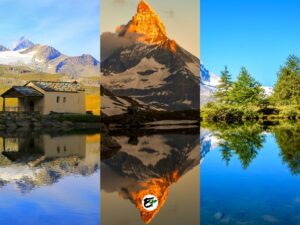
What to Expect from Zermatt: 10 Epic Highlights of This Town
Ever wondered about the majestic mountain that graces the Toblerone box? It’s none other than the iconic Matterhorn, nestled in the heart of Zermatt. This is scenic mountain town, beckons travelers from around the globe for different reasons. Not only is Zermatt one of the world’s premier destinations for skiing and hiking, but it also…
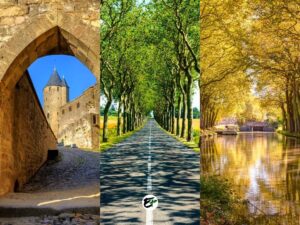
Carcassonne is Worth Visiting: Guide to Top 10 Experiences
Carcassonne is undoubtedly the best destination for those seeking the ultimate medieval experience in the South of France. Founded by the Visigoths in the 5th century, this town boasts a preserved medieval citadel, considered one of the most beautiful villages in the country. With its unique two-layer medieval fortifications in the Cité de Carcassonne and…
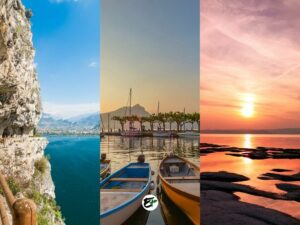
Why Lake Garda is a Must-Visit: An In-Depth Travel Guide
The minute I stumbled across Lake Garda on the map, it was immediately clear to me that I had found another one of Italy’s most stunning destinations. Tucked away between the breathtaking Italian Alps and beautiful Italian cities, I could already picture a memorable journey that’s a blend of history and awe-inspiring scenery. But I…
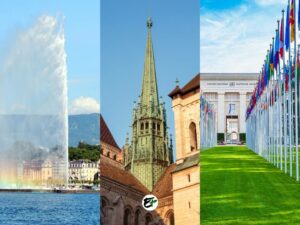
Is Geneva Worth Visiting: A Guide to Its 10 Best Experiences
Wondering if Geneva, the second-largest city in Switzerland, is worth your time? Known as the ‘Peace Capital’ of the world, Geneva is home to numerous international organizations, including the United Nations and the Red Cross, with a total of 39 international organizations based in the city. Geneva is definitely worth a visit for its unique…
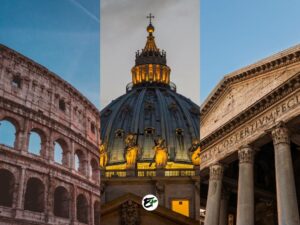
10 Beautiful Landmarks That Make Rome a Beautiful City
Let’s talk about Rome, Italy’s capital. This city is one of the oldest in the world, with its establishment dating back almost 2800 years. It ranks as the second most visited city in Europe, boasting more than 10 million visitors each year. Interestingly, this number is more than double the city’s population! And when you…
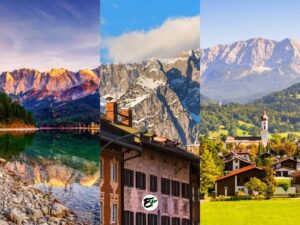
A Guide to Garmisch-Partenkirchen: 10 Worthwhile Experiences
In my opinion, a trip to Bavaria isn’t complete without a detour to the Bavarian Alps. This place is a gem, not just in Bavaria, but in all of Germany. Missing it would be a significant oversight. Although the Bavarian Alps constitute just a small part of the country, they are home to many stunning…
Leave a Reply Cancel reply
Your email address will not be published. Required fields are marked *
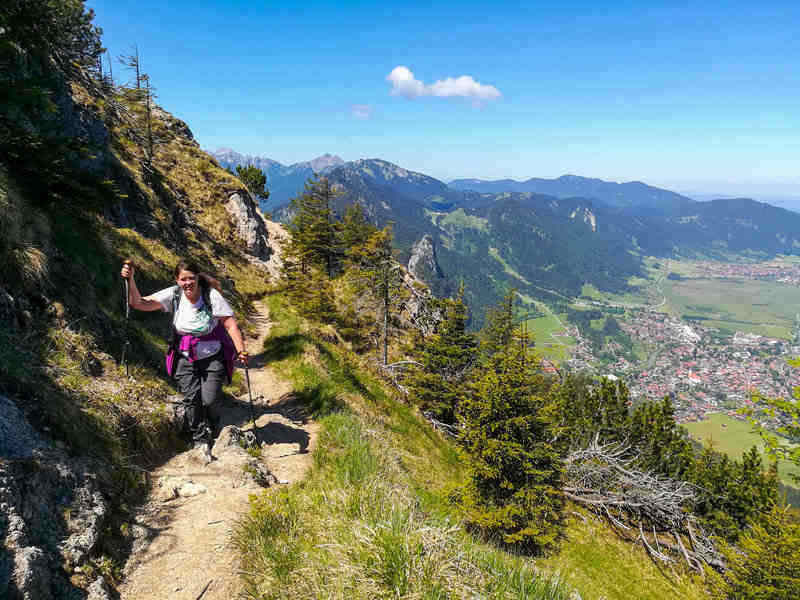
The German Alps: 3 Best Places to Hike and 5 Day Tours That You’ll Love
The bavarian alps in germany offers hiking and adventure for all levels, plus the unbelievably majestic king ludwig ii’s castles set with mountain backdrops..
Below you’ll find everything from one-day tour recommendations, to my top three recommendations of where to stay if you plan on hiking and have a few days or longer that showcase the best of the Bavarian Alps.

Top 1-Day Tour Recommendations for the Bavarian Alps in Germany
If you’ve only got limited time and are staying in Munich , here are my top 5 tour recommendations for day trips to the Bavarian Alps. They make it super easy and convenient for you to explore my favourite part of Germany:
Zugspitze: Visit Germany’s Highest Peak.
It takes one very long or two days to hike the highest mountain in Germany. Fortunately, if that’s too intense, you can still reach the 2962 meter mountain peak by cable car. Enjoy a beer at Germany’s highest beer garden. This tour includes pickup from your hotel in Munich.
Partnachklamm – Visit one of the most beautiful gorges in all of Germany.
On this day trip from Munich, you’ll walk alongside a raging river and majestical waterfalls. It’s one of my favorite hikes in the entire Alps. The dramatic scenery far surpasses the effort. You’ll eat lunch at a mountain hut. Something every traveler to Bavaria should do to experience traditional Bavarian-style hospitality and unique alpine culture.
Eagle’s Nest – Visit Hitler’s Mountain Retreat.
This tour offers something for both history buffs and nature lovers. You’ll leave from Munich and travel on one of the most scenic roads in the German Alps to Berchtesgaden. One of only two national parks in Bavaria. The panoramic vistas of alpine peaks are among the most dramatic in the country. I’m a huge fan of Berchtesgaden!
Try a boat ride on the Königsee and discover the salt mines.
Take a day trip from Munich to discover the beautiful Königssee. You’ll enjoy the unique pleasure of listening to an echo show where a musician will use the lake’s echo to create musical effects. Then, you’ll explore Bartholomä island before heading on to the salt mines of Berchtesgaden to see the mysterious glowing salt grottoes.
Take a day trip to see Neuschwanstein and Linderhof Castles
Enjoy a luxury trip to two of King Ludwig II’s famous castles. This King of Bavaria is well-known for building beautiful and luxurious castles. Make a stop in Hohenschwangau where King Ludwig grew up and enjoy a detour in Oberammergau. These castles are set in two different and stunning locations in the German Alps and this tour will give you an opportunity to see the subtle changes of the landscape.
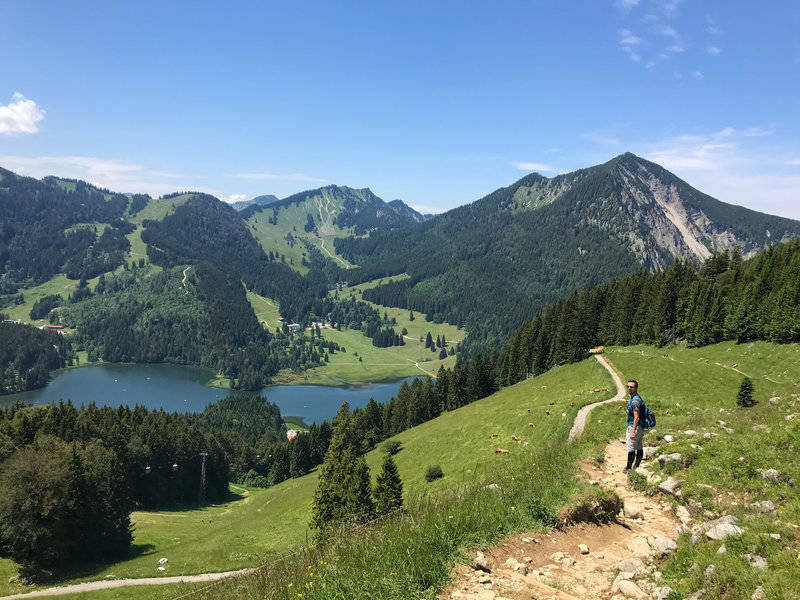
Where To Stay in the German Alps When You Want to Hike and Have a Few Days or Longer
It’s definitely worth spending at least a few days, or even a week or longer in the German Alps. Here are my top three recommendations of where to go for what I think is the most stunning scenery in Bavaria, especially if you plan to hike.
Berchtesgaden National Park
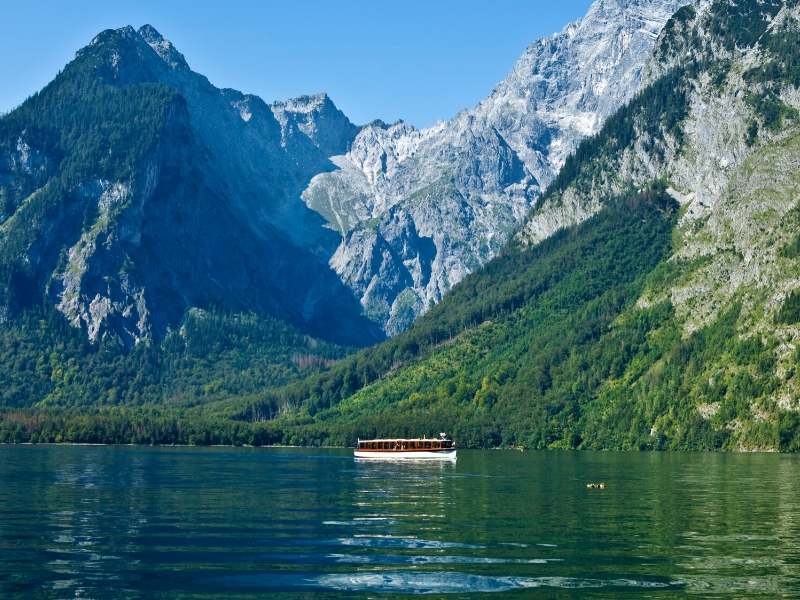
This is one of only two national parks in Bavaria and is home to the famed Lake Königssee. This is a great choice if you’re seeking stunning Alpine scenery, want to be around one of the most beautiful lakes in Germany and a variety of hiking trails from very easy to more advanced hikes.
What To Do in Berchtesgaden
You’ll definitely want to take a boat ride across the lake to St. Bartholomew, visit the Eagles Nest for a breathtaking panoramic view of Hitler’s mountain retreat. You’ll find lots of hiking trails and could easily spend several days here or even up to a week.
Where To Stay in Berchtesgaden
Most of the accommodations are in smaller family-run places called “Ferienwohnungen” (vacation apartments). See VRBO vacation rentals in Berchtesgaden National Park where you’ll find many “Ferienwohnungen”. Airbnb is usually my top choice for stays of 2 or more nights or if I’m travelling with a small group of friends. Or, if you’d rather stay in a guesthouse, check out our two top recommendations below:
Gästehaus Bergwald
Located in Berchtesgaden, the Gästehaus Bergwald offers you charming accommodation with well-equipped rooms, stunning mountain views and friendly staff.
Gästehaus Sägfeiler
Surrounded by panoramic views of the Berchtesgaden Alps, the Gästehaus Sägfeiler offers comfortable traditional Bavarian accommodation.
Garmisch-Partenkirchen

Garmisch-Partenkirchen is one of my favourite places in the German Alps. It’s a great place to base yourself if you’re looking to stay in a larger town. It also some of the most spectacular hiking in the Bavarian Alps including the difficult hike up to the Zugspitze, the highest mountain in Germany. You can also reach it by cable car.
What To Do in Garmisch-Partenkirchen
Explore the charming town of Garmisch-Partenkirchen, which was previously two separate towns. I’d also recommend checking out nearby Mittenwald. It’s
known for its colourful painted houses and violin making which dates back hundreds of years. It’s just a short train ride away and offers spectacular views of the German and Austrian Alps.
One of my favourite easy day hikes in all of the Bavarian Alps is in Garmisch-Partenkirchen, the Höllentallklamm (Hell Valley Gorge) (mentioned below) at the foot of the Zugspitze, and a circular hike up through the Partnachklamm with lunch at one of the restaurants or huts. It’s one of the best hikes in Germany where the scenery far surpasses the easy hiking.
Mittenwald also offers some spectacular hiking. A great easy hike in Mittenwald is the Hoher Kranzberg. It’s a circular loop that passes two lakes, so be sure to bring your bathing suit. If you like skiing, Garmisch-Partnekichen by far offers the best skiing in all of Germany in my opinion.
Where To Stay in Garmisch-Partenkirchen
I think the best places to stay in Garmisch-Partenkirchen are also Ferienwohunungen (vacation apartments). See vacation rentals in Garmisch-Partenkirchen to find one that’s right for you.
Or check out one of these traditional Bavarian guest houses.
Gästehaus Maria
With its traditional Bavarian decor and charm, the family-run hotel, Gästehaus Maria is the perfect place to stay while visiting Garmisch-Partenkirchen.
Das Nordberg Guesthouse
With its unique Bavarian style with modern touches, Das Nordberg Guesthouse offers comfort and relaxation just 10 minutes from the heart of Garmisch-Partenkirchen.
Allgäu Alps

The Allgäu Alps have a romantic charm and idyllic charm about them that keeps visitors coming come. I recommend staying in Germany’s most southern village, Oberstdorf for its charm and accessibility to 200 km of hiking trails of every difficulty level.
What To Do in the Allgäu Alps
You’ll find a variety of hiking trails that you can do all year long, or in winter check out the 130 km of ski slopes or 75 km of cross-country ski tracks. And don’t miss a hike to the Schrecksee (pictured above). It’s considered to be the most beautiful high alpine lake in all of Germany.
Where To Stay in the Allgäu Alps
Check out these vacation rentals in Oberstdorf available on Airbnb. Or check out one of our recommended hotels.
Boutique Hotels Gams
This charming boutique hotel is for adults only and is quietly yet centrally located in Oberstdorf, next to a hiking and cross-country ski trail. Boutique Hotel Gams offers free WiFi, a small café and a sunny garden,
Alpin Lifestyle Hotel Löwen & Strauss
Conveniently located in the heart of Oberstdorf, the Alpin Lifestyl e Hotel Löwen & Strauss offers spa facilities and fine cuisine. It’s a great choice if you’re looking for a bit of luxury.
My Favourite Hikes in the German Alps
Keep checking back as I have a ton of hikes that I still need to add to this ever-growing list. I hike in the Bavarian Alps almost every weekend and frequently post my photos on Instagram, so be sure to follow me there at @Laurel_Robbins for the latest updates. What can I say, I hike faster than I write :). I also don’t write about every hike. If it’s just so-so, I don’t write about it. My very favourite hike is the Höllentalklamm (Hell Valley Gorge) in Garmisch-Partenkirchen! Take a look at the photos, and you’ll see why! I also love the Partnachklamm, especially in winter. The huge icicles add to the drama!
The Partnachklamm can be easy if you just decide to hike to the gorge and back. You can make it slightly more challenging if you hike to the nearest hut. Alternatively, you can choose one of the much longer extensions! You can also reach King Ludwig’s Mountain Hut by passing through the Partnachklamm. This destination is also available as a tour from Munich . For views, you can’t beat the Herzogstand to Heimgarten. It’s a fantastic ridge walk offering great views of the Walchensee. It was a favorite among Bavarian royalty!
Warning, this hike is not for you if you’re afraid of heights. Fortunately, it can be modified. You can still hike up to the Herzogstand, and skip the ridge walk to the Heimgarten.
While there are lots of places to hike in Germany, you can’t beat the German Alps for stunning scenery and mountains. I lived in Bavaria for over 10 years and still didn’t hike everywhere.
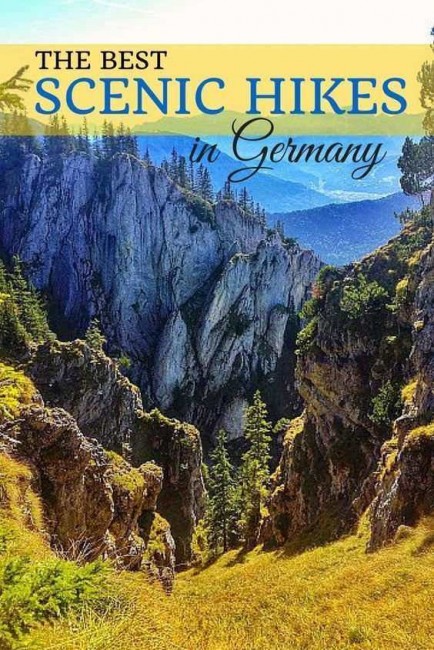
Must-see attractions in Bavarian Alps

Schloss Linderhof
Bavarian Alps
A pocket-sized trove of weird treasures, Schloss Linderhof was Ludwig II’s smallest but most sumptuous palace, and the only one he lived to see fully…

Schloss Neuschwanstein
Appearing through the mountaintops like a mirage, Schloss Neuschwanstein was the model for Disney’s Sleeping Beauty castle. King Ludwig II planned this…

Schloss Hohenschwangau
King Ludwig II grew up at the sun-yellow Schloss Hohenschwangau and later enjoyed summers here until his death in 1886. His father, Maximilian II, built…
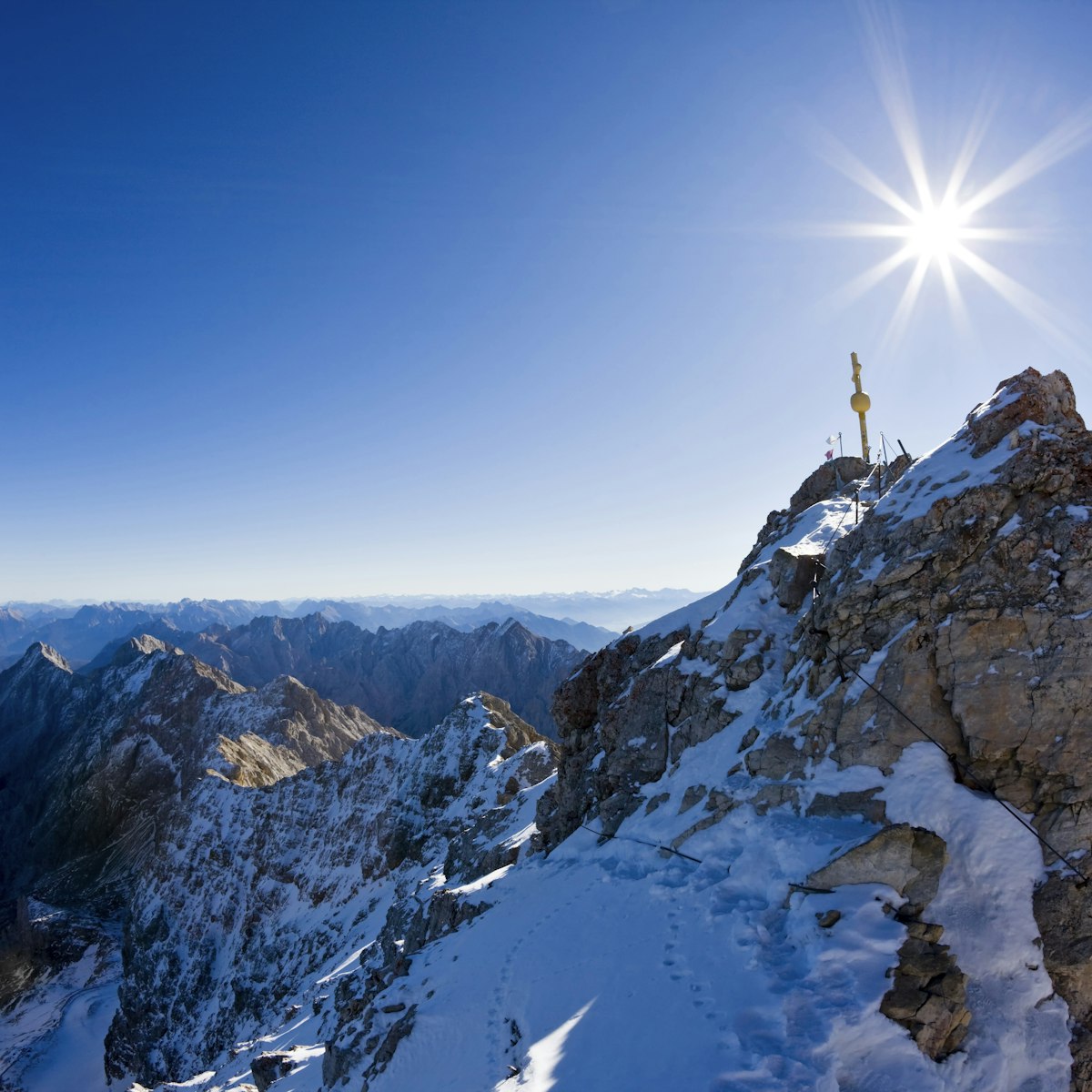
Garmisch-Partenkirchen
On good days, views from Germany’s rooftop extend into four countries. The return trip starts in Garmisch aboard a cogwheel train (Zahnradbahn) that chugs…

Schloss Herrenchiemsee
An island just 1.5km across the Chiemsee from Prien, Herreninsel is home to Ludwig II’s Versailles-inspired castle. Begun in 1878, it was never intended…

Berchtesgaden
Gliding serenely across the wonderfully picturesque, emerald-green Königssee makes for some unforgettable memories and photo opportunities. Cradled by…
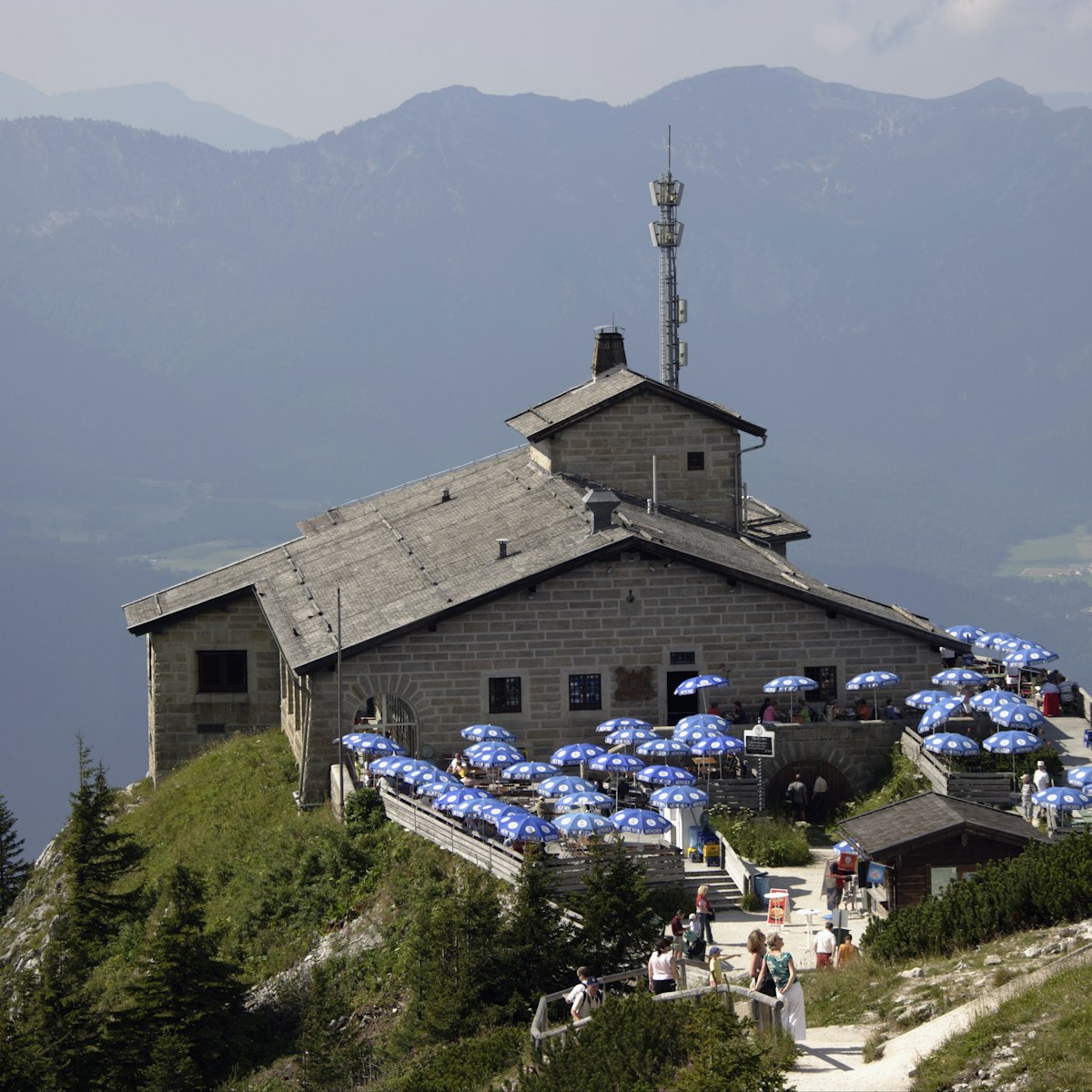
Eagle's Nest
At 1834m above sea level, the Eagle's Nest was built as a mountaintop retreat for Hitler, and gifted to him on his 50th birthday. It took around 3000…
Dokumentation Obersalzberg
In 1933 the tranquil Alpine settlement of Obersalzberg (3km from Berchtesgaden) in essence became the second seat of Nazi power after Berlin, a dark…

Berchtesgaden National Park
Forty years old in 2018, the wilds of this 210-sq-km park still offer some of the best hiking in Germany. A good introduction is a 2km trail up from St…
Located in the village of Wies, just off the B17 between Füssen and Schongau, the Wieskirche is one of Bavaria's best-known baroque churches and a Unesco…
Geigenbaumuseum
Matthias Klotz (1653–1743) is the man credited with turning Mittenwald into an internationally renowned centre of violin making. Learn more about him, the…
Jagdschloss Schachen
A popular hiking route is to King Ludwig II’s hunting lodge, Jagdschloss Schachen, which can be reached via the Partnachklamm in about a four-hour hike …
Partnachklamm
A top attraction around Garmisch is this narrow and dramatically beautiful 700m-long gorge with walls rising up to 80m. The trail hewn into the rock is…
Museum der Bayerischen Könige
Palace-fatigued visitors often head straight for the bus stop, coach park or nearest beer after a tour of the castles, most overlooking this worthwhile…
Hohes Schloss
The Hohes Schloss, a late-Gothic confection and one-time retreat of the bishops of Augsburg, towers over Füssen’s compact historical centre. The north…
Fraueninsel
A third of this tiny island is occupied by Frauenwörth Abbey, founded in the late 8th century, making it one of the oldest abbeys in Bavaria. The 10th…
Kloster Ettal
Ettal would be just another bend in the road were it not for this famous monastery. The highlight here is the sugary rococo basilica housing the monks'…
Salzbergwerk
Once a major producer of ‘white gold’, Berchtesgaden has thrown open its salt mines for fun-filled 1½-hour tours. Kids especially love donning miners’…
Kirchdorf Wamberg
For an easy hike accompanied by achingly quaint, chocolate-box views head to Germany's highest Kirchdorf (basically a hamlet with a church where services…
Tegelbergbahn
For fabulous views of the Alps and the Forggensee, take this cable car to the top of the Tegelberg (1730m), a prime launching point for hang-gliders and…
Oberammergau Museum
This is one of the best places to view exquisite examples of Oberammergau's famously intricate woodcarving art. The village has a long tradition of…
Passionstheater
The Passionstheater, where the Passion Play is performed, can be visited as part of a guided tour. The tour provides ample background on the play’s…
Kalvarienberg
Above the town, on Kalvarienberg, looms Bad Tölz’ landmark, the twin-towered Kalvarienbergkirche. This enormous baroque structure stands side by side with…
Frauenwörth Abbey
Founded in the late 8th century, this is one of the oldest abbeys in Bavaria. The 45-minute tours are in German only.
Pilatushaus
Aside from the Passion Play, Oberammergau's other claim to fame is its Lüftmalerei, the eye-popping house facades painted in an illusionist style. The…
Museum Füssen
Below the Hohes Schloss, and integrated into the former Abbey of St Mang, this museum highlights Füssen's heyday as a 16th-century violin-making centre…
Stadtmuseum
The Stadtmuseum touches on practically all aspects of local culture and history, with a fine collection of painted armoires (the so-called Tölzer Kasten…
The austerely romanesque Carolingian Torhalle built in AD 860 houses medieval objets d'art, sculpture and changing exhibitions of regional paintings from…
More destinations you need to see


Bavaria (Bayern) and the German Alps Travel Guide
This post may contain affiliate links. Read my disclaimer policy.
The southern German state of Bavaria ( Bayern in German) is one of the most popular parts of Germany for travelers to visit.
Not only can you visit Munich, the largest city in Bavaria and home of Oktoberfest, you can spend time in the German Alps, drive the Romantic Road area and visit picturesque towns and villages along the way, tour the famous fairytale Neuschwanstein castle – and much more!
This guide will help you start planning what to do and see in Bavaria and the German Alps, where to stay, best tours, day trip ideas, and more.
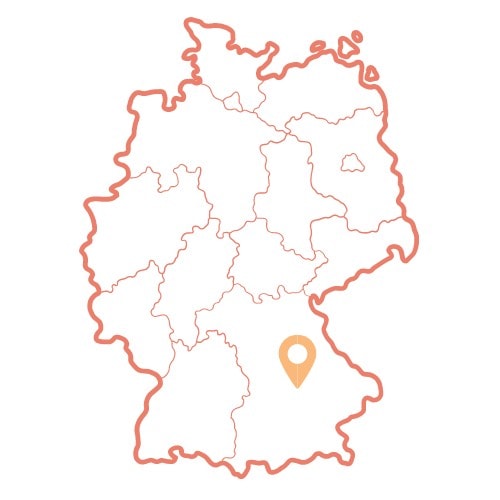
What to Do and See in Bavaria and the Alps
It’s no wonder that Bavaria is one of the most popular destinations in Germany. Bavaria offers something for everyone, from snow-capped peaks to spectacular castles, alpine lakes, world-class museums, Oktoberfest, automobile museums, and enchanting small towns and villages. Read more about these areas in the following blog posts!
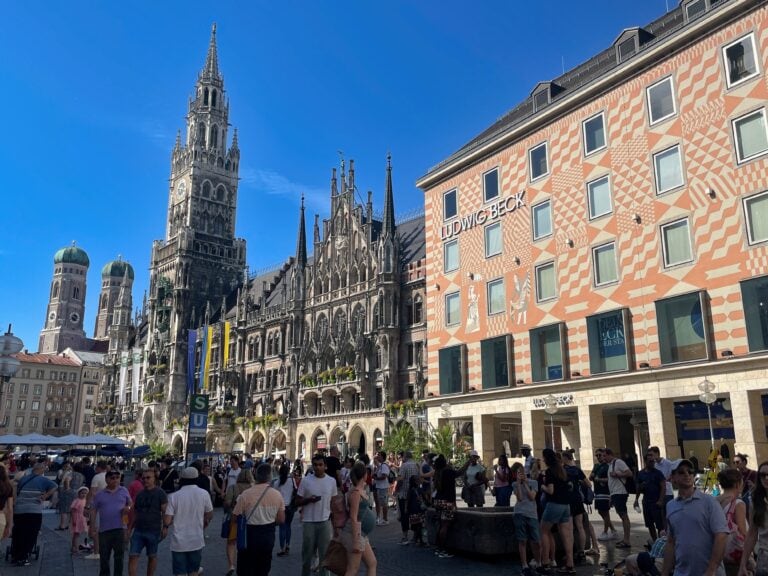
Best Things to See and Do in Munich
View our top recommendations!
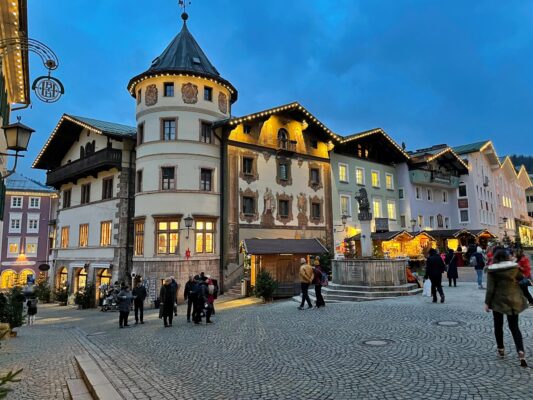
Best Things to See and Do Berchtesgaden
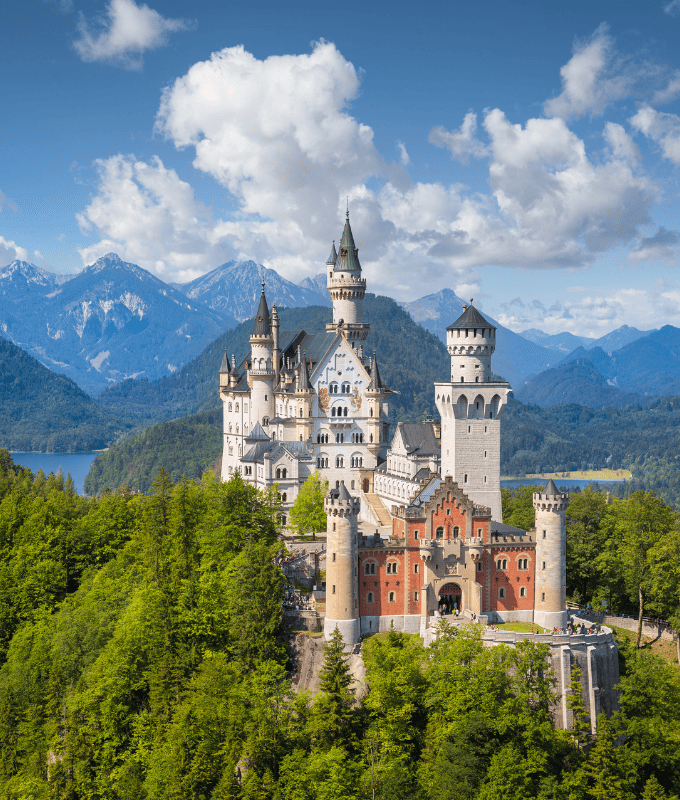
Visiting Neuschwanstein and Füssen
View our top tips!

Castles in Bavaria
Best accommodations in bavaria and the alps.
You can find all kinds of hotels, B&Bs, guest houses, apartments, and vacation houses throughout Bavaria and in the Alps.
We recommend using Booking because you can easily search for hotels and apartments (and we’ve actually found apartments we’ve found on Airbnb are actually cheaper on Booking!), you can book places without having to pre-pay, and they have a price guarantee. Plus, it’s SO convenient to have most or all of your reservations in one place, rather than scattered around various website and email inboxes.
If you’re looking for an apartment in Bavaria or the Alps, do a search on Booking . We’ve found several great apartments there (less than what we saw on Airbnb for the same apartment) and it’s SO nice to have all hotel and apartment reservations in one place.
Book your Bavaria or the Alps accommodations in advance! They tend to fill quickly during peak travel times (summer, Christmas, etc.) so I recommend seeing what’s open for your travel dates .
If you have our Germany Travel Planner you’ll find recommended hotels on our interactive planning map. Seeing where these hotels are in relation to the top sights makes it a lot easier to find the perfect place to stay. If you don’t yet have it, click here to get access.
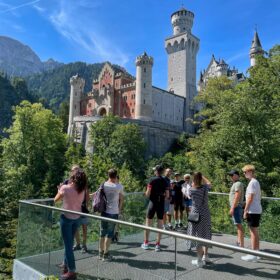
Hotels near Neuschwanstein Castle / Füssen
Click here for our best recommendations… ➔
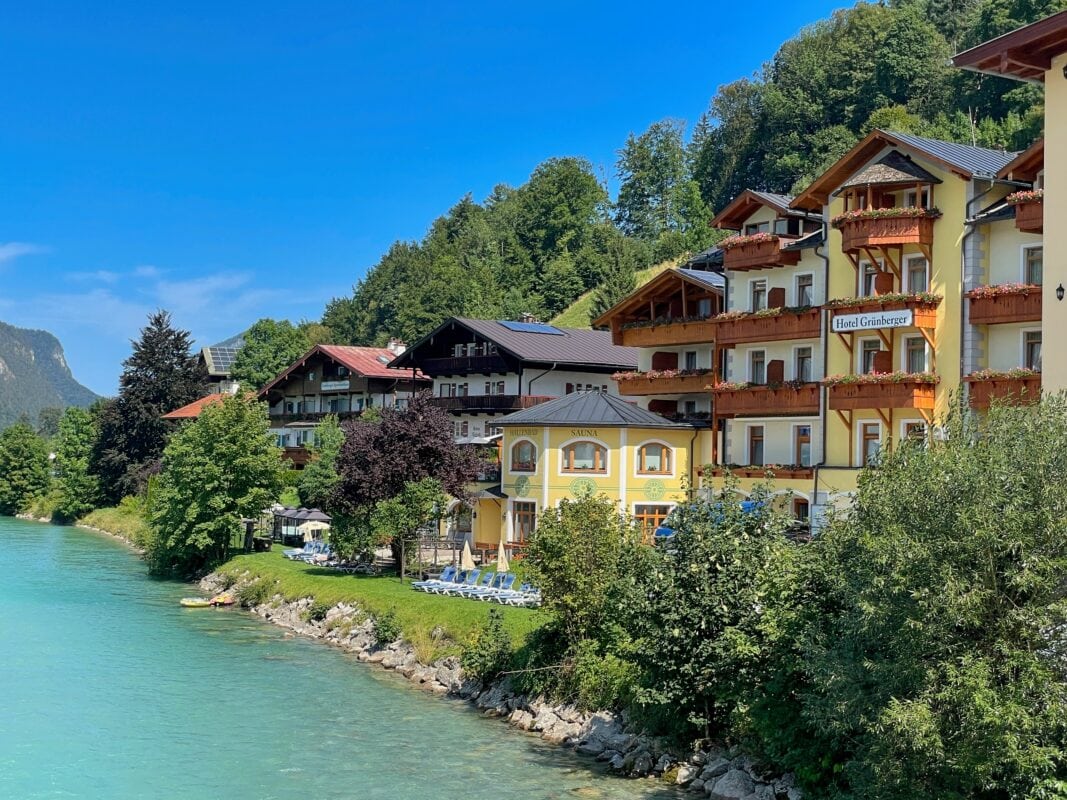
Berchtesgaden Hotels
Click here for our top recommendations… ➔
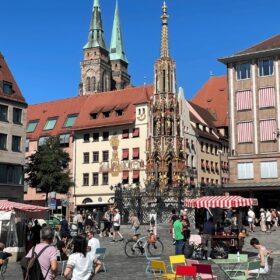
Nuremberg Hotels

Munich Oktoberfest Hotels
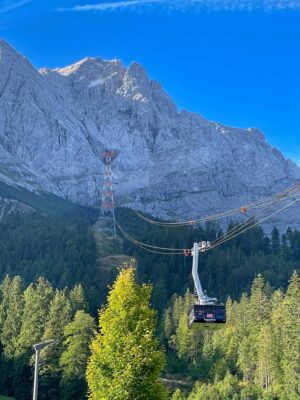
Garmisch-Partenkirchen (Zugspitze) Hotels
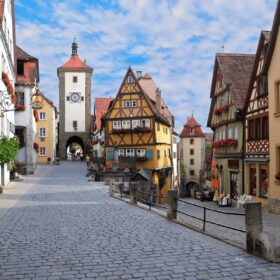
Rothenburg Hotels
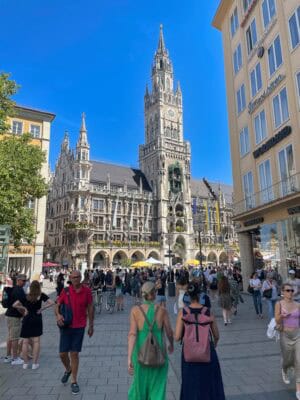
Munich Hotels
Click here for best recommendations… ➔
Know Before You Go
Airport: Munich International Airport (MUC) Currency: Euro Language: The official language of Germany is German (Deutsch) Time zone: Central European Time (CET / GMT+ 2 / 6 hours ahead of US EST) Germany Visa: tourists from the US, Canada, and several other countries do not need a visa to visit Germany for under 90 days. Germany Electricity Socket: Germany uses different voltage and sockets than in North America, the UK, and other parts of the world. Read our guide to adapters and converters so you can safely use your tech in Germany. Germany SIM card: Read our guide here to SIM cards and other ways to use your phone in Germany. Germany Car Rentals: We find great deals on rental cars here . You can also check out our scenic Germany road trips article here.
Best Tours, Tickets & Day Trips in Bavaria and The Alps
One of the best things about visiting Bavaria is that no matter where you go you have endless things to do and countless day trip options. You can plan your own day trips for maximum flexibility or book a guided tour for maximum relaxation and convenience. Here are some ideas to get your planning started.
FROM OUR AFFILIATES…
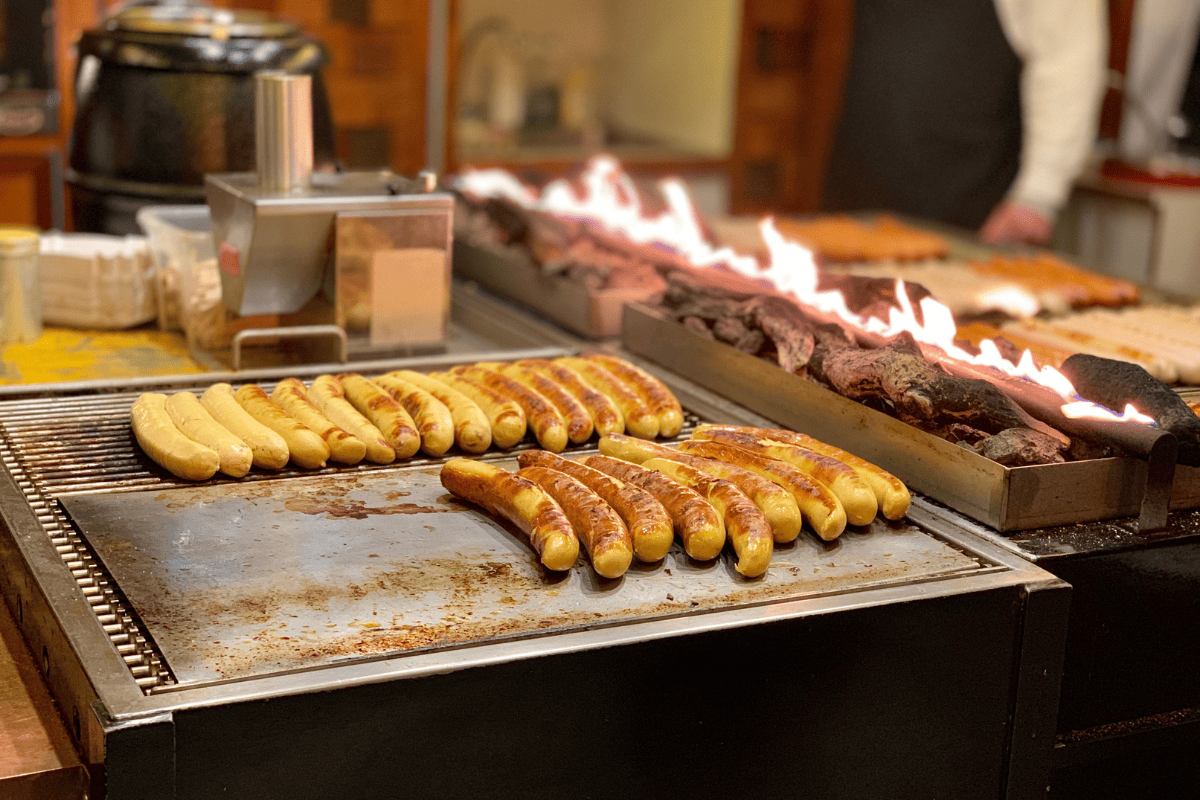
Munich Food Tour
Click to learn more… ➔
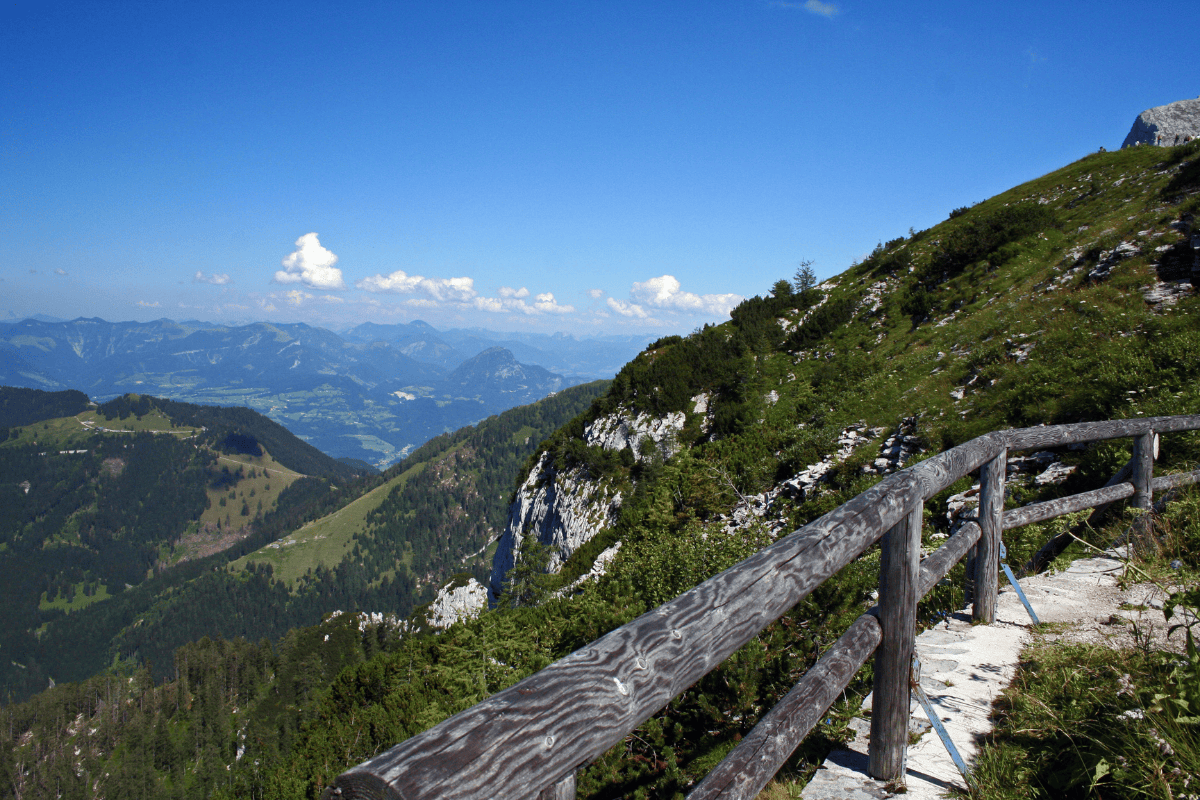
Visit Eagle’s Nest
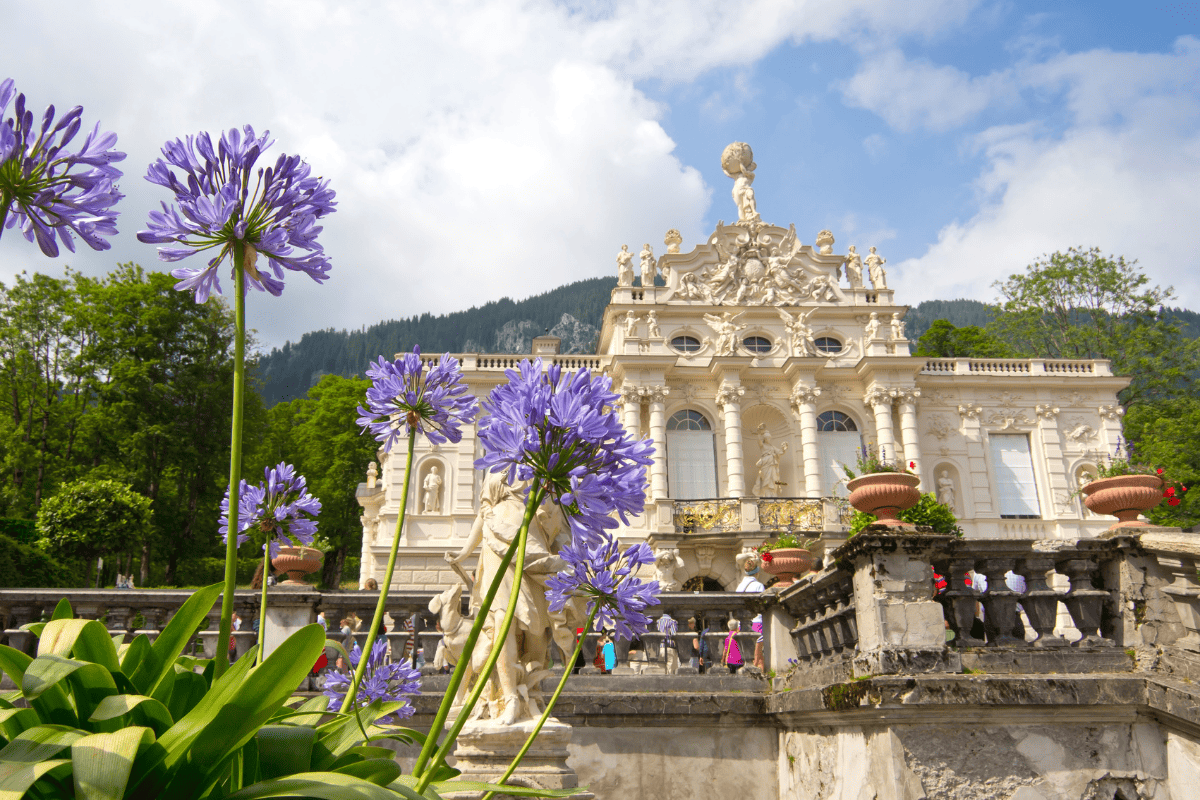
Visit Linderhof Palace
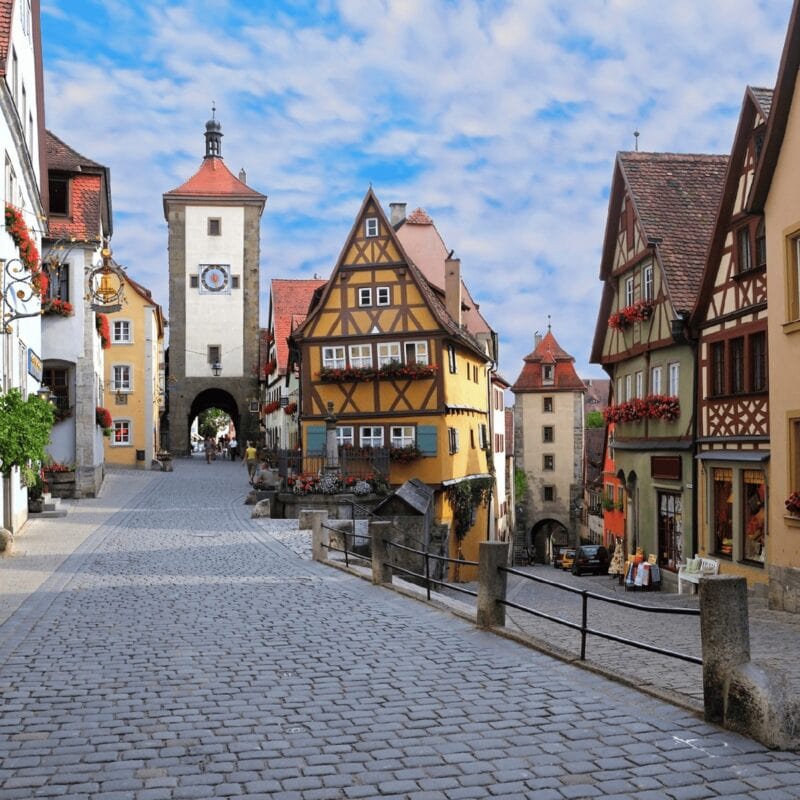
Explore the Romantic Road
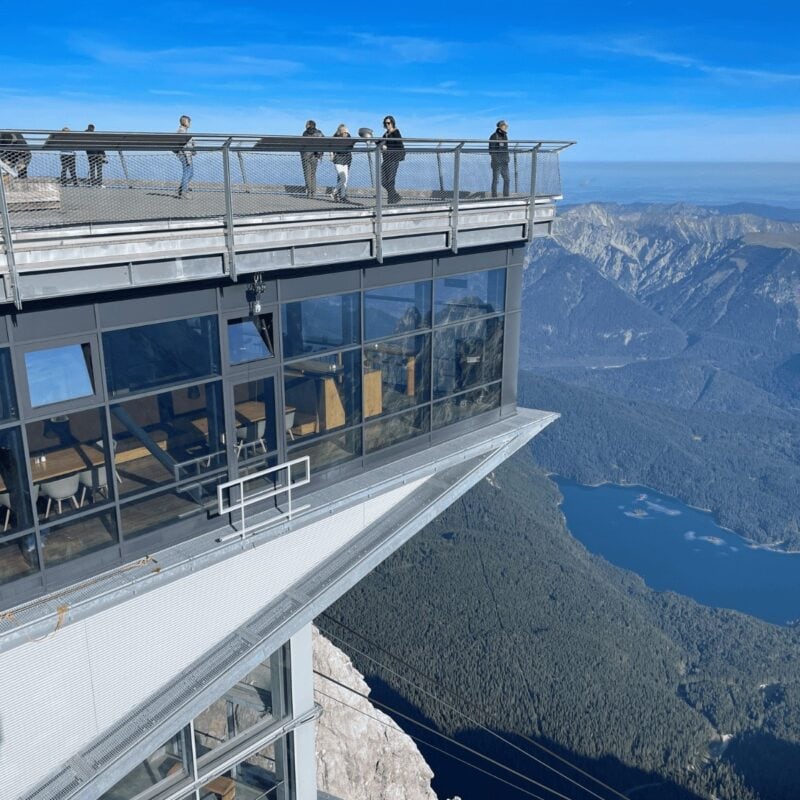
Visit Zugspitze
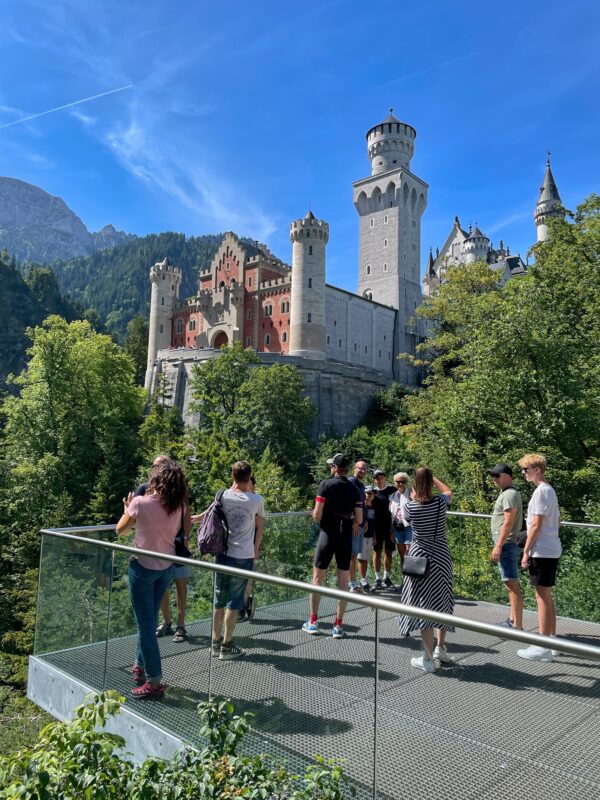
Visit Neuschwanstein
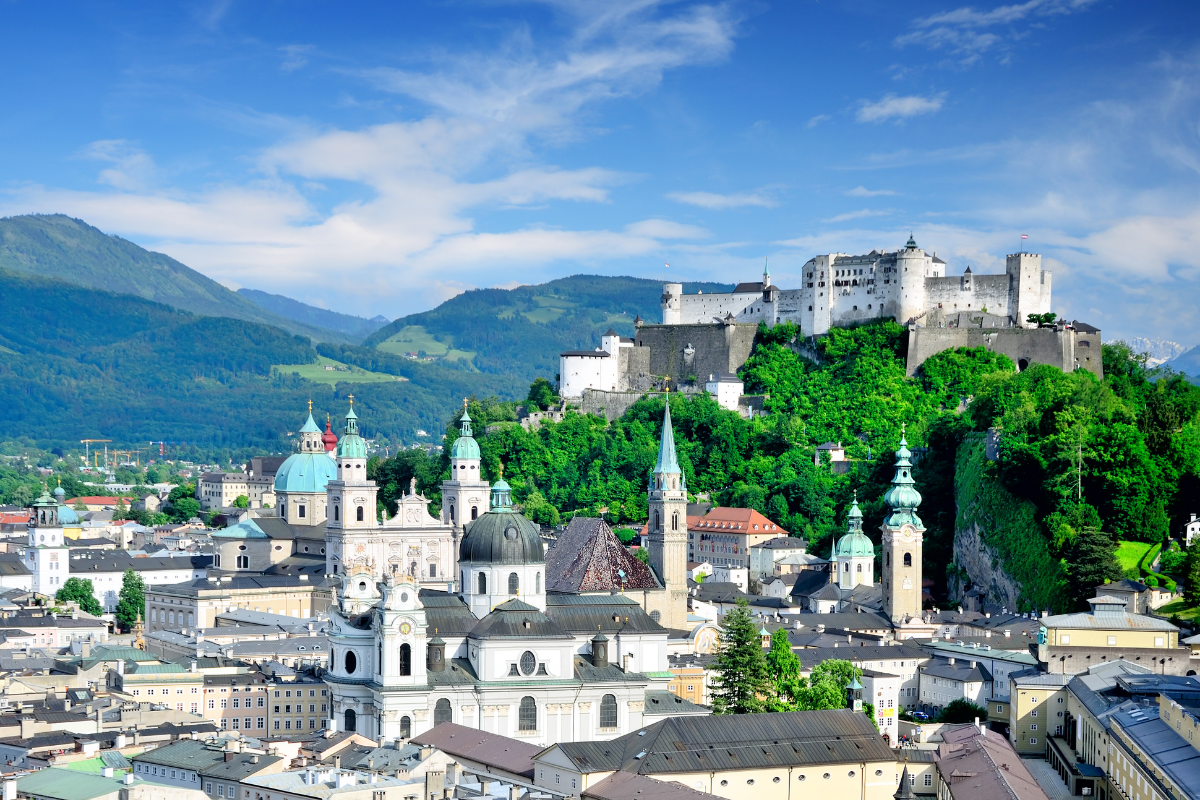
Visit Salzburg
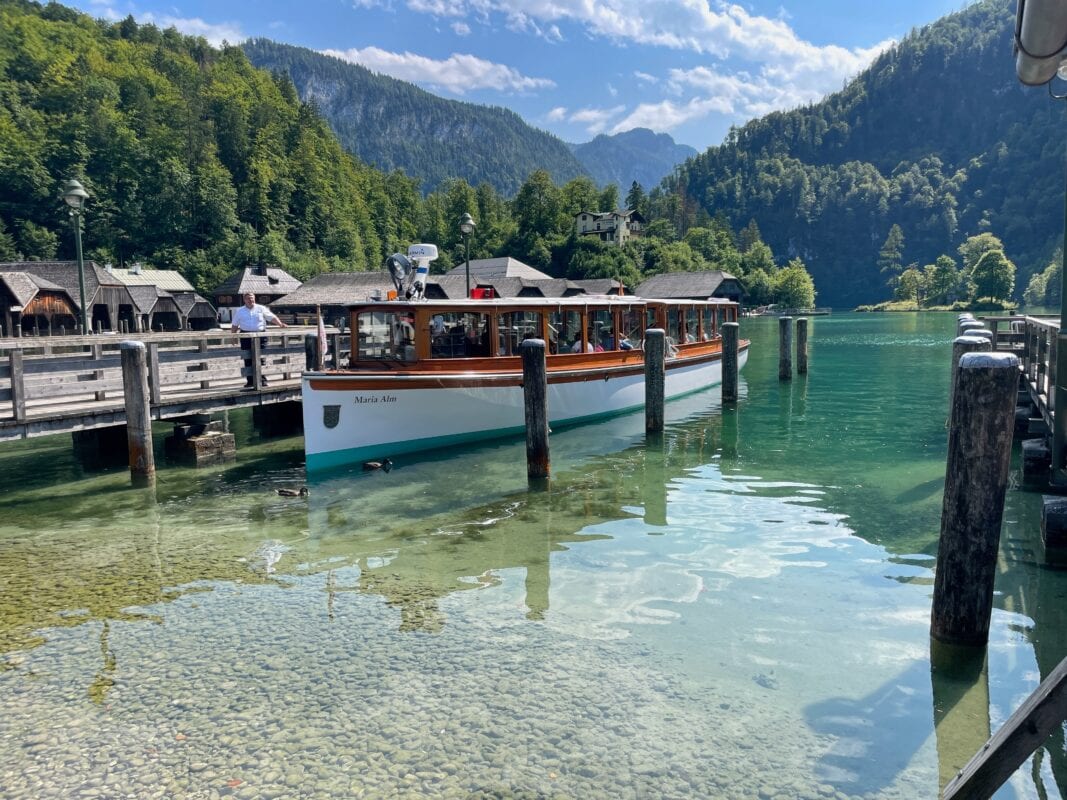
Visit Königsee Lake, Berchtesgaden
Bavaria and alps travel faq, where is bavaria located.
Bavaria is in southeastern Germany and borders the countries of Czechia, Austria, Switzerland (barely) – see the map below.
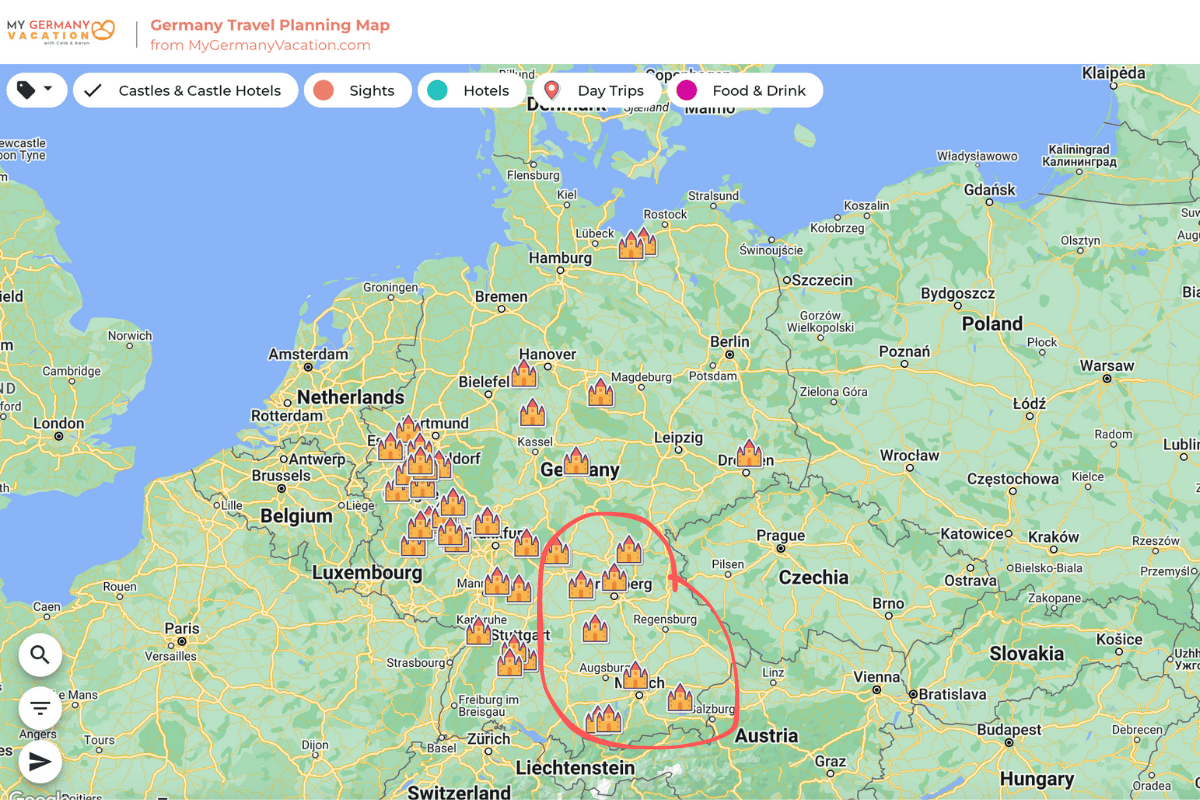
Where are the German Alps Located?
The German Alps are in the southernmost part of Germany in the state of Bavaria along the border with Austria – see the map below.
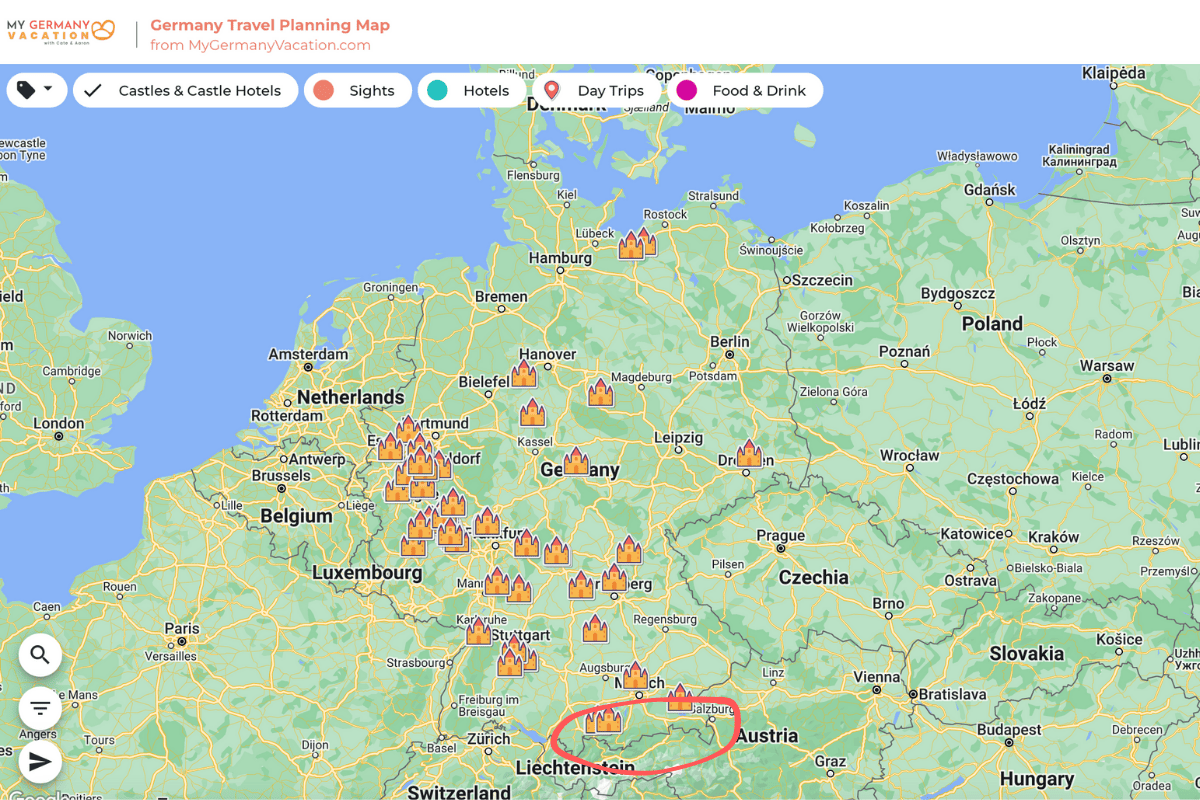
Where do I Get That Map?
If you have our Germany Travel Planner, you’ll find recommended hotels on our interactive planning map. Seeing where these hotels are in relation to the top sights makes it a lot easier to find the perfect place to stay. If you don’t have it yet, click here to get access.

How Many Days to Spend in Bavaria and the Alps?
You could spend just a couple days in one city or area as part of your overall Germany trip — or your entire 1-2 week trip just in Bavaria.
If you’re aiming for just a taste of Bavaria or the Alps, choose 1 location and add a day trip. For example, Nürnberg with a day trip to Rothernburg ob der Tauber. Or Munich with a day trip to Neuschwanstein castle.
If you’d like to get to know Bavaria in more detail, you could, for example, do a road or train trip around the entire state and include the Romantic Road area, Munich, Neuschwanstein castle, Zugspitze, Berchtesgaden, as well as visits to lakes, hikes, and other fun outdoor activities (or Christmas markets in December).
Is it Safe to Travel in Bavaria and the Alps?
Yes. Traveling in Germany is safe overall. Use everyday common sense and take the usual precautions.
Are Bavaria and the Alps Worth Visiting?
Yes! The Alps are stunning and the state of Bavaria has so much to do and see including vibrant cities, picturesque towns and villages, festivals, local beer, festivals, castles and palaces, lakes, and outdoor activities.
Are Bavaria and the Alps Expensive?
While some parts of this area are popular vacation destinations and prices rise during the peak season or big events (like Oktoberfest), prices are fairly similar to the rest of Germany.
What’s the Closest Airport?
If you plan to visit Bavaria or the German Alps, Munich is the best airport to fly into. From there you can easily and quickly reach all destinations by train or car.
You could, however, also fly into Frankfurt International Airport, Stuttgart International Airport or Airport Nürnberg.
What’s The Best Way to Get to Your Hotel?
If you’re going from the airport into the nearest city, you can take public transportation, grab a taxi or use the FreeNow app.
All Bavaria and German Alps Posts…
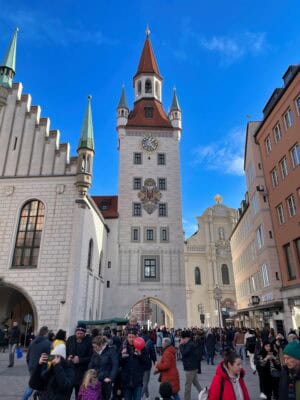
Best Things to Do & See in Munich
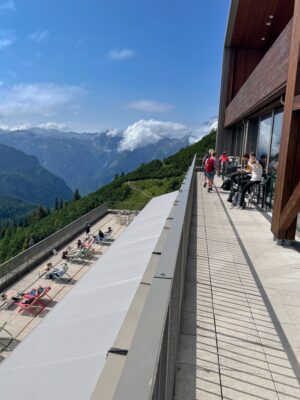
Best Things to Do & See in Berchesgaten
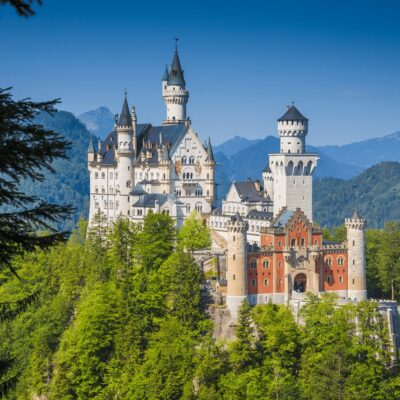
How to Visit Neuschwanstein
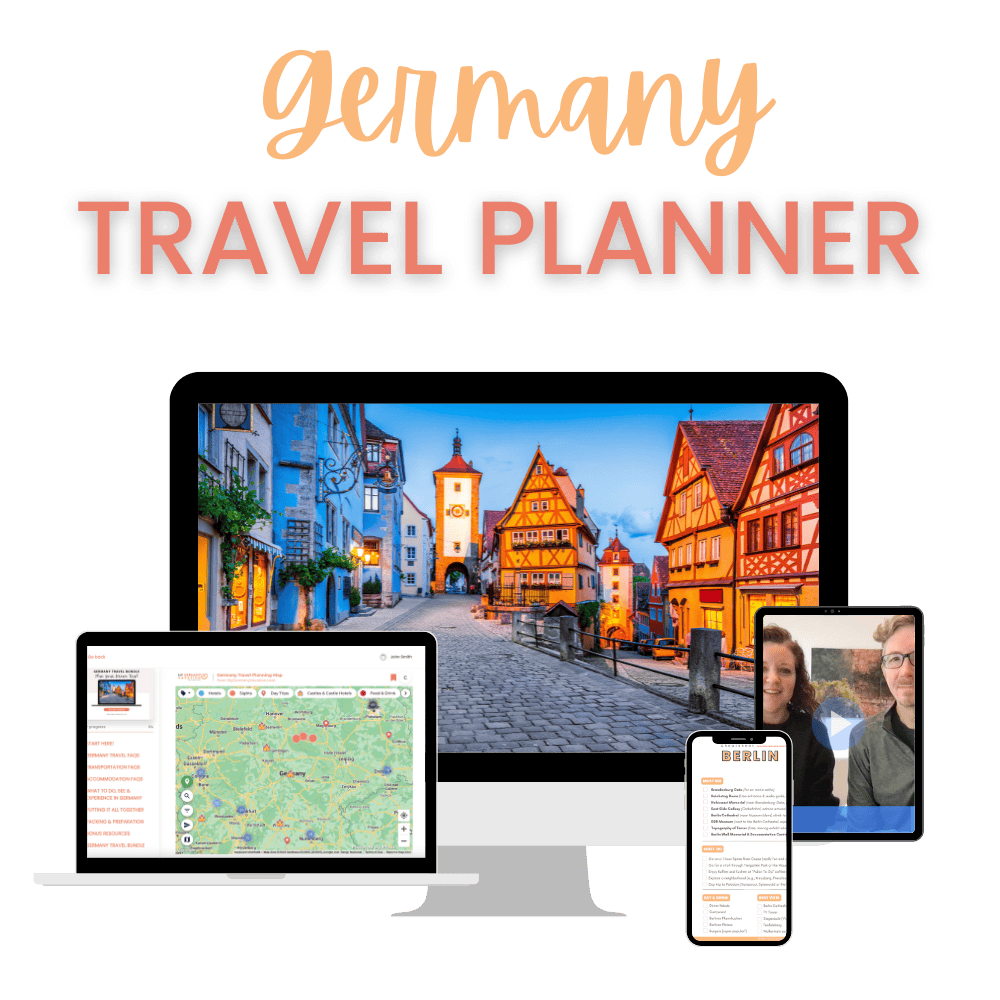
- Interactive
- Comprehensive
- Informative
The Easy Way to Enjoy the BEST of Germany.
Planning a trip to Germany is surprisingly overwhelming – even for seasoned travelers!
That’s why we created the Germany Travel Planner .
With our 30+ years Germany travel experience and expertise by your side, you’ll navigate the complexities of trip planning effortlessly. And then enjoy a relaxed and memorable adventure filled with unique experiences tailored to your preferences!
Grab your FREE 10 Germany Gems Cheatsheet Now!
23 Things to do in the Bavarian Alps, Germany: Best hikes (+ map)
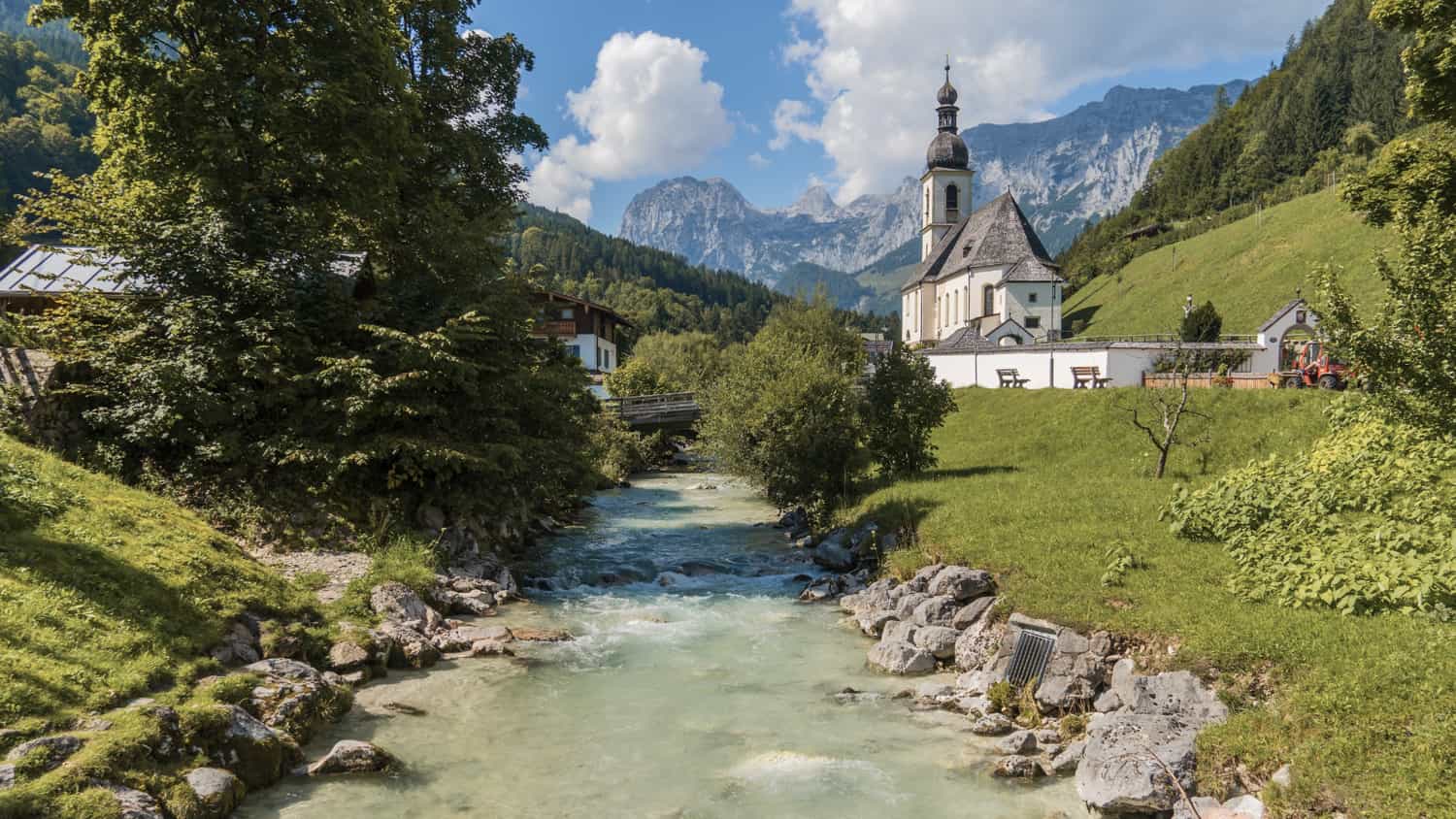
Visit the Bavarian Alps, where beautiful nature, wild gorges, crystal clear lakes and peaks combine to offer breathtaking views. Today we show you the most beautiful places in Bavaria with tips for trips and hiking routes to the Bavarian Alps for your holiday. Enjoy the best things to do in the Bavarian Alps this summer, whether you’re travelling as a couple or with your family.
The Bavarian Alps are criss-crossed with hiking trails, gorges, lakes, but also beautiful castles and palaces. Today, we’ll show you the most beautiful places – a little bit of everything, so you can get an idea of what you’re in for. Join us for a look at what to see in the Alps in Germany.
- 23. Eagle's Nest
Things to do in Bavarian Alps, Germany: Best hikes
1. breitachklamm – hiking in bavarian alps.
The Breitachklamm is one of the deepest and most spectacular rock gorges in Central Europe, carved out of the rocks by the Breitach River. The gorge is known for its wild beauty and dramatic rock formations.
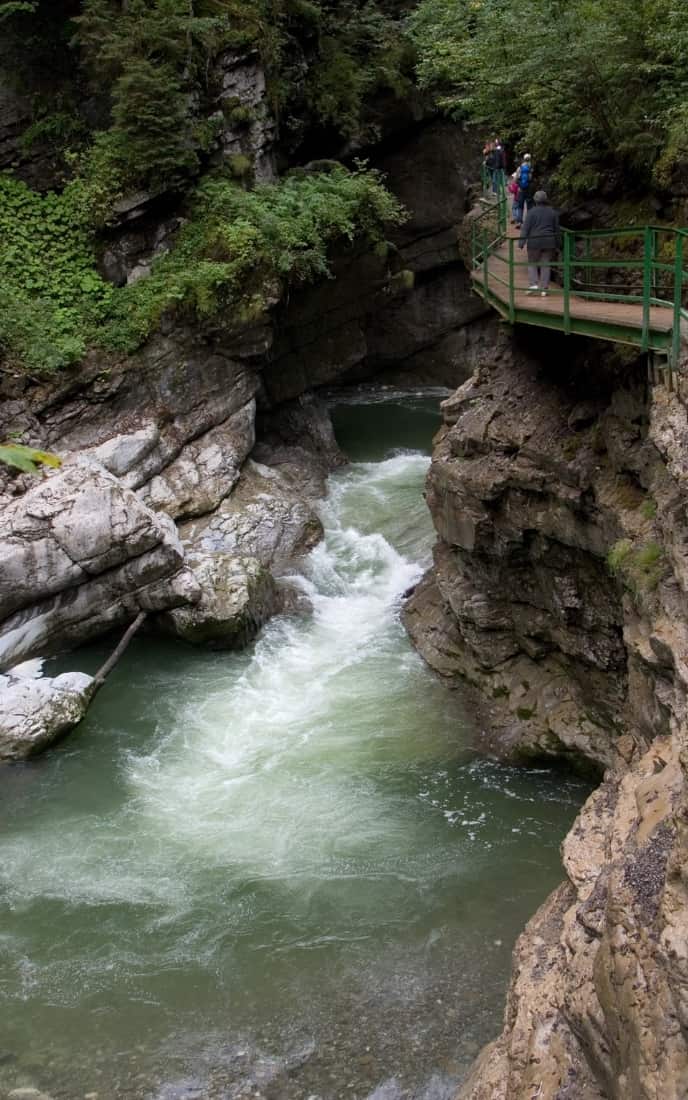
The chain is approximately 2.5 kilometres long and in some places reaches a depth of 150 metres. Here you can see a series of waterfalls and steep rock walls along wooden bridges and walkways.
Breitachklamm is open all year round and especially in the summer months, be prepared for crowds of tourists. In winter there are beautiful icefalls.
You can find up-to-date information on opening times and admission fees at this link.
2. Fellhorn, Bavarian Alps
The Fellhorn is a 2,038-metre-high mountain peak located in the Allgäuser Alps on the border between Germany and Austria.
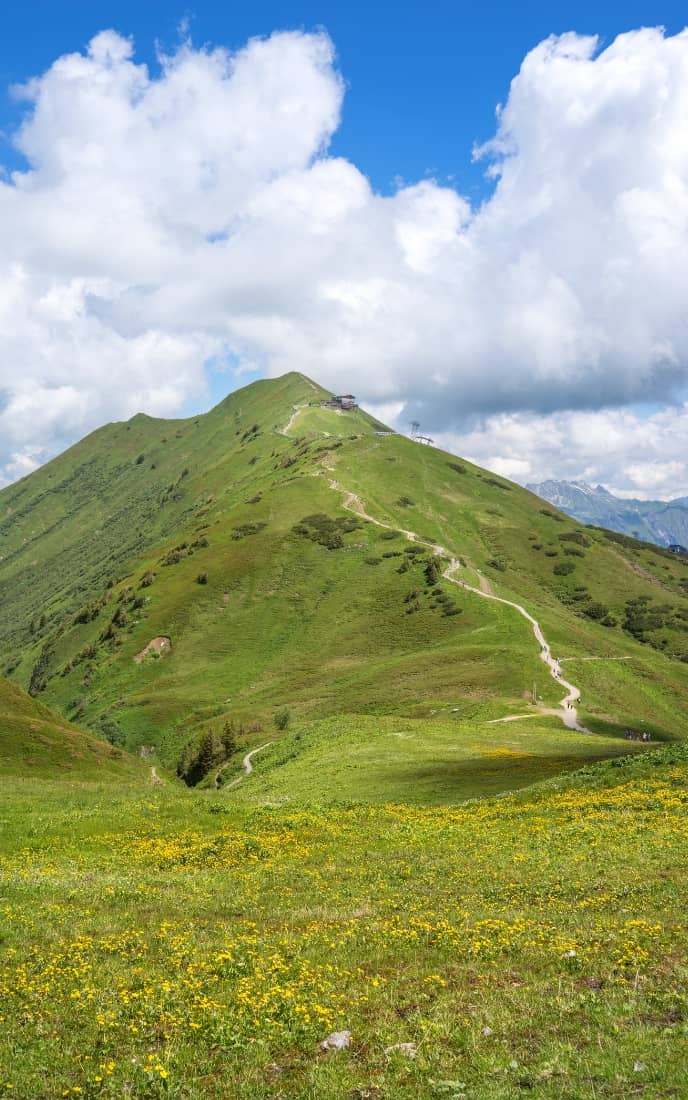
The area around the Fellhorn is famous for its beautiful alpine meadows, which from June bloom with wild flowers including alpine roses. In winter, the area turns into a popular ski resort, which is part of the Oberstdorf/Kleinwalsertal ski area.
The summit is reached by the Fellhornbahn cable car, which is open all year round. There are hiking trails in the area, including an easy trail along the ridge that offers fantastic views. Visit the Schlappoldsee and the Schlappold, the highest alpine pasture in Germany, where there is also a restaurant and playground.
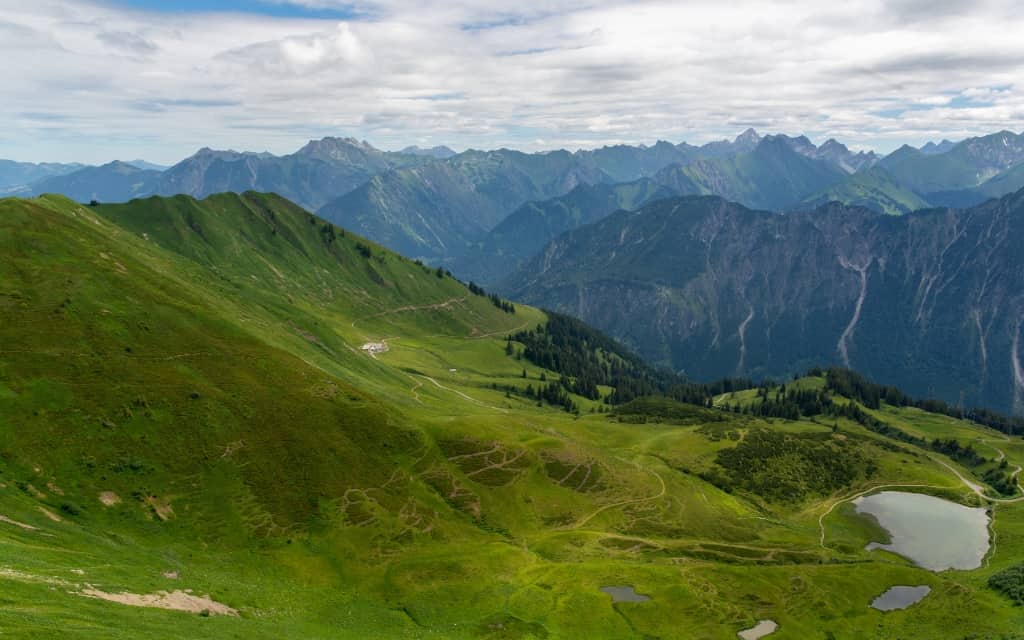
3. Freibergsee, Bavarian Alps
The Freibergsee is the largest alpine lake in Germany, surrounded by dense forests with spectacular views of the surrounding mountains.
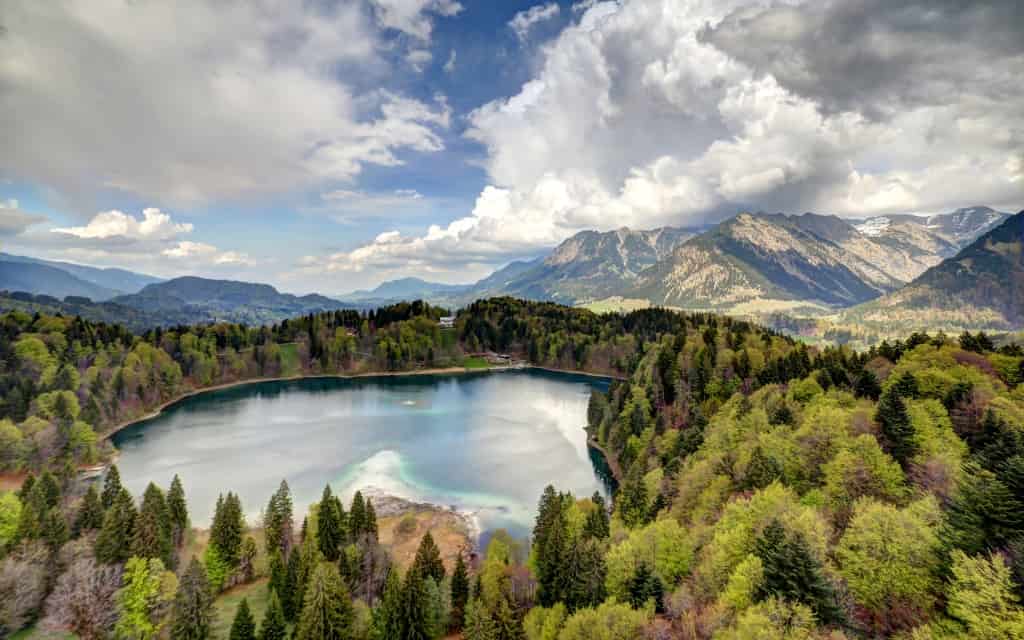
It is close to the town of Oberstdorf, where you can park in the paid parking lot and take the easy uphill route to the lake (30-minute walk).
In the summer months, the water temperature rises up to 25 degrees Celsius. Near the lake there is a natural swimming pool with a beach and a hotel with a restaurant.
The surrounding area is interwoven with easy hiking trails, from where you can go to the ski jump or below the Söllereck peak, where there is a restaurant and a playground for children (the Söllereck peak can also be reached by cable car from Kornau).
4. Seealpe – Nebelhorn
At 2,224 metres, the Nebelhorn is one of the highest peaks in the Allgäus Alps. The Nebelhornbahn cable car, which is open all year round, takes you to the top. From the station at the top you have a fantastic view of the surrounding landscape, including a view of more than 400 peaks in the Alps in good visibility.
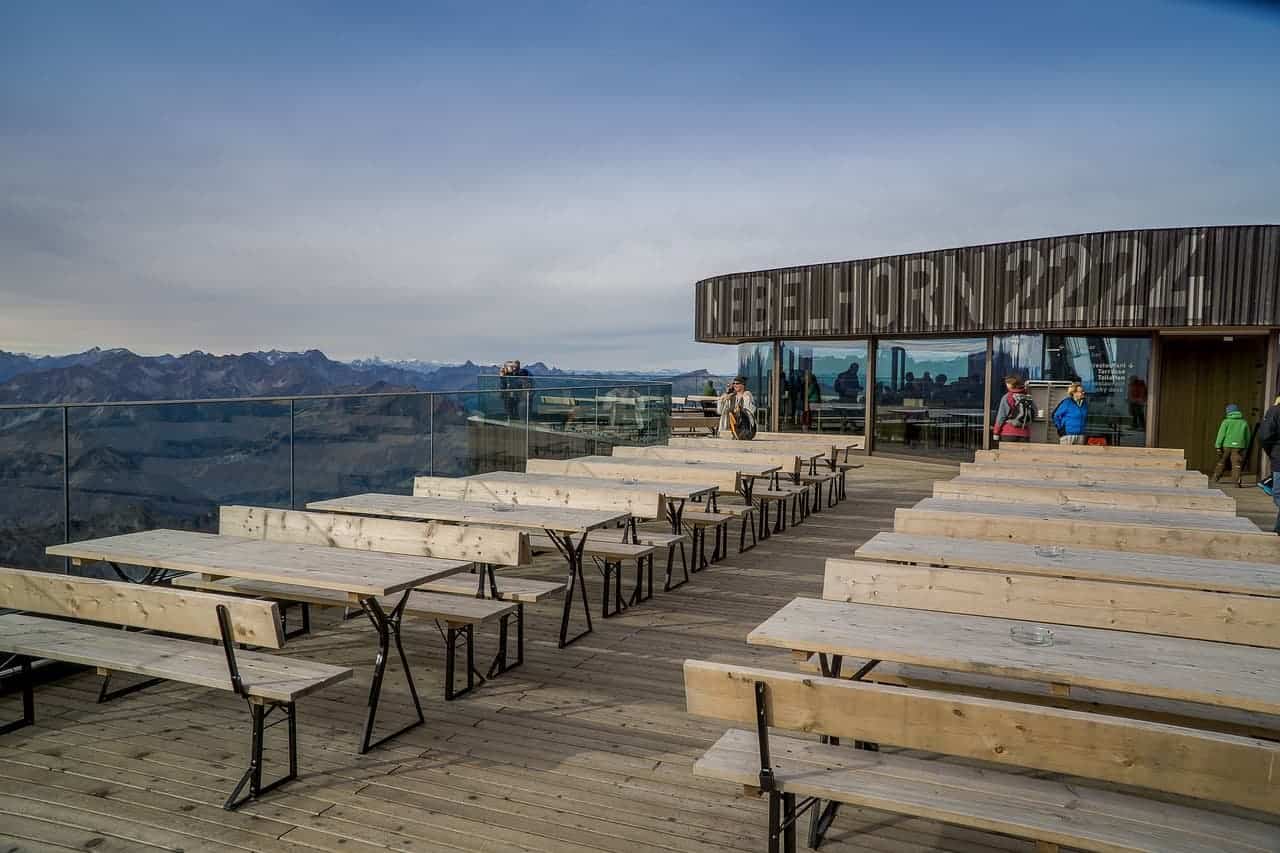
You can also climb the peak on your own – you can expect a full-day hike with an elevation gain of just under 1,400 metres.
The cable car is divided into 3 parts:
- The first part leads to the Seealpe restaurant, ideal for families with children, with a playground and easy trails.
- The second part of the cable car drops you off at the Edmund-Probst-Haus mountain hut, from where you can go on alpine treks. If you head towards the Zeigersattel mountain saddle, you will have a wonderful view of the Seealpsee.
- The last part of the cable car takes you to the top of the Nebelhorn with a restaurant and fantastic views
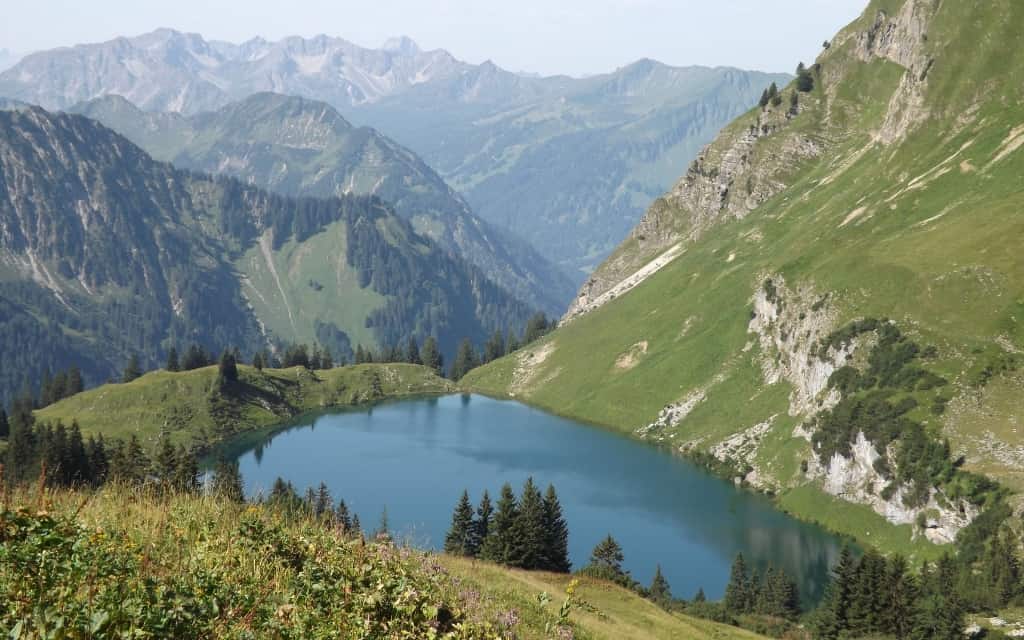
5. Schrecksee, Bavarian Alps
The Schrecksee is a picturesque mountain lake in the Allgäuser Alps, which, with an altitude of 1,813 metres above sea level, is one of the highest lakes in Germany .
The lake is surrounded by mountain peaks and meadows, which are covered with colourful alpine flowers in the summer months. The way up is challenging and leads over uneven, rubble terrain that is relatively steep in places. With good physical condition you will be up in 2.5 hours.
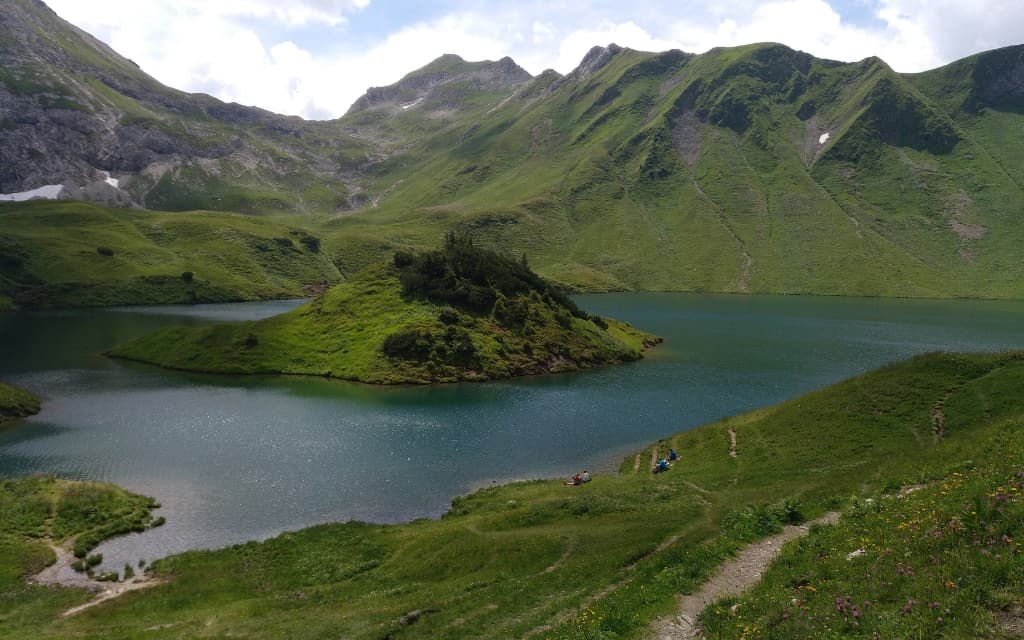
The starting point is the paid parking lot behind Hinterstein (usually full early in the season). An even better option is to take the bus from Bad Hindelang, as you will save yourself the journey from the car park.
Plenty of water, food and good shoes are a must.
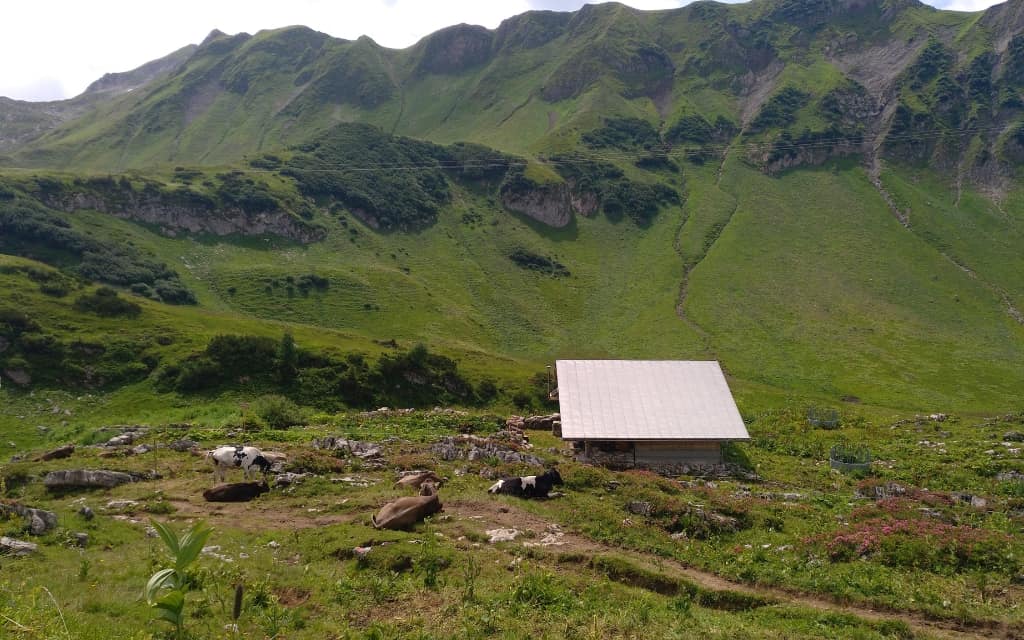
The best accommodation in the Allgäus Alps:
- Hotel Bergflair: Fantastic, stylish hotel with mountain views, spa and excellent cuisine
- Prinz-Luitpold-Bad: Traditional Alpine hotel nestled in the mountains, with views, excellent food and a swimming pool
- Rothenfels Hotel & Panorama Restaurant: Cozy, newly renovated hotel with lake view and complete facilities
6. Zugspitze and Eibsee
The Zugspitze (2962 m) is located on the border between Germany and Austria and is the highest peak in Germany. You can reach the top by a comfortable, modern cable car, from where you can enjoy spectacular views of the surrounding area. Among other things, to Lake Eibsee, which lies at the foot of the Zugspitze.
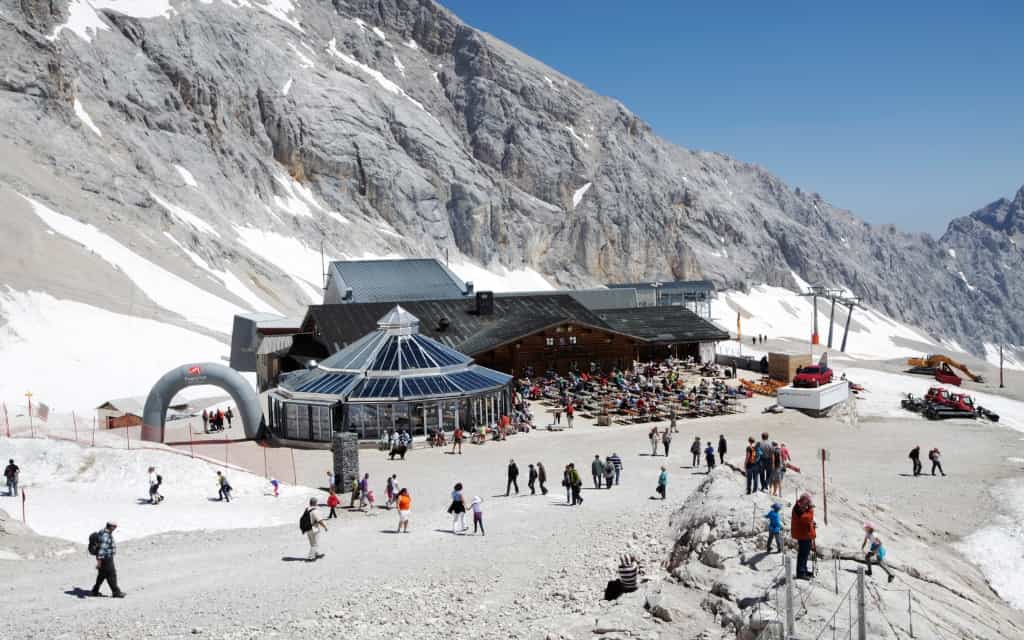
The Eibsee is a popular excursion in the Bavarian Alps. There is an easy, well-maintained trail that is ideal for families with children, strollers and bicycles. The tour takes an hour or two depending on how often you walk around.
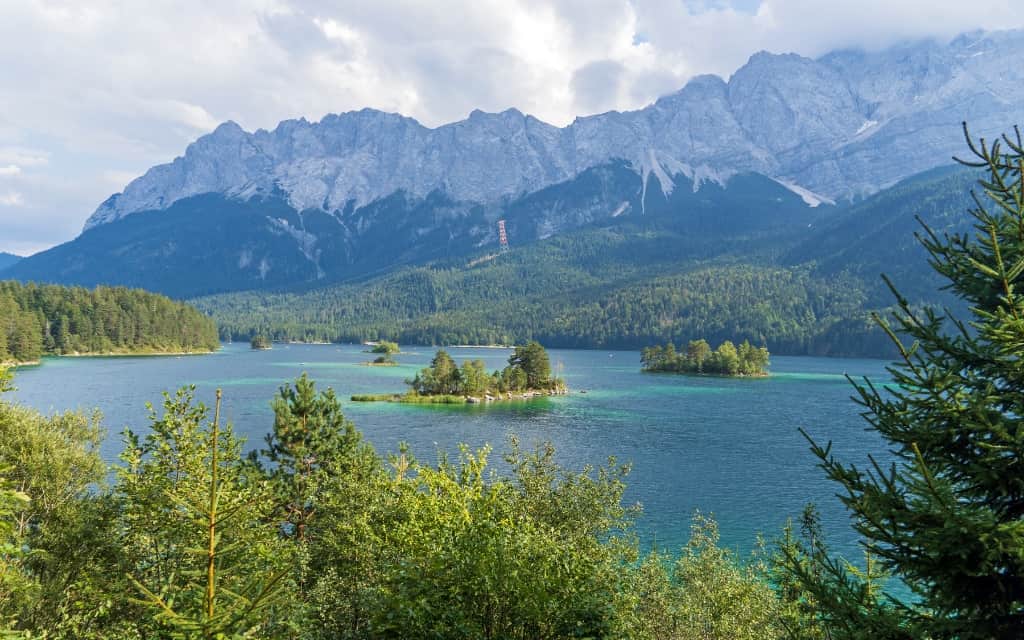
The starting point for the Zugspitze and the Eibsee is the large pay parking lot, where the lower station of the Zugspitze cable car is located.
You can find more information about the Zugspitze cable car at this link. The upper station of the cable car is also a restaurant and a viewing platform. There are belayed trails in the area that you can go down if you have experience with alpine terrain.
7. Partnachklamm, Bavarian Alps
Partnachklamm is a beautiful and wild gorge near the town of Garmisch-Partenkirchen, which is a popular winter sports resort.
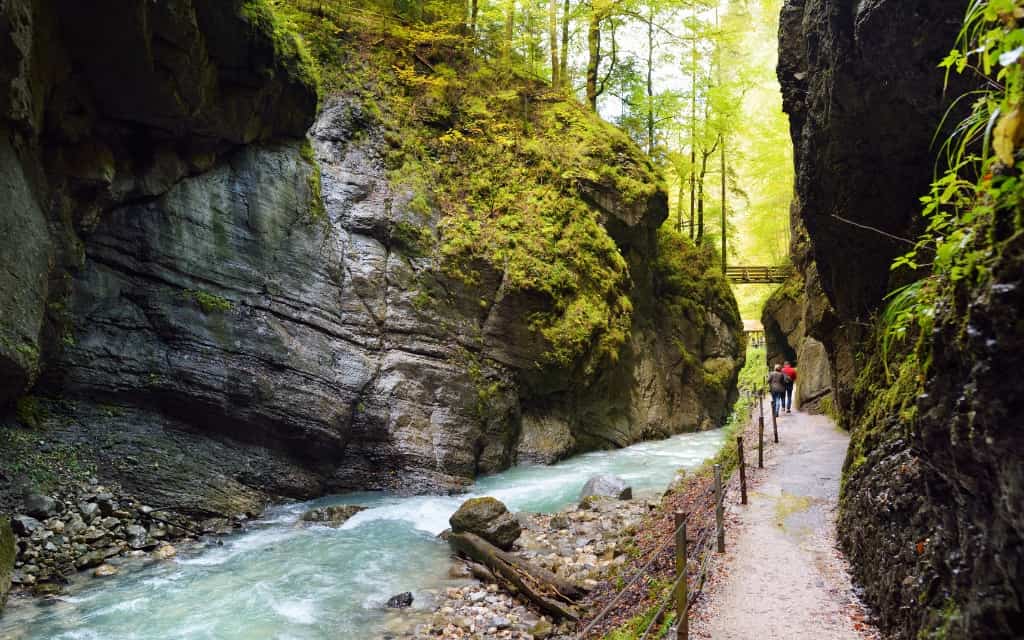
The chain is approximately 700 metres long and in some places reaches a depth of 80 metres. It is formed by the Partnach River, which flows through the wild landscape and creates waterfalls, deep pools and water flows.
You walk through the gorge on pavement and bridges that are suspended high above the river.
In winter, Partnachklamm turns into an ice wonder, when the water from the waterfalls freezes and creates beautiful ice sculptures.
Here you can find the current opening hours and entrance fees to the Partnachklamm Gorge.
8. Neuschwanstein Castle
Neuschwanstein Castle is one of the most beautiful places to visit not only in the Bavarian Alps, but also in the whole of Germany . Iconic castle inspired by Walt Disney’s Sleeping Beauty Castle.
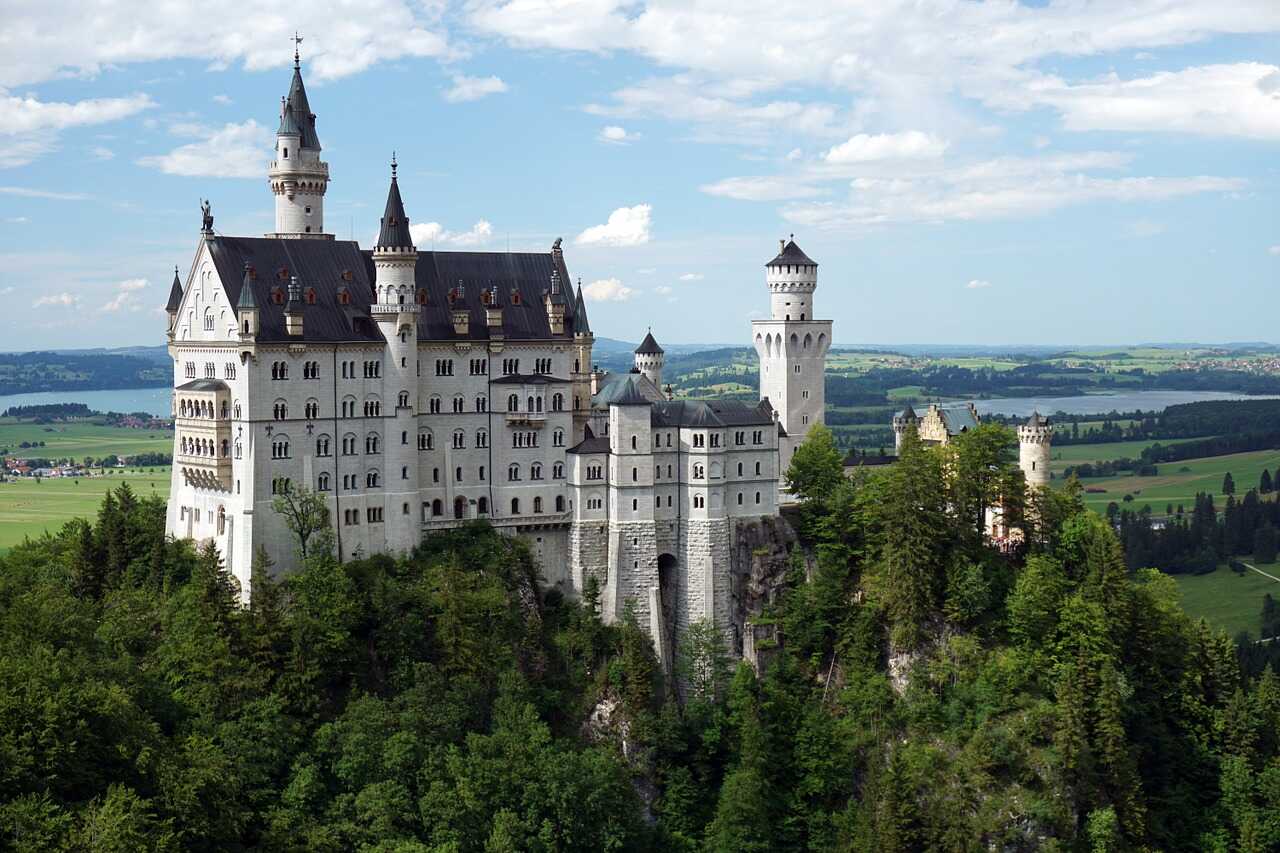
Neuschwanstein was built at the end of the 19th century by order of King Ludwig II of Bavaria, who is often referred to as the “Mad King”. Ludwig II had the castle built as his private retreat and as a tribute to Richard Wagner, his favourite composer, on whose music he was addicted.
Neuschwanstein Castle is located on a high cliff overlooking the village of Hohenschwangau and is surrounded by mountains and beautiful alpine scenery.
There are a number of viewpoints in the area from where you can get the best photos of the castle – the best is the Marienbrücke bridge (see photo above), but I recommend continuing on, as you will get a completely different view of the castle.
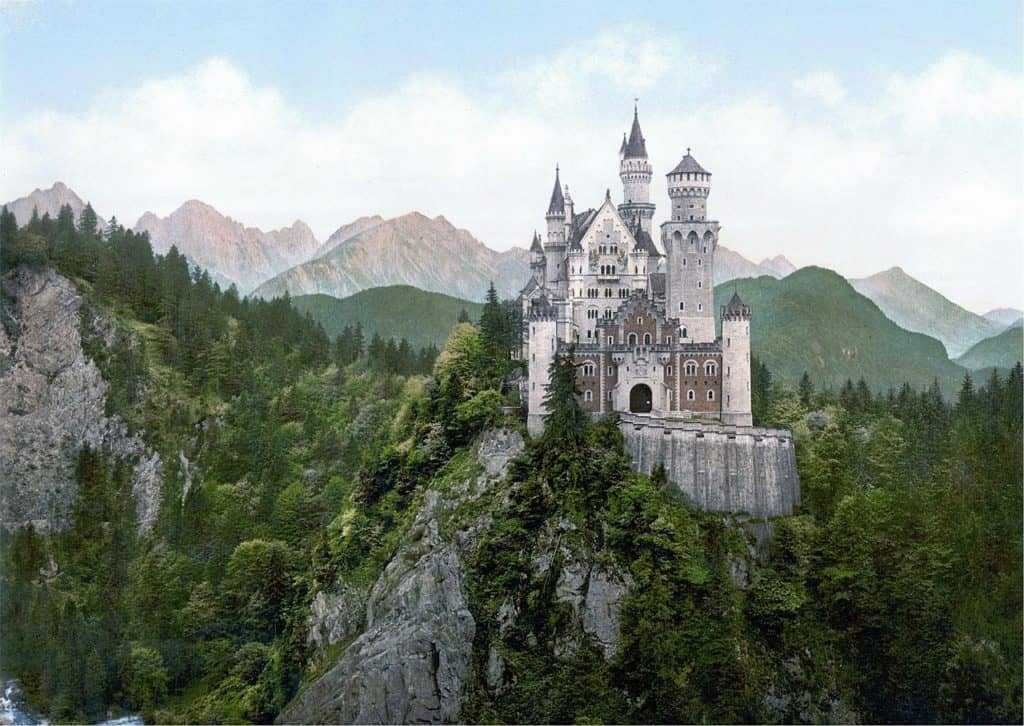
How to get to Neuschwanstein Castle: there are paid parking lots right in the village of Hohenschwangau. From the ticket office, it’s about a 30-minute uphill walk to the castle. You can also take the bus for a fee (buy your ticket from the driver).
Tickets for Neuschwanstein: the castle is extremely popular and in high season tickets sell out weeks in advance. Book well in advance.
9. Hohenschwangau Castle
Hohenschwangau towers above the village of Hohenschwangau, surrounded on all sides by beautiful nature.
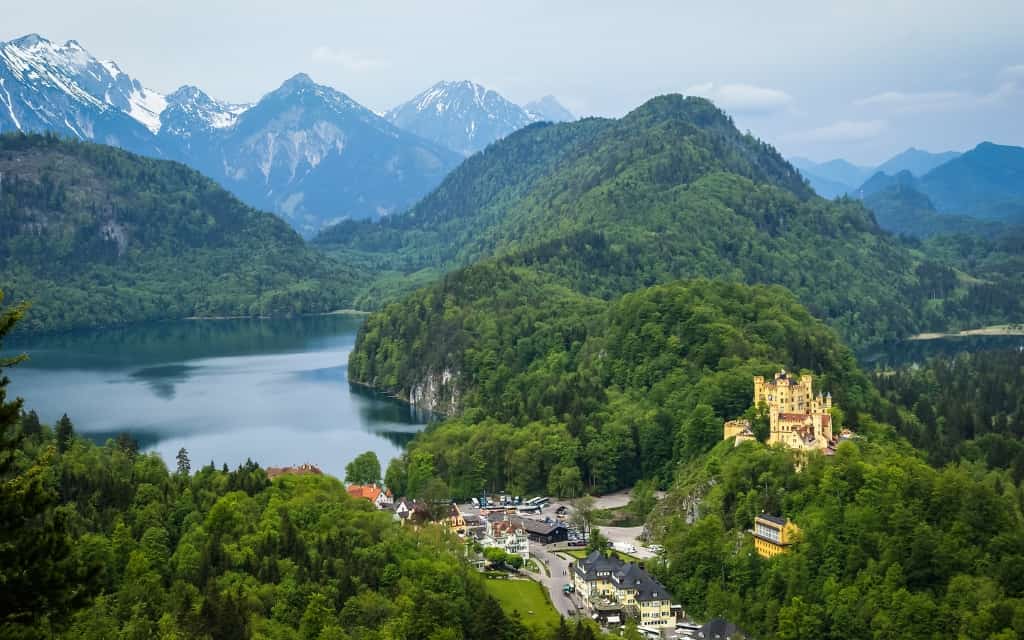
The history of Hohenschwangau Castle dates back to the 12th century, although the current building dates mostly from the 19th century. After centuries of war and neglect, the castle was in ruins when it was discovered by King Maximilian II of Bavaria, father of King Ludwig II. Maximilian bought the ruins in 1832 and had the castle restored.
How to get to Honeschwangau Castle: The castle is located a short distance from Neuschwanstein Castle. Parking and ticket sales are shared with Neuschwanstein Castle.
Tickets: Hohenschwangau Castle is not as busy as Neuschwanstein Castle. Tickets can also be bought on the door, but if you want to be sure, book here .
10. Höllentalklamm
The Höllentalklamm is another of the breathtaking gorges located near the town of Garmisch-Partenkirchen, not far from the Partnachklamm Gorge.
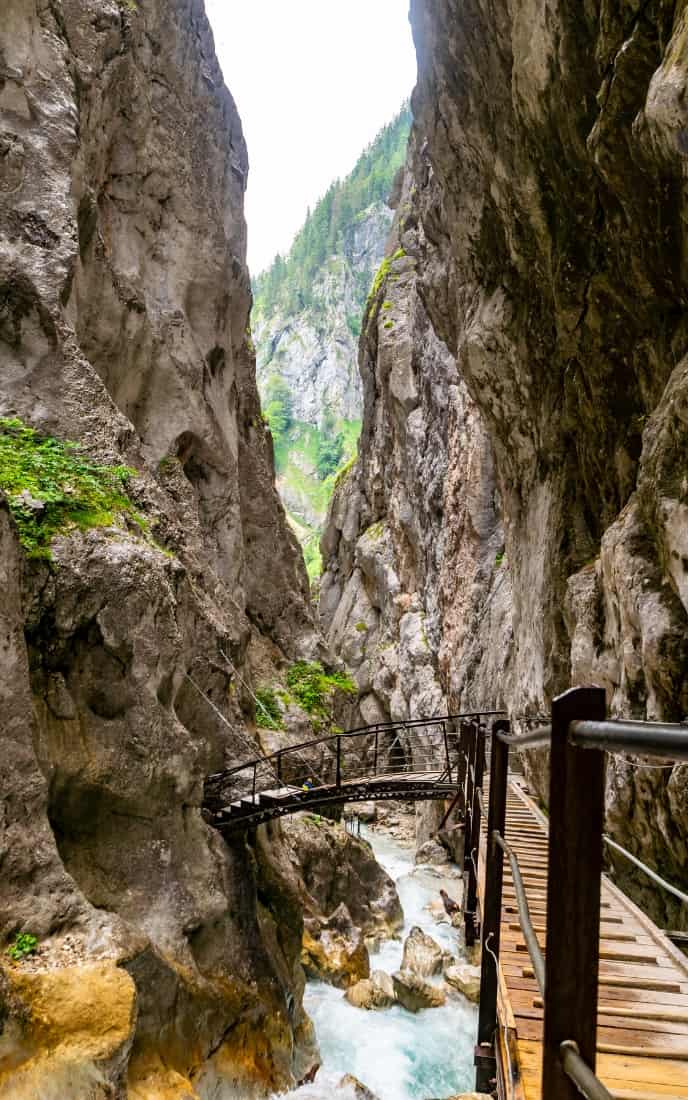
The confluence was created by the Hammersbach River and is known for its high waterfalls, deep pools and steep rock walls. It is approximately 1 kilometre long and reaches a depth of over 150 metres.
Unlike the previous gorges, you can only explore the Höllentalklamm from May to October. It is often part of longer hikes around the Wetterstein mountain range, which is part of the northern limestone Alps.
Here you can find the current opening hours and entrance fees for the Höllentalklamm .
11. AlpspiX viewpoint
The AlpspiX viewpoint is one of the most popular excursions in the Garmisch-Partenkirchen area. The Alpspitzbahn cable car will take you to the top or you can make the ascent in 2-3 hours. The views from here are fantastic and there are other hiking trails and a ferrata to the top of the Alpspitze.
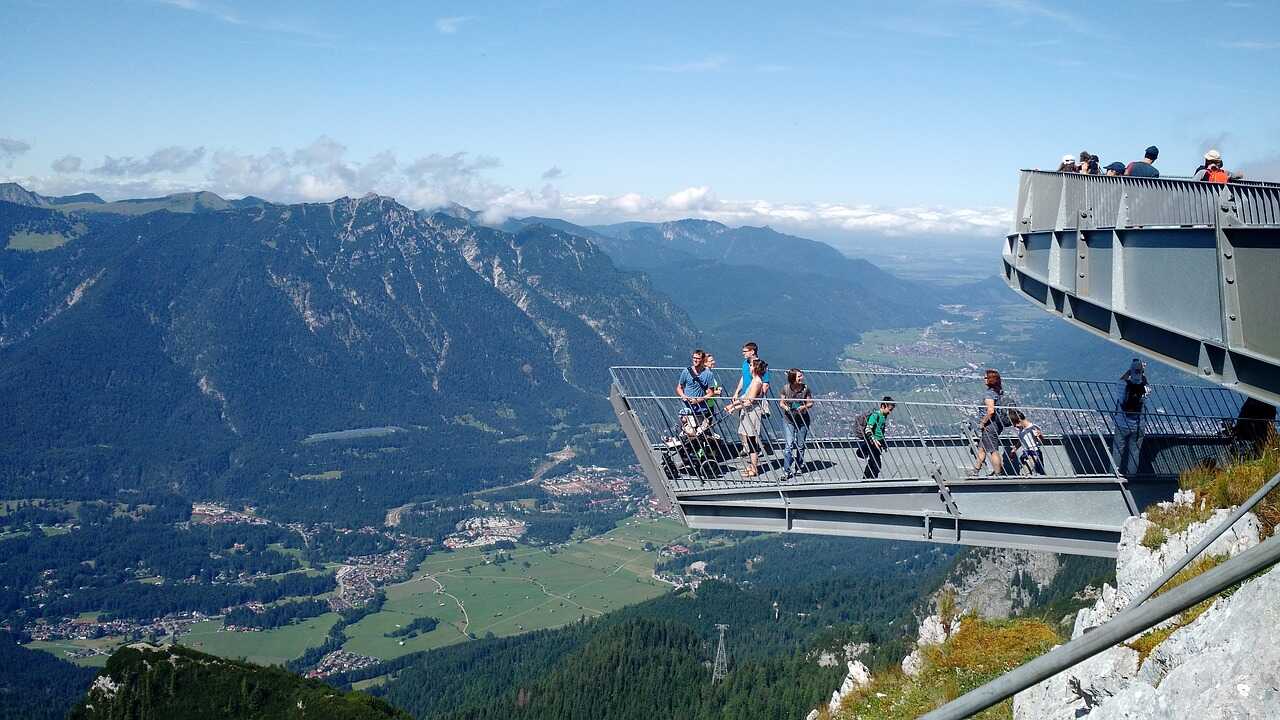
HOTELS GARMISCH-PARTENKIRCHEN 😴
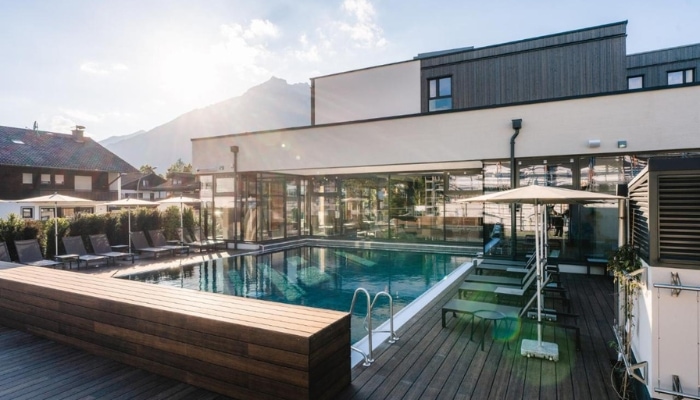
aja Garmisch-Partenkirchen
Stylish hotel with swimming pool
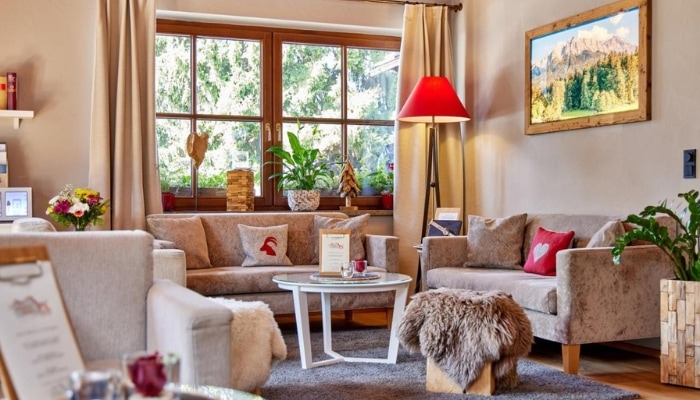
Hotel Zugspitze
Traditional Alpine hotel
12. Linderhof Castle
Linderhof Castle is one of the three castles built by King Ludwig II of Bavaria, along with Neuschwanstein Castle and Herrenchiemsee Castle. Linderhof is the smallest of these and the only one completed during the lifetime of King Ludwig II.
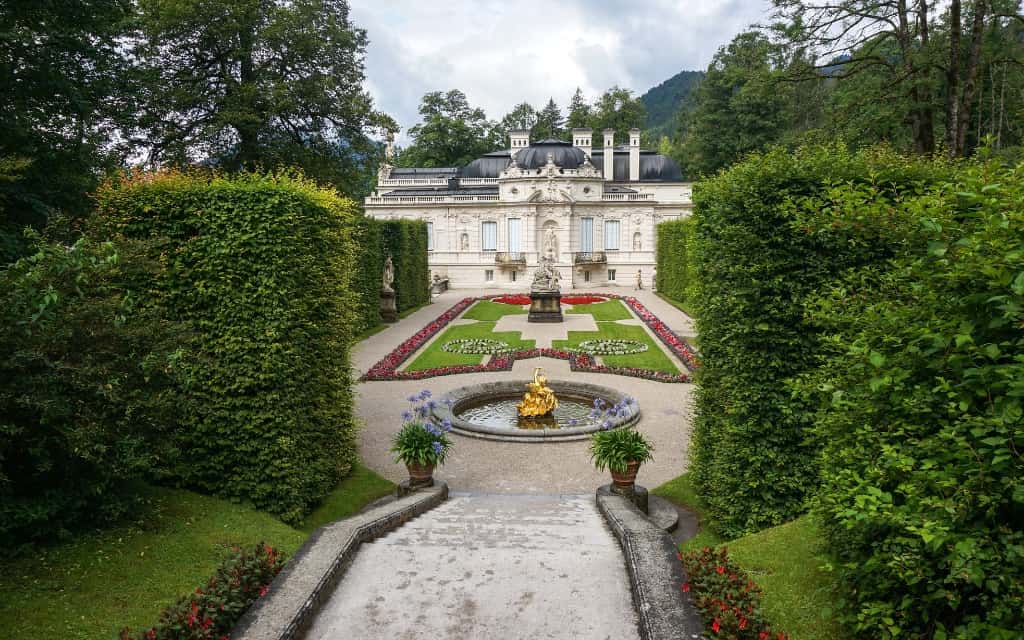
It is located in a valley near the village of Ettal. The architecture and decoration of the French chateau of Versailles were the inspiration for the construction of Linderhof.
Around the castle is a large and beautifully maintained castle park, which is full of fountains, terraces, statues and even an artificial cave.
Here you will find the latest information on admission fees and opening hours of Linderhof Castle.
How to protect yourself when travelling by car : Auto insurance provides you with car insurance to get your car repaired, towed to a garage, transported back home or a replacement vehicle if needed. They will arrange and communicate everything for you.
13. Walchensee
Walchensee is one of the largest and deepest alpine lakes in Germany, located about 75 km south of Munich.
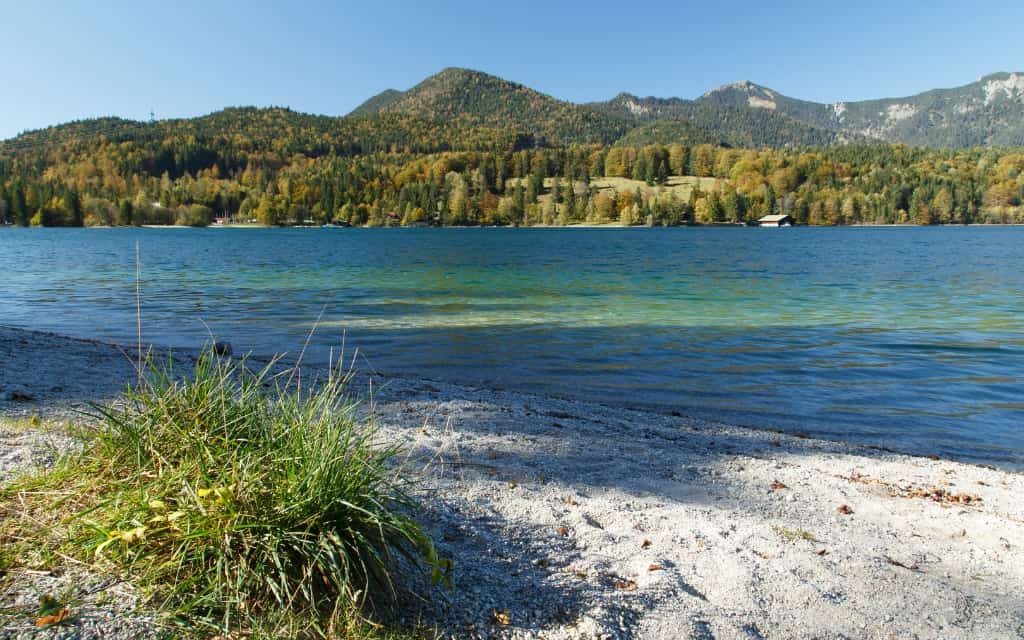
The lake is an ideal base for exploring the surrounding area and various water activities, including swimming, diving, boat or pedal boat hire. Everything you need is nearby, including shops and restaurants.
An interesting feature of the Walchensee is the Walchenseekraftwerk, a hydroelectric power station that uses the difference in altitude between the Walchensee and the Kochelsee below to generate electricity. The power station is an important industrial heritage site – if you want to find out more, the power station is open for tours .
14. Jochberg
The Jochberg is not one of the highest peaks in the area with its height of 1,567 metres, but the views of the Walchensee are fantastic.
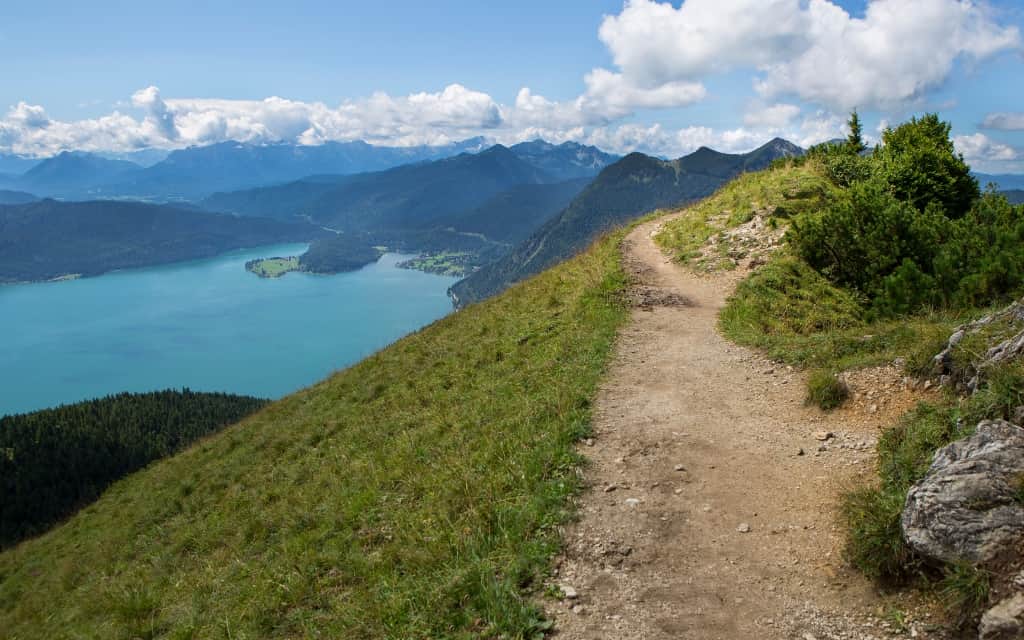
The ascent to the Jochberg is relatively straightforward, with well-marked trails, where some sections can be more challenging, but it is still a very doable route. From Walchensee you are at the top in about 1.5 hours.
A short walk from the summit, you can refresh yourself in the Jocheralm mountain hut.
15. Herzogstand
The Herzogstand is a mountain peak on Lake Walchensee, from which there are further fantastic views of the lake and the surrounding area.
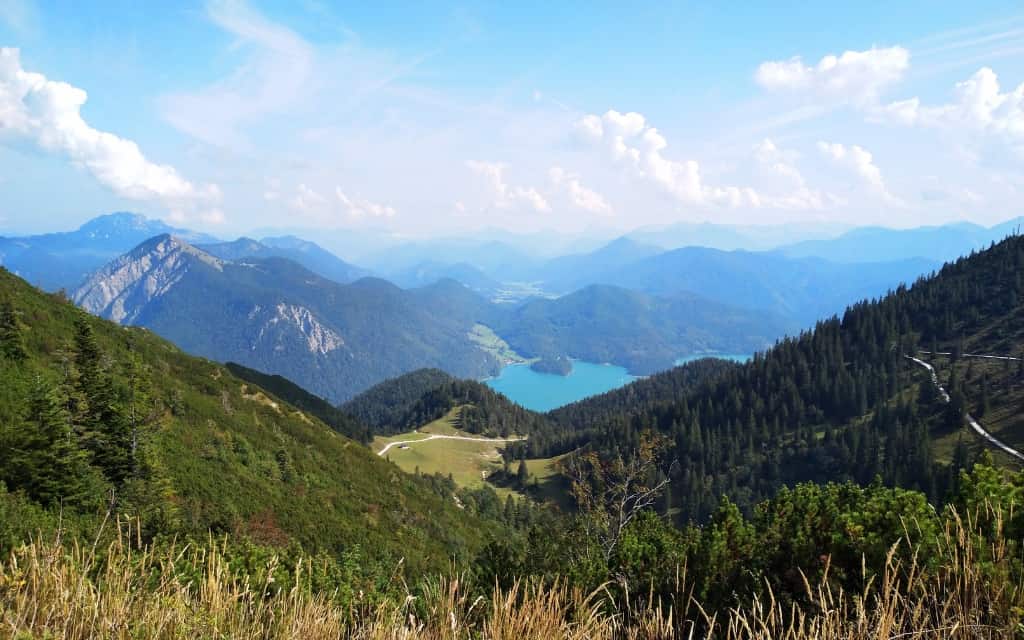
The easiest way to get up is by the Herzogstandbahn, which runs from Walchensee to the mountain hut near the summit.
A trail leads from the mountain hut to the summit, where there is a viewing platform with panoramic views of the surrounding mountains and Lake Walchensee. The journey from the mountain hut to the summit takes about an hour and is not difficult.
Hotels Walchensee:
- Alphotel Ettal: Traditional Alpine hotel in the middle price range
- Danner-Hof: Stylish hotel with excellent breakfast and wellness
- Klosterbräu Schlehdorf: Cosy, modern hotel with great value for money
16. Leutaschklamm
The Leutaschklamm, also known as the Leutascher Geisterklamm, is a beautiful gorge near the town of Mittenwald. This gorge is famous for its steep rock walls, clear waters of the turquoise blue mountain river and beautiful waterfalls.
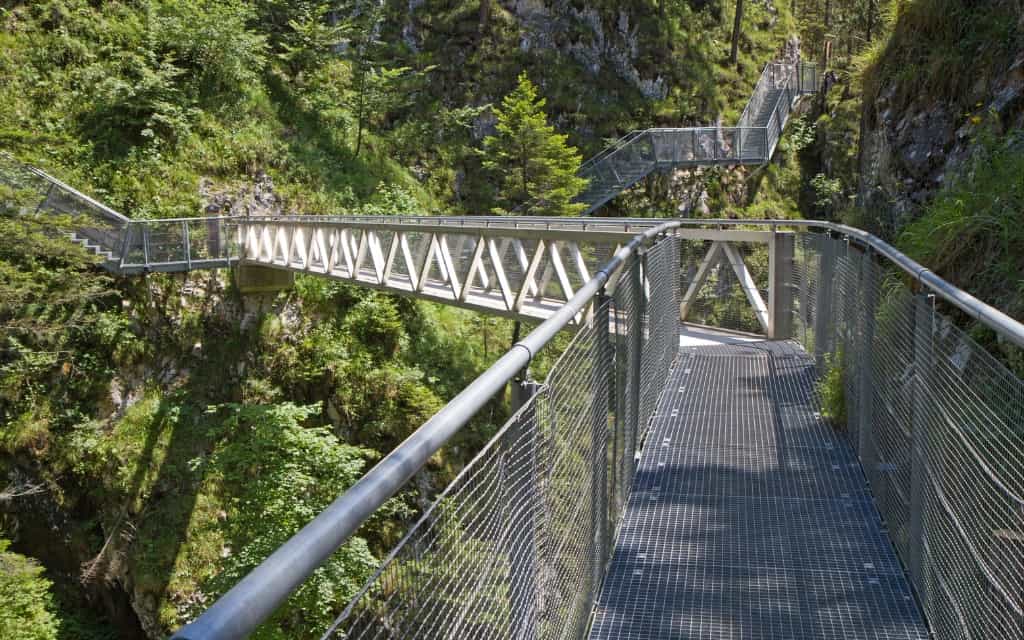
There are two routes through the Leutaschklamm Gorge to choose from – both are easy and partly over metal bridges high above the river, where you can see everything that is happening below you. The tour takes about 1-1.5 hours and is suitable for families with children.
Entrance to the Leutaschklamm is free, there is a paid parking lot at the entrance.
17. Rossfeld Panoramastraße
Rossfeld Panoramastraße is the highest panoramic road in Germany, 15.4 km long.
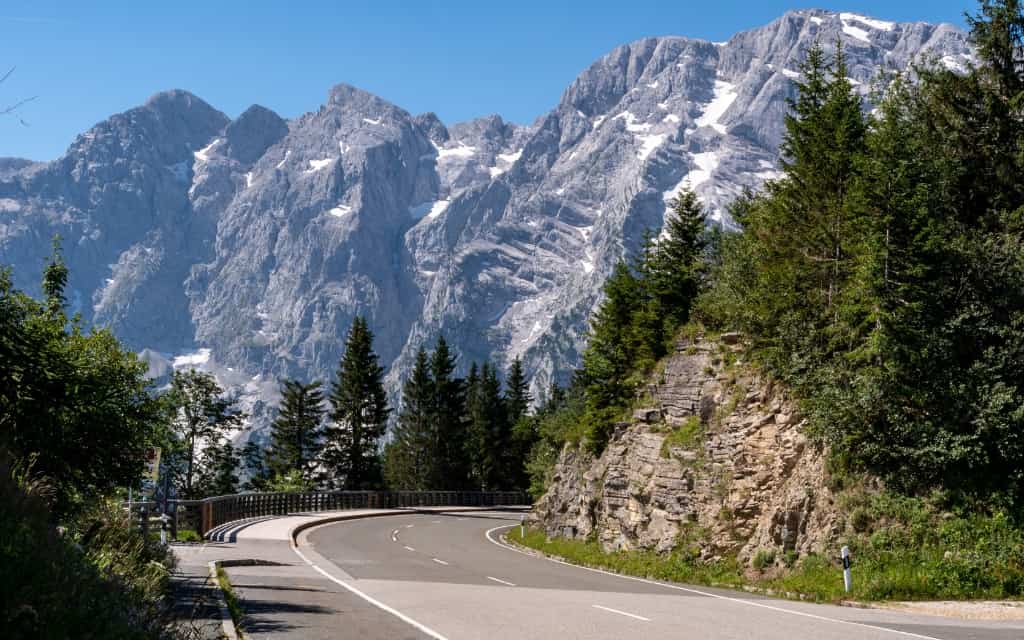
The road is beautiful in itself, but if you want more, you can stop along the way and enjoy a hike in the Berchtesgaden Alps.
On this link you will find the current price list for the Rossfeld Panoramastraße.
18. Königssee and Obersee
Most people go to Austria for the most beautiful alpine lakes. What they may not know is that Germany also has two gems on its territory – Lake Königsee and Lake Obersee in the Berchtesgaden National Park. Both lakes are extremely popular, so it’s a good idea to arrive as early in the morning as possible.
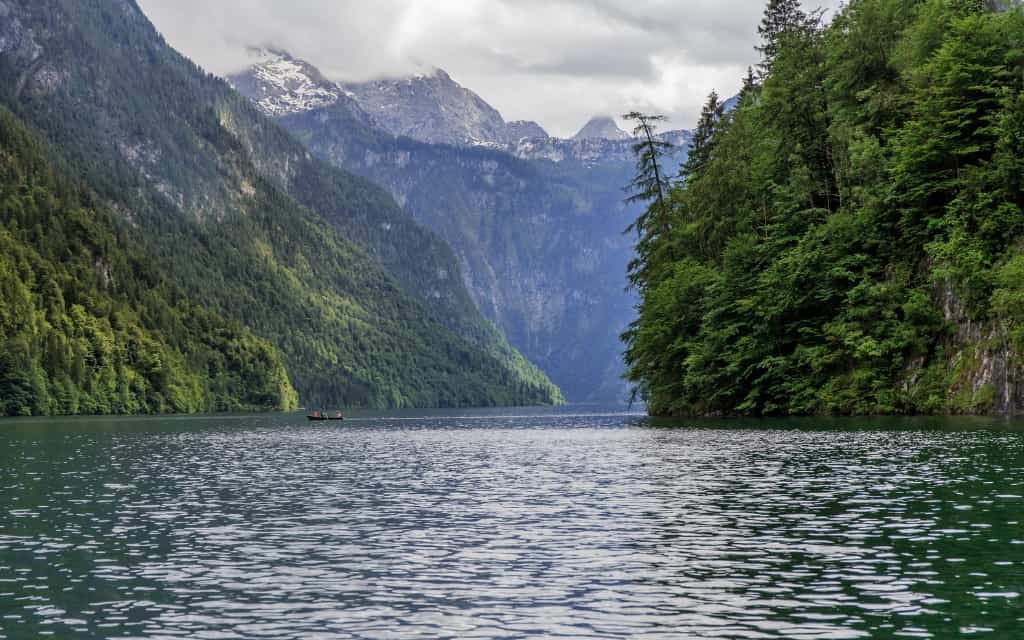
Route around Königsee
There are hiking trails around the lake, which offer the best views of the lake. The easy route leads directly from the car park, from where you turn left to the Jaenerbahn cable car along the Malerwinkel trail. The circular route is 1.5 kilometres long and is also suitable for children.
Boat cruise on the Königsee
Königssee is famous for its deep, clear blue water and is surrounded by high mountains that create a dramatic scenery. One of the lake’s most famous features is the Church of St. Bartholomew, a baroque chapel with a red onion-shaped roof that is accessible only by boat.
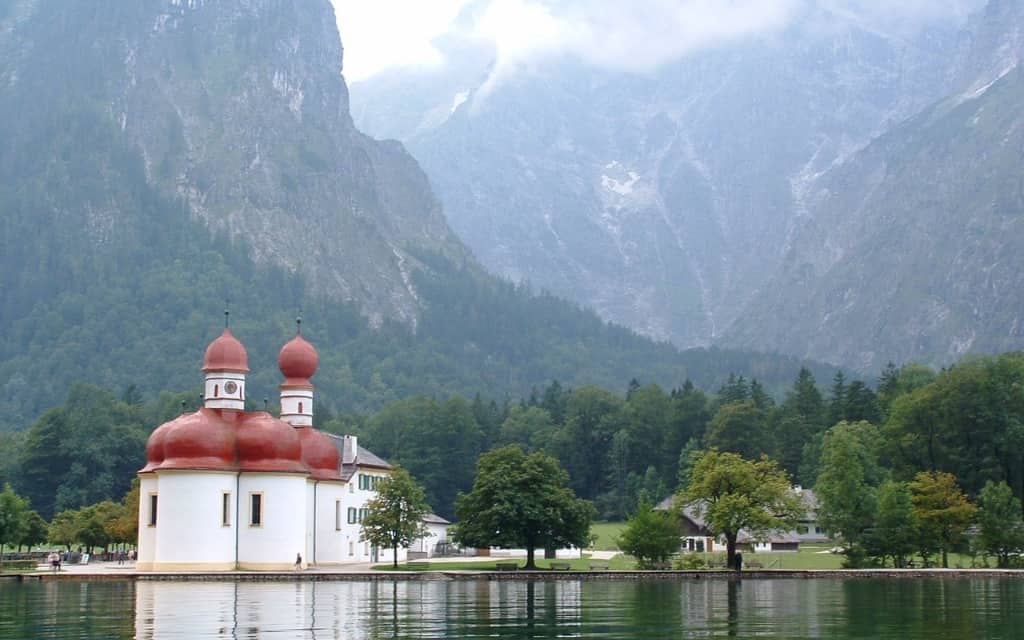
You can take a boat trip on the Königsee, which is powered by electricity and departs at regular intervals of a quarter or half an hour (depending on the season).
If you arrive by car, there is a large, paid parking lot at Königsee. The boat stops at 3 places – Kessel (a stop on the means, ideal for trekking up the mountains), at St Bartholomew’s Church where you can walk around the promenade and then visit the ice cave, and in Salet, from where it’s a short walk to Lake Obersee (for us we had to change to another boat at St Bartholomew’s Church to get to Salet, but maybe it’s already connected).
At this link you will find up-to-date information on admission fees and timetables for the Königsee.
The Obersee is a small lake known for its turquoise water, into which a mountain face slopes down on one side. You can walk around the lake from the right to an old mountain pasture known as the Fischunkelalm, a short distance from which there is a beautiful waterfall.
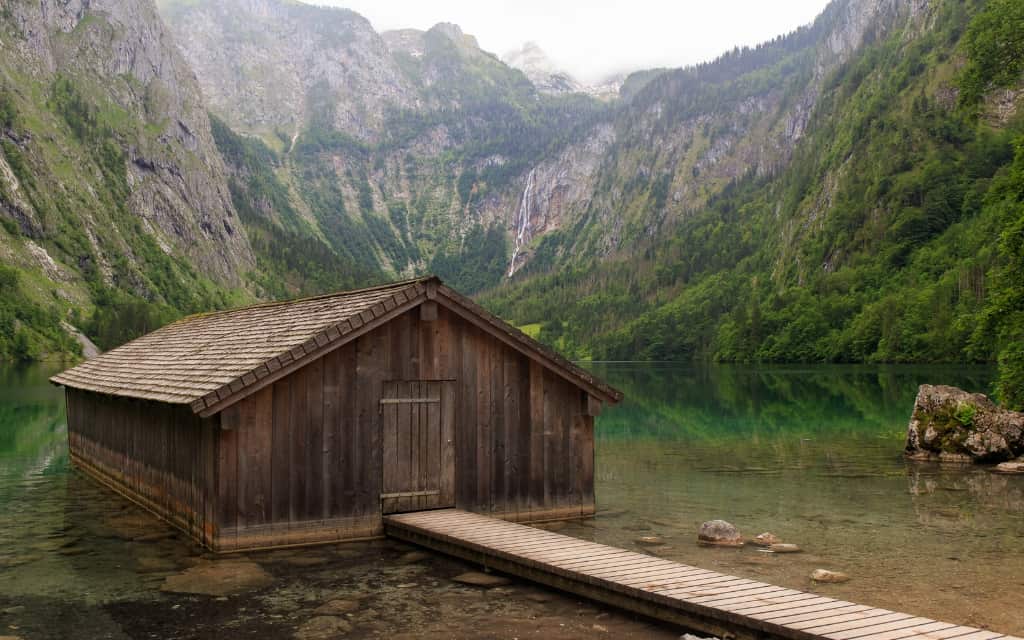
19. Almbachklamm
Near the Austrian border, in the Berchtesgaden National Park, is the Almbachklamm Gorge.
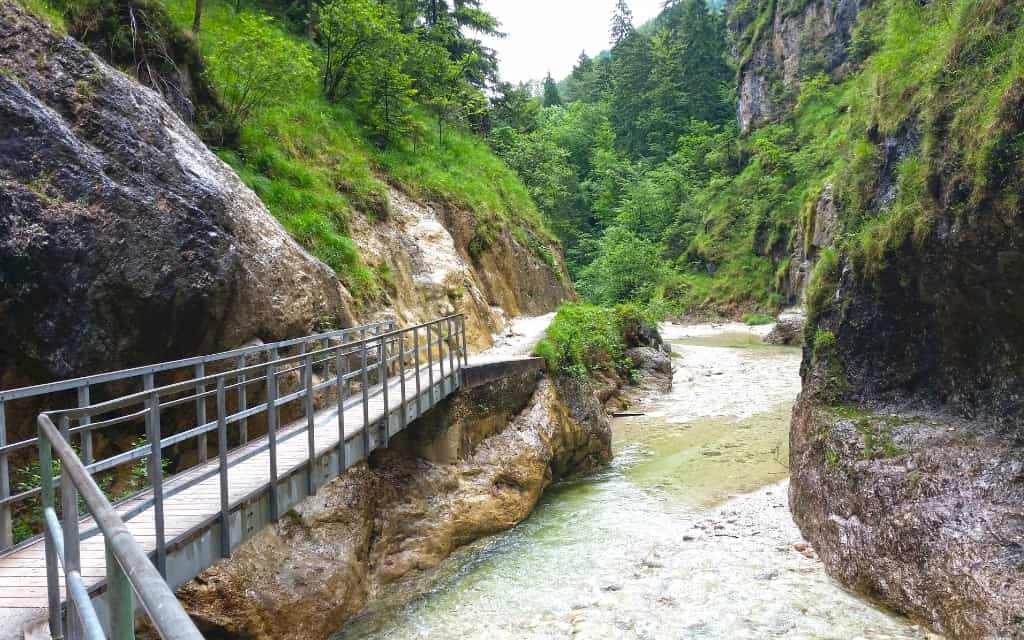
The confluence is created by the Almbach River, which cuts through the valley and creates a breathtaking terrain full of waterfalls, fast currents and steep rock walls. Almbachklamm is famous for its highest waterfall, Theresienklause, which is almost 70 metres high.
The route is about 3 kilometres long, the most interesting part is 1.5 km long. You can explore the gorge from every angle using walkways, bridges and tunnels.
The gorge is open from May to October. Here you will find the current opening hours and entrance fees to Almbachklamm .
20. Hintersee
Behind the picturesque village of Ramsau bei Berchtesgaden lies the Hintersee, which is very easily accessible. You can park directly at the lake if you are not staying nearby. Stroll around the lake or head into the heart of the Berchtesgaden Alps.
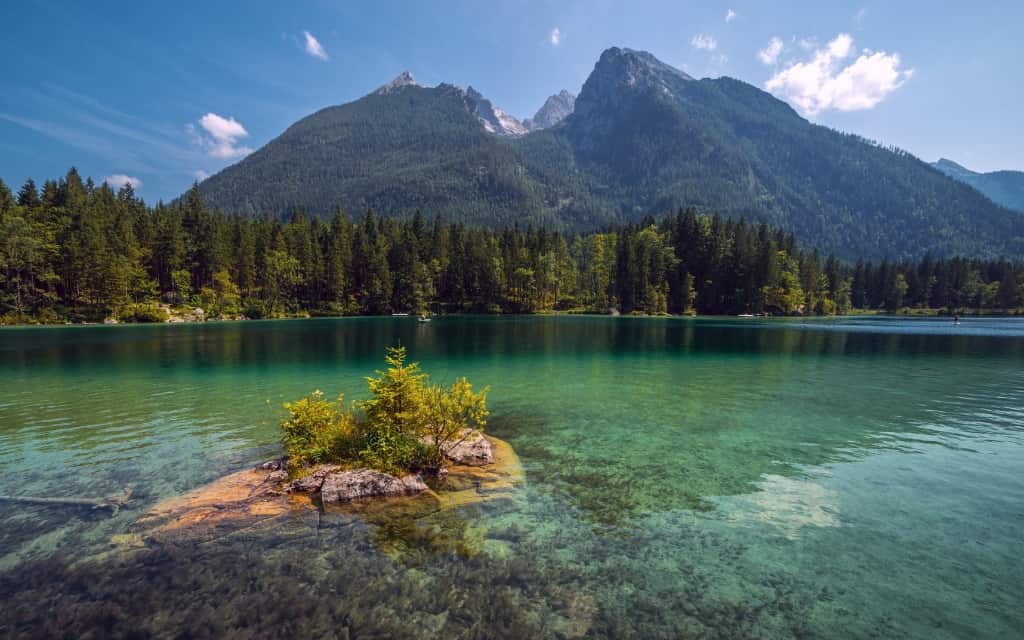
21. Herrenchiemsee Castle
Herrenchiemsee Castle, also known as the New Herrenchiemsee Palace, is the last of the three castles built by King Ludwig II of Bavaria. It is located on the island of Herreninsel on Lake Chiemsee, the largest lake in Bavaria.
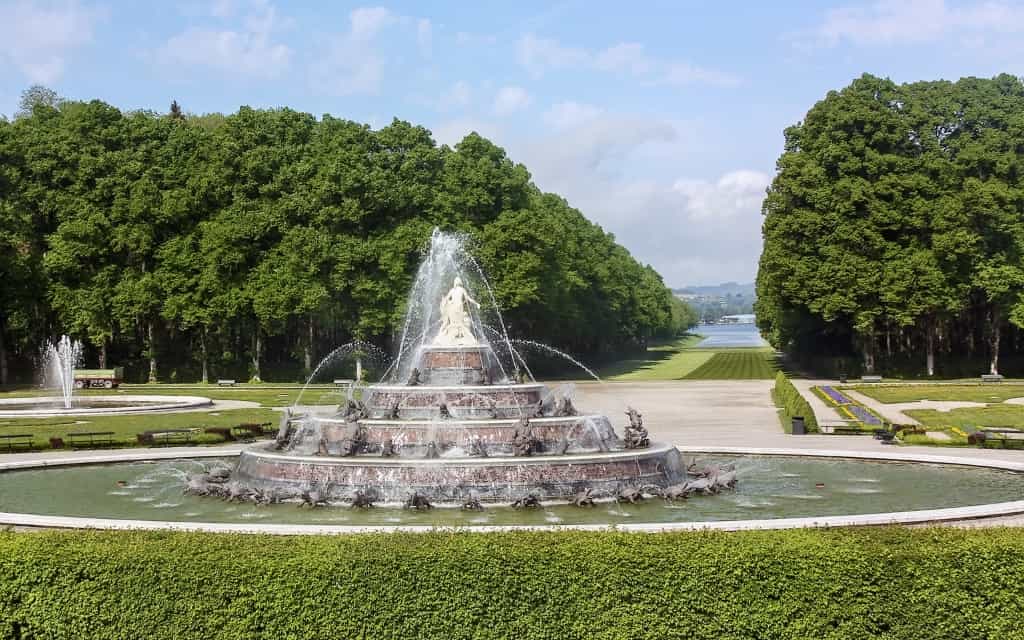
Like Linderhof Castle, Herrenchiemsee Castle was inspired by the French palace at Versailles and was intended as a tribute to King Louis XIV, who was admired by King Louis II.
The castle has similar architecture and extensive gardens full of fountains and statues. Inside, it houses ornate interiors and the Hall of Mirrors, which is a replica of the Hall of Mirrors at Versailles.
How to get to Herrenchiemsee Castle: you will find the castle right on Lake Chiemsee. The castle can only be reached by boat from several villages around Chiemsee. The castle is most easily reached from Prien am Chiemsee, where there is a paid parking lot.
Tickets: here you can find the latest information about entrance fees and opening hours.
22. Salt mine Salzbergwerk Berchtesgaden
The Salzbergwerk Berchtesgaden, also known as the Berchtesgaden Salt Mine, is one of the oldest active salt mines in the world.
The mine was founded in the 12th century and has played a key role in the region’s economy throughout its long history. Today it is a popular attraction where you can learn more about the importance and history of salt mining.
Enjoy a ride on the mine train, ride down the long wooden chutes that were once used to transport miners, and cruise across the underground salt lake. Ideal place for families with children.
At this link you will find the current opening hours and admission fees for the Salzbergwerk Berchtesgaden .
23. Eagle’s Nest
The Eagle’s Nest (Kehlsteinhaus) is the former retreat of Adolf Hitler, located on the top of the Kehlstein mountain near Berchtesgaden.
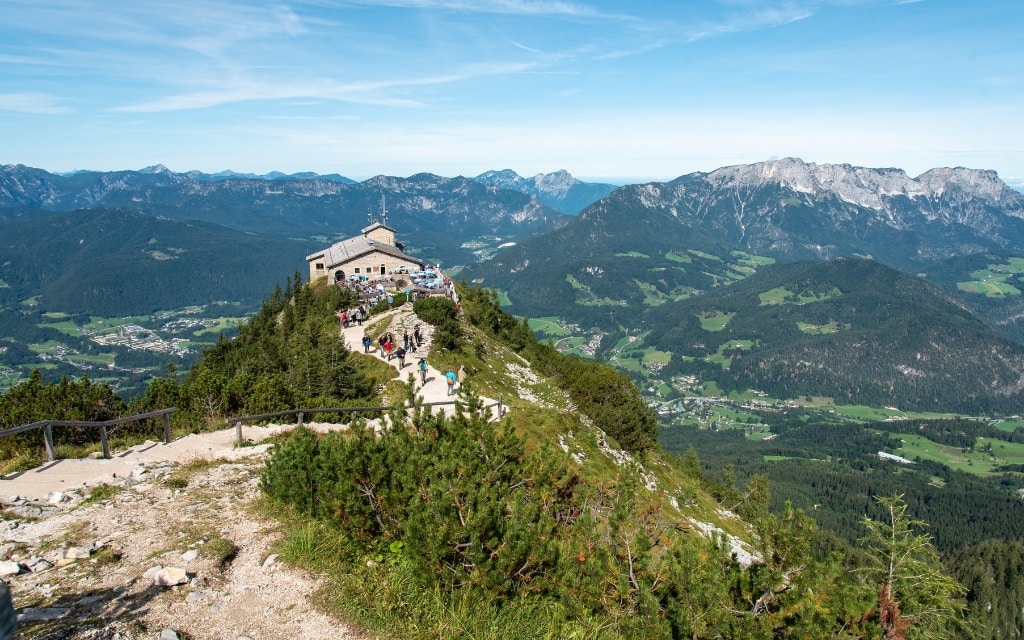
After World War II, the building was spared from bombing because it was difficult to see from the air. After the war, the Kehlsteinhaus was opened to the public as a restaurant and lookout. There is also a museum documenting the history of the area during the Nazi era.
How to get to the Eagle’s Nest: The Kehlsteinhaus can be reached by bus from the car park – preferably first thing in the morning, as it is already crowded in the morning. From the bus, you go through a tunnel to the historic elevator, which takes you to the top.
The other option is to walk – allow about 2 hours for the ascent.
Tip : This popular day trip from Prague includes a visit to the Eagle’s Nest and Lake Königssee.
More information about the Eagle’s Nest can be found on the official website .
HOTELS BERCHTESGADEN 😴
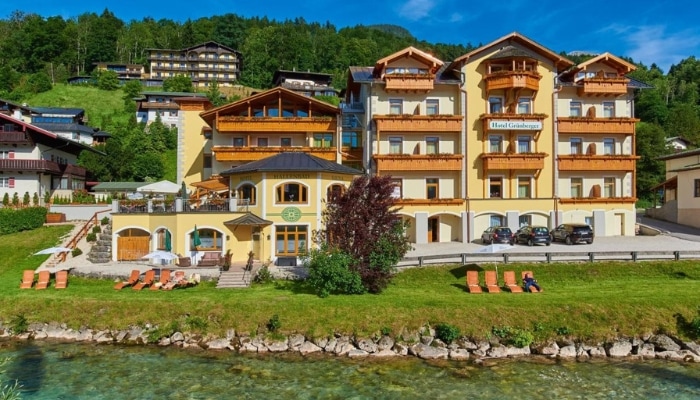
Hotel Grünberger superior
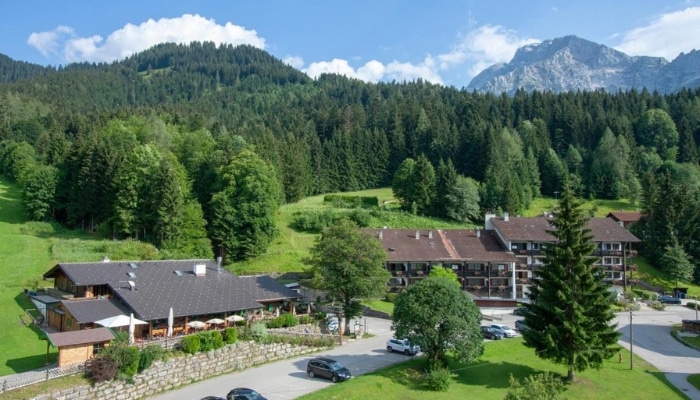
Alpenresidenz Buchenhöhe
Modern hotel with wellness
German Alps – map
HOW TO USE THIS MAP: Above you will find a detailed map of things to do in the Bavarian Alps in Germany. Click at the top left of the map to see separate layers with highlighted locations. You can hide and show the different layers or click on the icons on the map to see the names of the places mentioned in the Bavarian Alps guide. If you want to save the map, star it. It will then be saved to your Google Maps and can be retrieved at any time on your mobile phone or computer. For a larger version of the map, click on the icon in the top right corner.
This was our hiking tips and things to do in the Bavarian Alps in Germany. Do you have a question? We’ll be happy to answer it in the comments below. Have a safe journey!

More information about Germany
GERMANY: Get inspired with tips on things to do in Germany.
BERLIN: Berlin has something for everyone – take your pick from our tips on what to see in Berlin .
HAMBURG: Hamburg is considered by some to be the most beautiful city in Germany. Take a look at our tips on things to do in Hamburg and form your own opinion.
DRESDEN: Dresden is one of the most beautiful cities in Germany – here are tips on things to do in Dresden .
AUSTRIAN ALPS: Here are the things to do in the Austrian Alps. Or head straight to Tyrol or the High Tauern National Park. Other popular destinations in the Austrian Alps are the Dachstein mountain range or the beautiful Lake Achensee .
Zell am See is one of the most popular areas to stay in the Austrian Alps. Here is a detailed travel guide and things to do at Zell am See .
Wolfgangsee is one of Austria’s most beautiful lakes, with swimming opportunities and plenty of activities in the surrounding area.
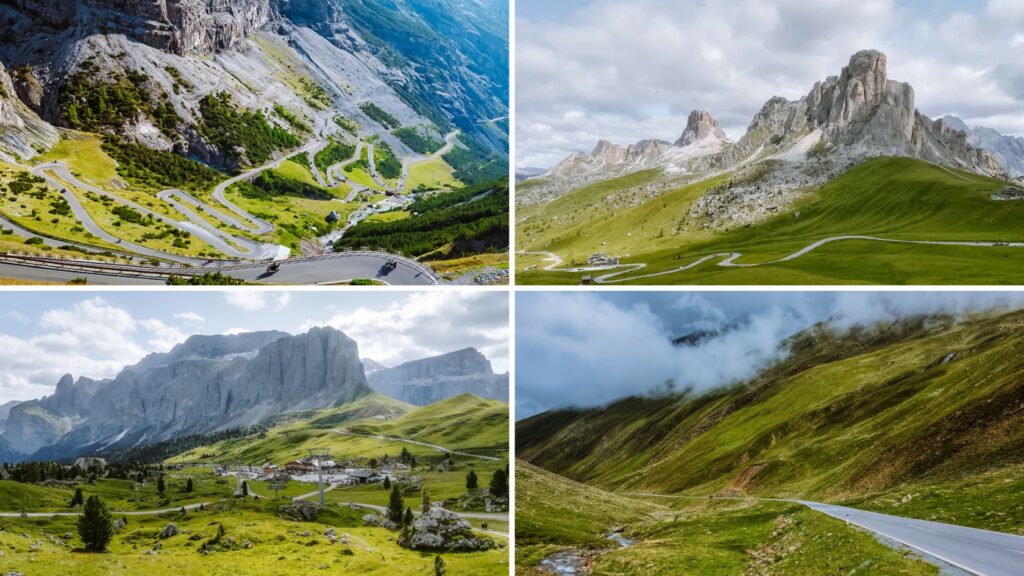
What are the most beautiful alpine roads in Austria and Italy?
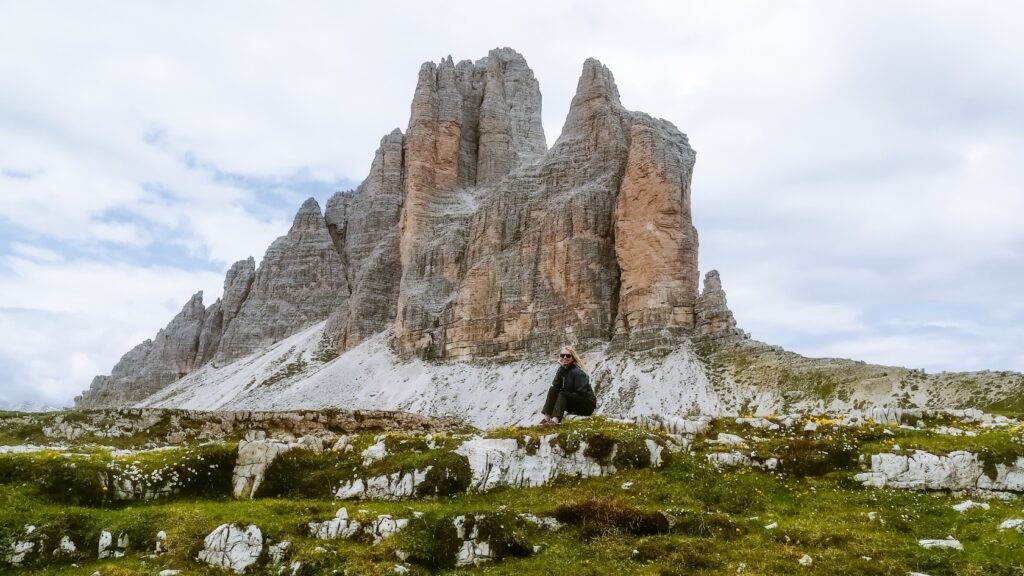
Tre Cime di Lavaredo – Sexten Dolomites (2024): 7 tips for the most beautiful treks and other practical information
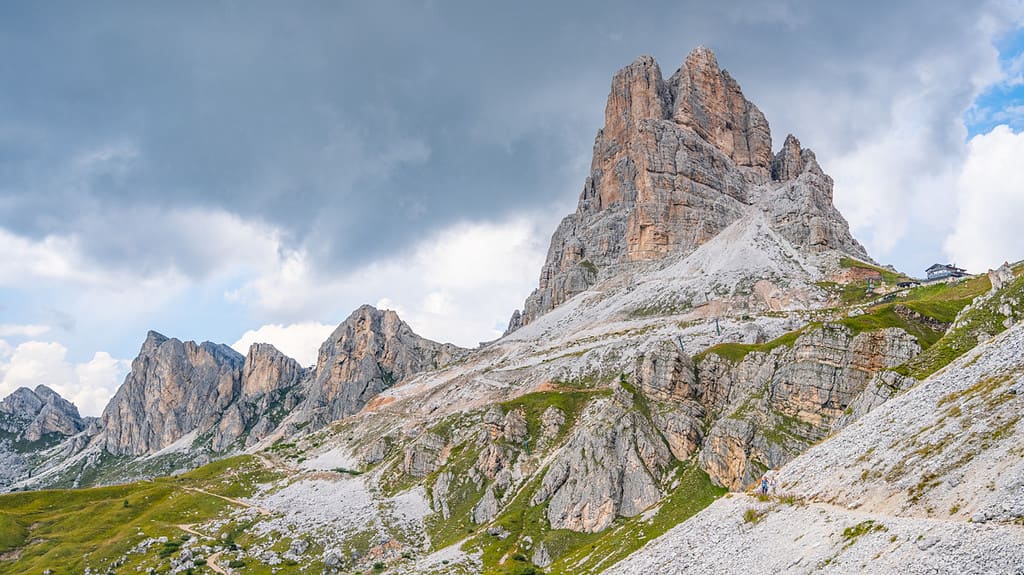
Dolomites, Italy: Guide to the perfect holiday in the Dolomites
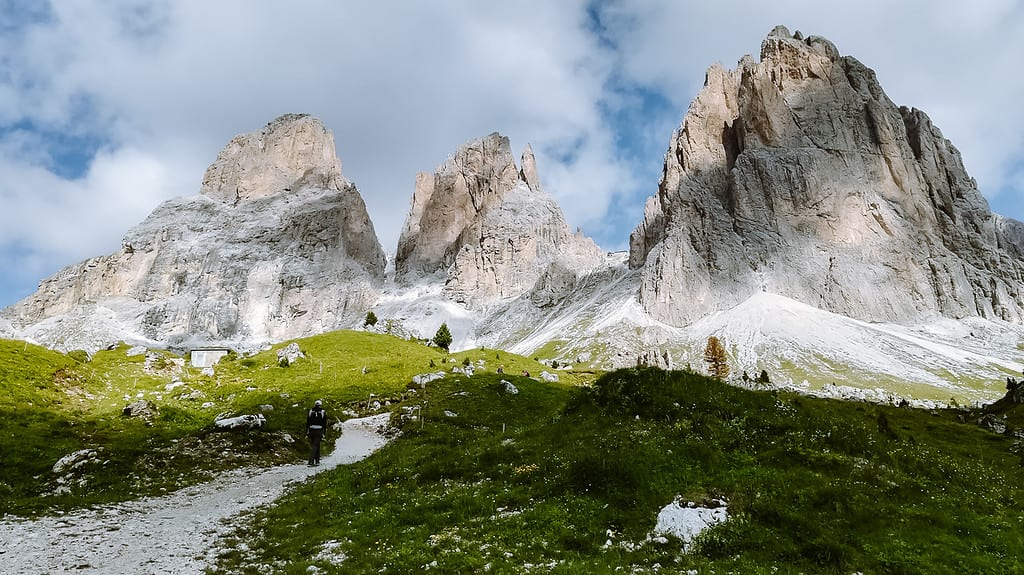
Dolomites, Italy: 20 tips for hikes, walking routes and things to see (2024)
Leave a comment cancel reply.
Your email address will not be published. Required fields are marked *
Start typing and press enter to search

17 Top-Rated Attractions & Things to Do in Bavaria
Written by Barbara Radcliffe Rogers Updated Apr 13, 2023 We may earn a commission from affiliate links ( )
Bavaria, Germany's largest state, lies in the southeast corner of the country and is bordered by Austria and the Czech Republic. One of Germany's most popular tourist destinations , Bavaria is filled with attractions and things to do and offers some of the country's most beautiful scenery, including spectacular mountain peaks, rolling hills, and lovely lakes.
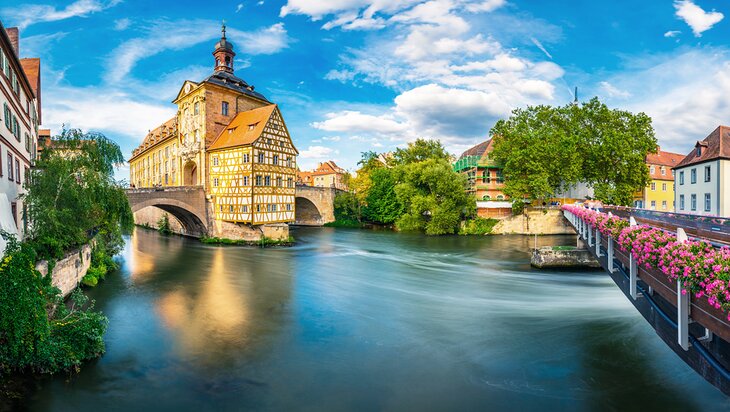
Alpine peaks mark Bavaria's southern border with Austria, and the Danube River winds scenically through its center. Sightseeing is not the only attraction of Germany's largest state: outdoor enthusiasts will find mountain trails to hike, riverside paths to cycle, and superb skiing . Some of the most beautiful towns in Germany are in Bavaria, and the entire area is steeped in history.
The Danube winds scenically through its center. Some of the most beautiful towns in Germany are in Bavaria, and the entire area is steeped in history.
Although Bavaria is one of the most traditional parts of Germany and is filled with romantic castles, grand imperial palaces, and endearing old-world customs, you'll find a lot more variety among its attractions, including a lively contemporary art scene, cutting-edge architecture and design, and state-of-the-art interactive museums.
You could easily spend an entire vacation here. Find the best places to visit with our list of the top attractions and things to do in Bavaria.
Neuschwanstein
Watch the glockenspiel in marienplatz, munich, explore zugspitze and the bavarian alps, nymphenburg and the residenz, munich's royal palaces, tour nürnberg castle and altstadt (old town), relax in the englischer garten (english garden), munich, rothenburg and the romantic road, visit linderhof palace, königssee and kehlsteinhaus (eagle's nest), dachau concentration camp memorial, take a boat to herrenchiemsee, imperial regensburg, bamberg cathedral, hike through the partnach gorge, passau and the danube, art museums in munich's kunstareal district, cruise through the danube gorge from weltenburg abbey, map of attractions & things to do in bavaria.
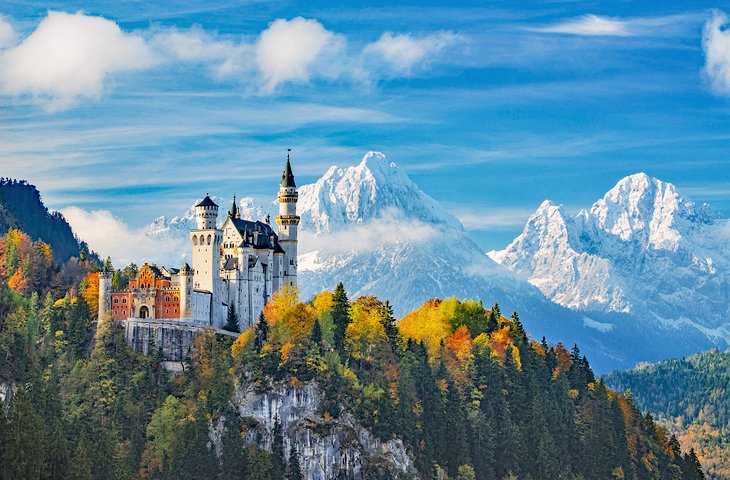
Perhaps "Mad" King Ludwig II was eccentric in his choice of a fairy-tale-inspired neo-Romanesque style for his castle, but his choice of setting was pure genius. The spires and towers rise from a rocky crag above a forest and lake, with a panorama of the Bavarian Alps rising beyond.
Widely recognized as the inspiration for Walt Disney's theme park castles, Schloss Neuschwanstein is every bit as fantastical inside as it is when first viewed from below. The Throne Room, the Singers' Hall, and other grandiose rooms are sumptuously decorated (some might say over-decorated) in themes drawn from heroic legends, opera, and romantic literature. The views of the Alps from the windows are simply breathtaking.
On a facing crag is another castle of the imperial Wittlebach family, Hohenschwangau . Not far away is the king's hunting lodge, Linderhof , an equally fanciful architectural confection. You can combine tours of both King Ludwig's palaces with a stop in the beautiful Bavarian village of Oberammergau on a 10.5-hour Royal Castles of Neuschwanstein and Linderhof Day Tour from Munich .
Address: Neuschwansteinstraße 20, Schwangau
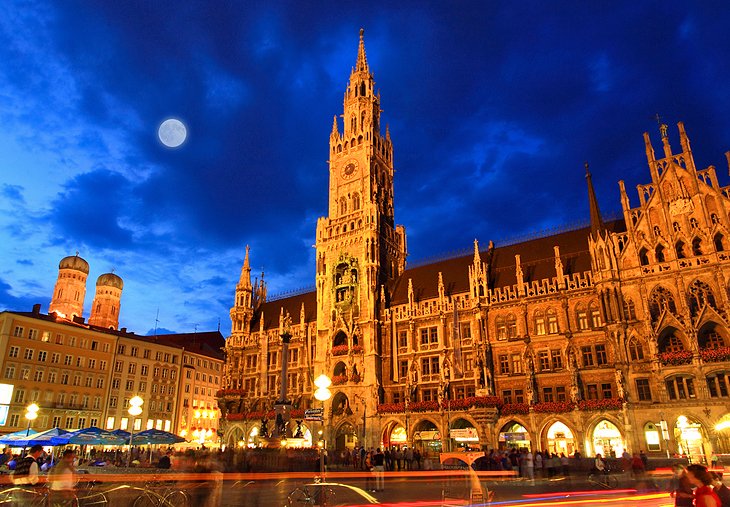
Munich, the capital of Bavaria, is the third largest city in the country and home to many of Germany's top tourist attractions . On the River Isar, along the fringes of the Bavarian Alps, it's one of the best places from which to explore Bavaria. A good place to start is Marienplatz , the city's large central square, one entire side of which is formed by the magnificent neo-Gothic facade of the Neues Rathaus (New Town Hall).
The glockenspiel, a huge clock animated with moving figures, performs every morning at 11am and at 5pm March through October, always drawing a crowd. One end of the immense square is formed by the stair-stepped façade of the Old Town Hall, and behind the other end of the square rises the distinctive twin-domed towers of the Frauenkirche , the Cathedral of our Lady.
A few steps from Marienplatz are two more of the city's most important churches: Peterskirche , built during the Romanesque period, and Michaelskirche , the largest Renaissance church north of the Alps. Marienplatz is the center for many of this always-busy city's cultural activities , from regular concerts and festivals to its fabulous Christmas Market .
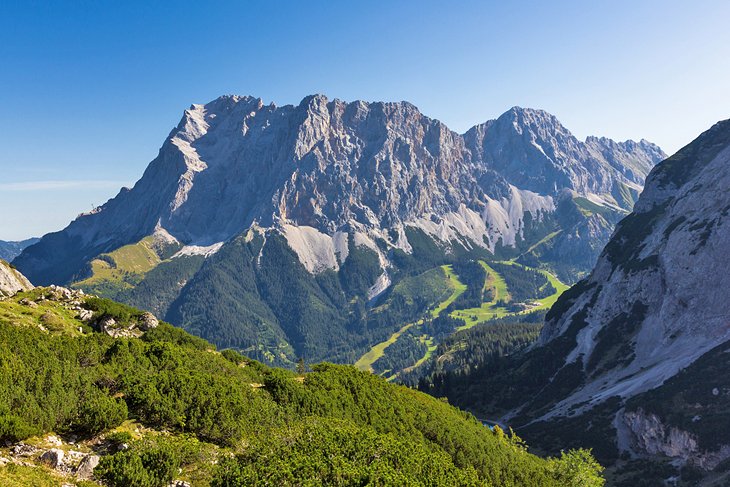
Bavaria's Zugspitze is part of the Wetterstein Alpine mountain range that spans the frontier between Austria and Germany. Surrounded by steep valleys, its 2,962-meter eastern summit is reached by cable car from Eibsee, or by the Bayerische Zugspitzbahn cog railway, a trip that begins in either Eibsee or in Garmisch-Partenkirchen. The cog train takes you to the Zugspitzplatt, from which a short cable car ride reaches the summit.
The mountain, Germany's tallest, is extremely popular among hikers and casual walkers alike, with numerous trails of all levels to choose from (those who want the views without the steep climb can ride up and walk down).
At the Zugspitz-Westgipfel Station is a panoramic restaurant at 2,950 meters. The nearby Schneefernerhaus on the northern edge of the Zugspitzplatt is a popular place for skiers to visit in the winter . The highest skiing area in Germany , it comes alive as winter sports enthusiasts from across Europe arrive for the superb snow and après ski activities.
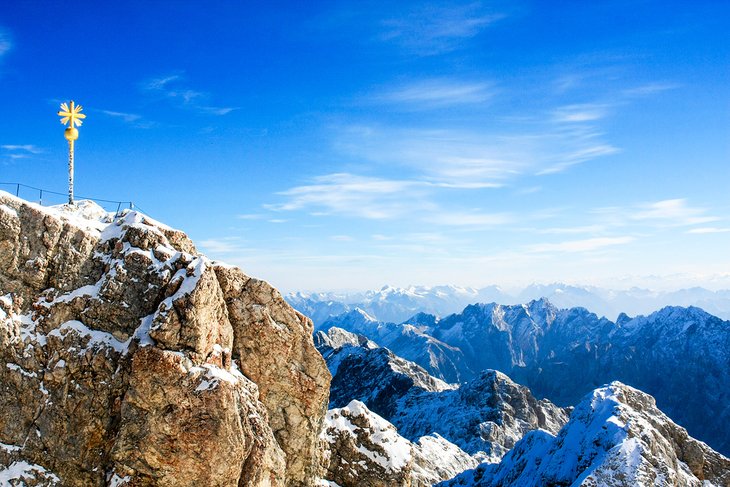
The Bavarian Alps extend south from Munich to the Austrian frontier and from beautiful Lake Constance in the west to the neighborhood of Salzburg in the east.
Reaching heights of almost 3,000 meters, their beauty enhanced by deep glacier-carved valleys and high plateaus with numerous lakes, the Bavarian Alps offer plenty of things to do. Along with winter sports, there are summer excursions of all kinds: forest walks, waterfalls, easy climbs, and gondola rides to spectacular views.
In the countryside, deep in its valleys, lie some of the most beautiful towns in Bavaria. Especially picturesque are the towns of Garmisch-Partenkirchen , Mittenwald, and Berchtesgaden , with their colorful painted houses and Baroque parish churches.
On a Zugspitze Day Tour from Munich , you can travel through the Bavarian countryside in an air-conditioned vehicle with a guide and take the cable car to the top of Zugspitze, riding back down on the cog railway.
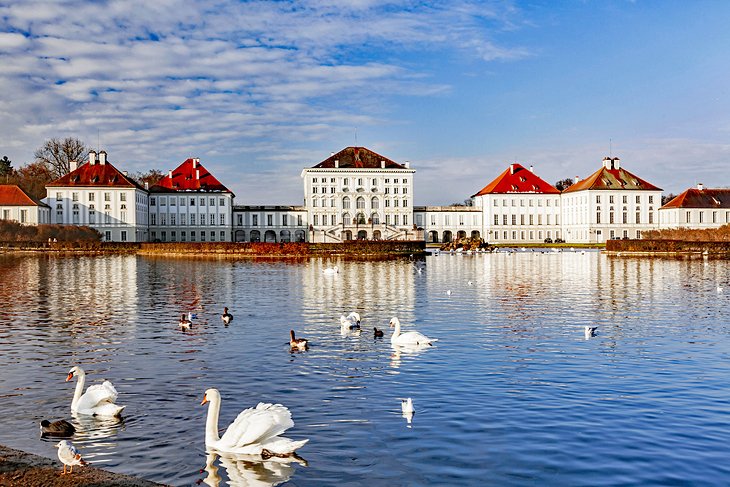
The Munich Residenz , the seat of the dukes, electors, and kings of Bavaria for centuries, is one of Europe's most spectacular palaces. In the summer, the royal family moved to their airy country palace of Nymphenburg, surrounded by magnificent gardens.
The vast in-town Residenz complex encloses seven large courtyards and has three main sections: the late Renaissance Alte Residenz ; the Königsbau ; and the Festsaalbau (Banqueting Hall), overlooking the Hofgarten . The magnificent 16 th -century Antiquarium is now part of the Residenz Museum . Highlights to visit here include the Treasury, the Court Church of All Saints (Allerheiligen-Hofkirche), and Cuvilliés-Theater, along with the old courtyards and the beautiful Court Garden.
There's a much different atmosphere at the later Baroque palace of Nymphenburg , which seems to float above its canal, gardens, and fountain-splashed pools. In the 17 th -century Central Pavilion , built in the style of an Italian villa, you'll find the lavishly decorated three-story Stone Hall (Steinerner Saal) and furnished private chambers.
In the outer buildings, you can visit the Palace Chapel and a collection of state coaches and carriages in the Marstallmuseum . For many, the highlights of Nymphenburg are its magnificent 17th-century gardens, with its formal bed, hedge maze, Palm House, and fountains, and the Amalienburg , a grand hunting lodge featuring a Hall of Mirrors.
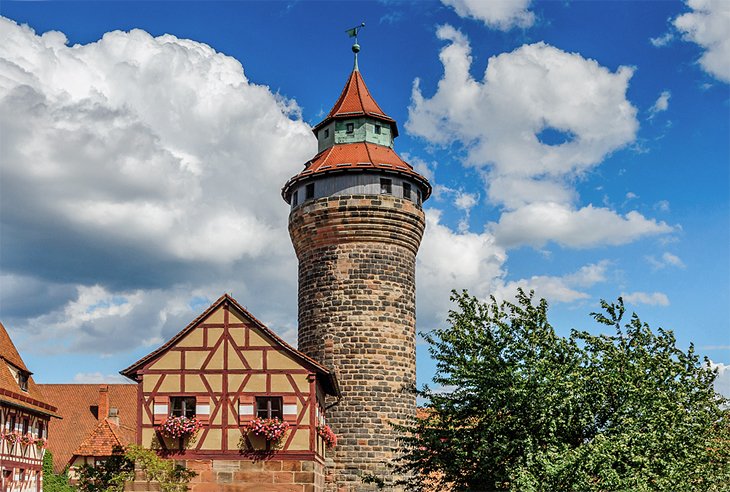
Although badly damaged in World War II, Nürnberg's historic Altstadt has been painstakingly restored to its prewar condition. Enclosed by more than four kilometers of walls that date from the 12 th to the 16 th century, the Old Town is dominated by Nuremberg Castle , a 351-meter-tall fortification that's among the most important surviving medieval fortresses in Europe.
Home of German kings and emperors for more than 500 years, Nürnberger Burg contains several historic structures to visit: the 15 th -century imperial stables, the Pentagonal Tower dating from 1040, the 11 th -century Kaiserburg, a 13 th -century chapel, the Well House, and the Sinwell Tower with panoramic views over the steep gabled rooftops of the Old Town. The Imperial Castle Museum displays medieval weapons and armor.
Just beneath the castle is the half-timbered Albrecht Dürer House , a museum dedicated to the artist and his work. Other highlights of the Old Town are the Hauptmarkt , site of Nuremberg's famous Christmas Market (Nürnberg Christkindlesmarkt) and the 14th-century Gothic church of St. Lawrence (St. Lorenz, or Lorenzkirche), with its nine-meter rose window.
Those with an interest in World War II history can join the four-hour Nuremberg Old Town and Nazi Party Rally Grounds Walking Tour , with an experienced local guide, for an in-depth view of the city's long history. You will tour sites from the days of the Holy Roman Empire, the Renaissance, and the Third Reich, with a visit to Nazi Party Rally Grounds.
Address: Auf der Burg 13, Nürnberg
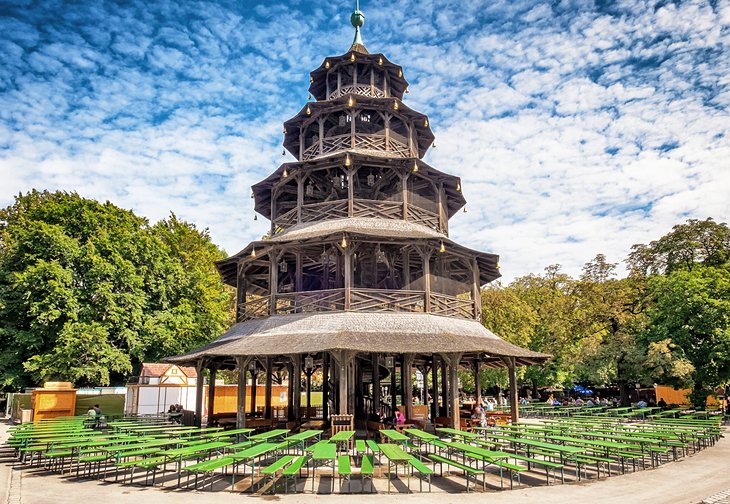
One of the most popular places to go in Munich, for both locals and tourists, the English Garden attracts walkers, joggers, and cyclists with 78 kilometers of pathways and bridle paths, and sunbathers with acres of lawn and riverbanks. A good place to visit for families, the gardens have playgrounds and plenty of places to run.
The Chinesischen Turm (Chinese Tower), a 25-meter-tall pagoda, has a café and is always a hub of activity - especially in December when it hosts one of the city's several Christmas markets.
The park's newest feature is the Japanese Garden , on an island of its own, complete with an authentic teahouse presented to the city in honor of the 1772 Olympics. The park also contains the Bavarian National Museum , with medieval German sculptures and tapestries, and the Bavarian State Archaeological Collection of local prehistoric artifacts.
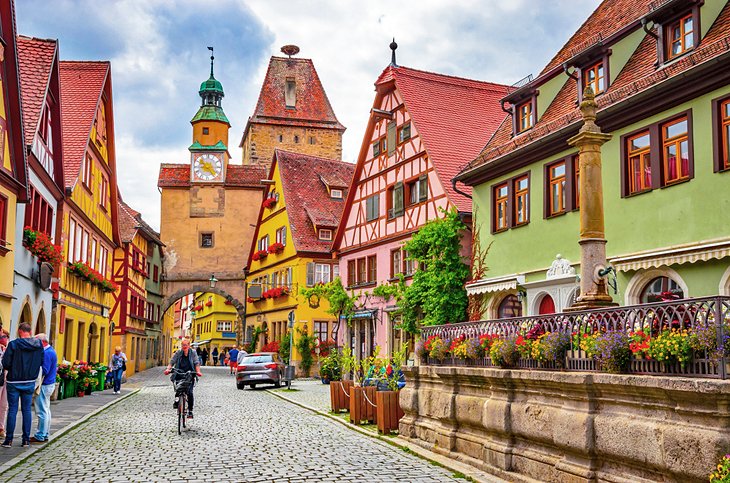
The three medieval walled towns of Rothenburg-ob-der-Tauber, Dinkelsbühl, and Nördlingen are highlights of the Romantic Road , a driving route that scenically through the rolling countryside of Bavaria and northern Baden-Württemberg. Rothenburg is one of the best-preserved medieval towns anywhere in Europe, its postcard-perfect streets lined by half-timbered houses, and its shops and cafes marked by intricately crafted wrought-iron signs.
Walls enclose the Old Town and seem to hold it from tumbling down into the Tauber River below. It's December all year-round at the town's most famous shop, Käthe Wohlfahrt's Christmas Village, just off the Market Square.
Dinkelsbühl owes its prosperity to the wool trade of the 15th and 16th centuries, when the row of gabled houses on the Weinmarkt was constructed. Look especially for the ornate wooden trim on the Deutsches Haus and for the 16th-century patrician Hezelhof.
Each July, Dinkelsbühl celebrates Kinderzeche, one of Germany's most colorful traditional festivals. The 10.5-hour Romantic Road, Rothenburg, and Harburg Day Tour from Munich follows this picturesque route, stopping at Harburg Castle before arriving in Rothenburg.
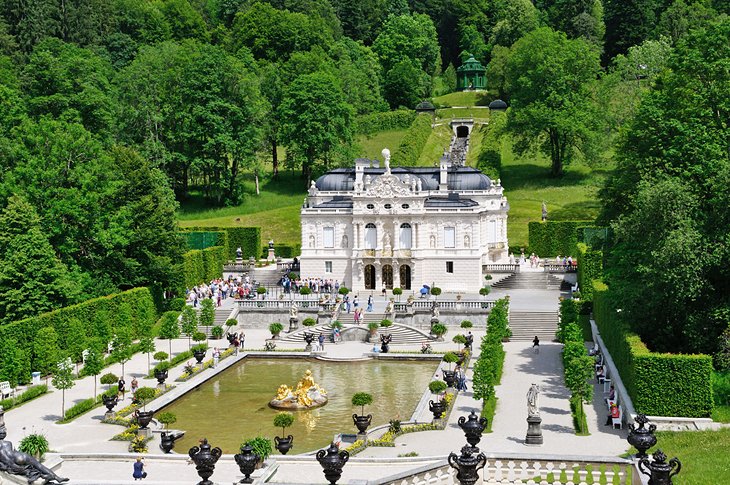
Linderhof Palace was King Ludwig II's favorite, and it's easy to see why. Although it glitters with lavish ornamentation, its size and its setting amid cool green forests give it an intimate and livable quality. On a tour, you'll see the Hall of Mirrors , the Audience Chamber that Ludwig used as a study, the two tapestry Chambers, the King's Bedchamber, and the Dining Room. On the required guided tour, you'll hear stories about this eccentric king.
A tour is also required for the Venus Grotto , Ludwig's fantastic man-made cavern, but you can explore the lovely gardens and grounds on your own, where you'll find both landscape and formal gardens, fountains and pools, and the Moorish Pavilion .
Address: Linderhof 12, Ettal
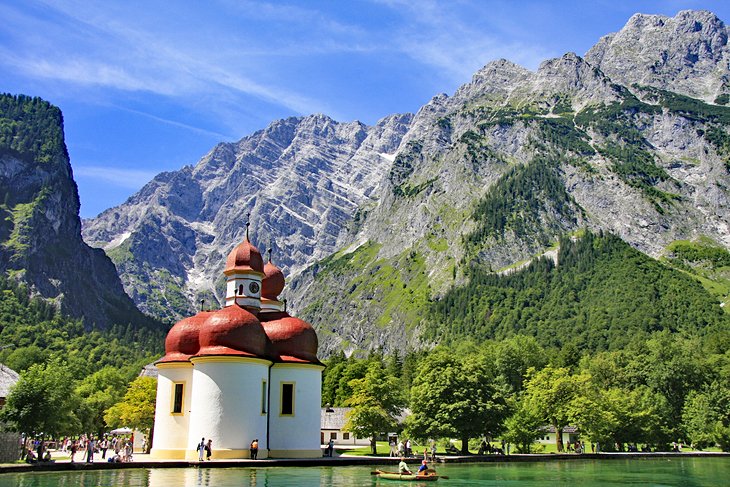
One of the most beautiful spots in Bavaria is the emerald green Königssee, a lake surrounded by steep wooded mountainsides and the rocky cliffs of the Watzmann range. On its shore, the distinctive red domes of the little pilgrimage church of St. Bartholomew reflect in its clear waters. The church dates to 1697, and inside is beautiful stucco work. You can reach it by boat from Schönau, and a footpath leads along the east shore of the lake for superb views of the church and lake from the Malerwinkel .
Nearby Berchtesgaden is one of the most popular resort towns in the Bavarian Alps, surrounded by mountains — the Hoher Göll, Watzmann, Hochkalter, and Untersberg. You can't drive the 6.5-kilometer-long Kehlsteinstrasse, the steep road to the infamous symbol of power of the Nazi regime known as the Eagle's Nest .
Instead, you can ride the gleaming brass elevator through the mountain; like the mountaintop Kehlsteinhaus itself, it was built to impress. In fact, Hitler was rarely there, and today it has only a few original features, but it's still a grim reminder of the horrors of that era of unbridled power. Inside is a restaurant with panoramic views of the Alps.
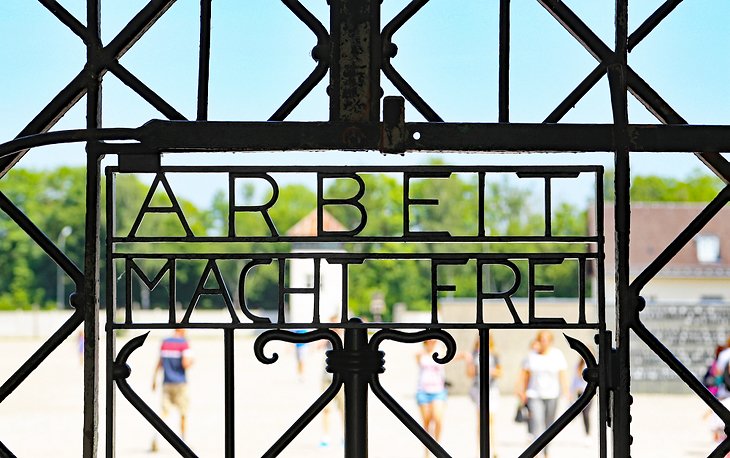
Before World War II and the Nazi era, the little town of Dachau was known for its castle and as a plein air artists' colony. Today, the attractive town's name is almost synonymous with the Holocaust, as the site of the notorious Dachau concentration camp , where 41,000 people died during the Nazi regime.
The KZ-Gedenkstätte Dachau is now a somber memorial to those victims and to countless others like them. Barracks and cells have been reconstructed, and the stories of its prisoners are told through photographs, personal accounts, artifacts, and documents. Guided tours in English are offered daily, or you can visit with a knowledgeable guide to interpret the site, on a Dachau Concentration Camp Memorial Site Tour from Munich by Train .
Address: Pater-Roth-Str. 2a, Dachau
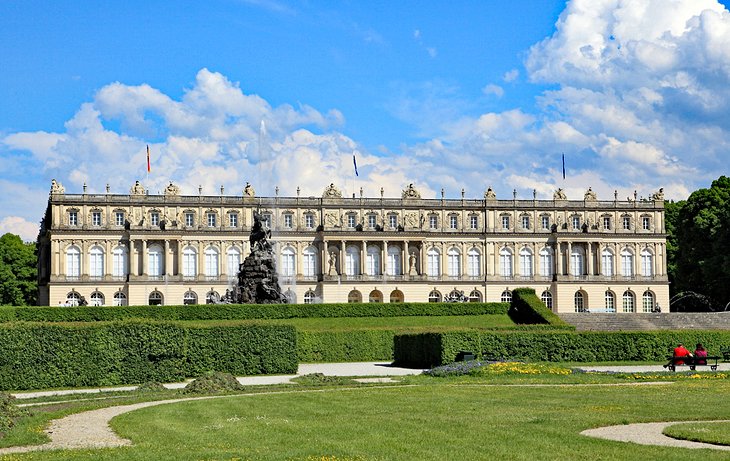
King Ludwig II of Bavaria chose an island in Chiemsee, Bavaria's largest lake, as the site of his third and largest palace, Herrenchiemsee . He envisioned it as a rival to Versailles in its grandeur and splendor, even to the Hall of Mirrors , but it was only partially completed when he was drowned near Neuschwanstein, at the age of 40.
Much of the palace had been completed as he envisioned it, including the Hall of Mirrors; State Staircase; State Bedroom; and Ludwig's Small Apartment, decorated sumptuously in the Rococo style. The King Ludwig II Museum displays artifacts and furnishings connected to his life, and the surrounding gardens, also patterned after Versailles, are decorated with fountains and statues. You can reach the island by boat from Prien or Stock. Guided tours of the palace, the only way you can see it, are available in English.
On the smaller Frauenchiemsee island is a monastery founded in the 8 th century and extended in the 12 th and 13 th centuries. Parts of the original remain, and the present church dates at least from the 11 th century. That island is the scene of a charming Christmas market each December, featuring fine handmade gifts and decorations.
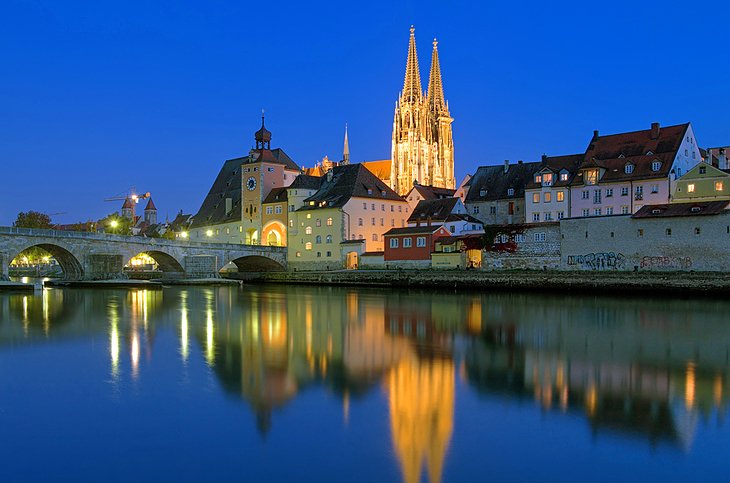
The old imperial city of Regensburg lies at the most northerly point of the Danube, joined here by the River Regen and navigable all the way to the Black Sea. The town's medieval Old Town, made up of churches and aristocratic homes from the 13th and 14th centuries, is a UNESCO World Heritage Site . Crossing the Danube, the 310-meter-long Stone Bridge , was built in the 12th century and is a masterpiece of medieval engineering,
The 13th-century Cathedral of St. Peter in Domplatz, the city's central square, is considered to be the finest Gothic church in Bavaria, with a magnificent west front and delicate twin spires marking the city's skyline at 105 meters high. Highlights of the interior are the superb 14th-century stained glass and the figures of the Annunciation from 1280.
Romanesque All Saints Chapel , off the beautiful 14th-century cloister, features wall paintings, and St. Stephen's Chapel predates the cathedral, dating back to AD 800. The cathedral is known for its boys' choir, the Domspatzen, one of Europe's finest.
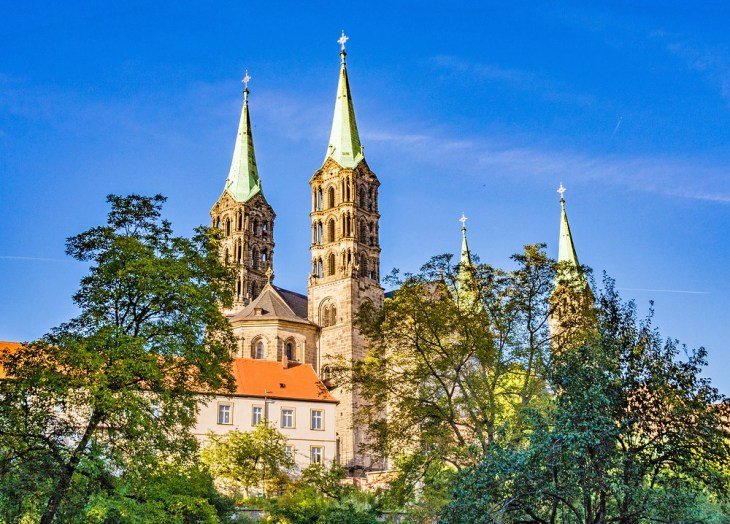
Bamberg Cathedral — affectionately referred to by locals as Domberg — lies high atop a hill overlooking one of Bavaria's most picturesque small cities. This four-towered masterpiece of early 13th-century ecclesiastical architecture includes the Fürstentor (Prince's Doorway), with its figures of apostles and prophets, and a relief of the Last Judgment.
Be sure to see the Adamspforte (Adam's Doorway) along with the Marienpforte (Virgin's Doorway). Inside is the tomb of Henry II, who died in 1024, along with that of his wife Kunigunde.
The cathedral's best-known feature is the famous Bamberger Reiter , or the Bamberg Horseman, erected in 1240. The identity of the figure pictured is something of a mystery. Various theories include Emperor Henry II; King Stephen of Hungary (Henry II's brother-in-law); and Holy Roman Emperor Frederick II, a major patron in rebuilding the cathedral. The Diocesan Museum displays the cathedral treasury with vestments and Henry II's imperial robes.
Other places to visit in Bamberg's Old Town are the Altes Rathaus (Old City Hall), which now houses a porcelain museum, and the Altenburg , a 12th-century castle crowning the tallest of the city's seven hills.
Address: Domplatz 5, Bamberg
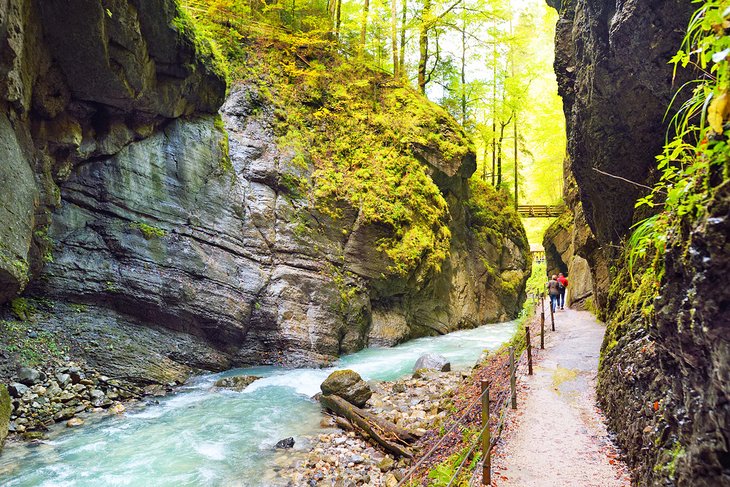
One of Bavaria's most dramatic natural wonders, the Partnach Gorge is a narrow crevasse cut into the solid rock by the Partnach River in Garmisch-Partenkirchen. Its formation began millions of years ago, and over the millennia meltwater and the debris from the Schneeferner Glacier on the Zugspitz plateau, carried by the rushing river, scoured the gorge to its current depth of 263 feet (80 meters).
Two trails, one of them right along the river's edge, take you beneath the vertical rock walls, past waterfalls, cascades, rushing rapids, and pools. The lower trail is the easiest; the upper one goes through tunnels less than six feet in height as it traverses the 699-meter (2,293-foot) gorge.
Those with a head for heights can climb the steep steps to view the gorge from the iron suspension bridge, which spans the forested summit 70 meters (225 feet) above the river. You can also take a torchlight tour of the gorge at night.
The gorge is open year-round, and is spectacular in the winter, when the walls become giant curtains of icicles. The Partnach Gorge is also the gateway to several hiking trails. To get to the gorge, follow the signs from the Olympic Stadium in Garmisch-Partenkirchen; it is a 25-minute walk.
Read More: Best Hikes in Europe
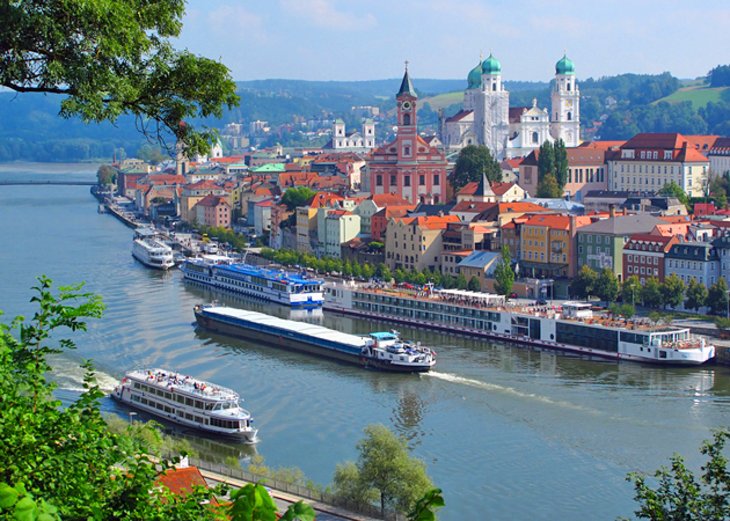
Passau lies on the Austrian frontier at the junction of the Danube and the River Inn and is famous for its flat-roofed, 17th-century, Italian-style houses linked by flying buttresses. Other highlights of the Old Town , widely regarded as one of the most picture-perfect townscapes in Europe, include the Oberhaus fortress , the Mariahilf church , and the charming stepped lanes leading down to the two rivers.
In the Domplatz, surrounded by old canons' houses, stands the Cathedral of St. Stephen , known for its massive organ, the largest church organ in Europe and the second largest in the world. The cathedral's Late Gothic east end dates from 1407 and the superb Baroque nave was added in 1678. Also of interest is Residenzplatz, with its old homes, and the New Bishop's Palace (Neue Residenz) built in 1772, home to the Cathedral Treasury and the Diocesan Museum .
The most fascinating museum, especially for visitors who admire fine glasswork or Jugendstil (Art Nouveau) design, is the Glasmuseum Passau , which displays the world's largest collection of Bohemian glass. The collection, which represents work from 1650 to 1950, features more than 1,000 Loetz pieces, including those shown at the 1900 Paris Exposition.
Passau is the starting point for Danube River cruises , both short day excursions and longer trips to Vienna , Budapest , and the Black Sea.
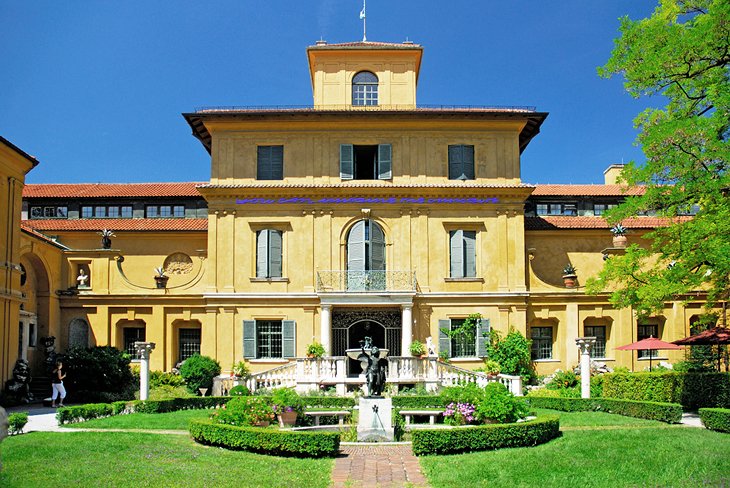
The art district around the Neoclassical Königsplatz features one of the finest groups of art museums anywhere in Europe . The three Pinakothek art galleries cover Europe's major art movements and styles. In the Old Picture Gallery (Alte Pinakothek) are the Dutch and Flemish masters and outstanding Italian, German, French, Spanish, and medieval paintings.
The New Picture Gallery (Neue Pinakothek), picks up with works ranging from the Rococo to Art Nouveau periods (note that this building is currently undergoing a major renovation, and highlights of its collections are temporarily exhibited in galleries on the ground floor of the Alte Pinakothek).
The State Gallery of Modern Art (Pinakothek der Moderne) houses an exceptional collection of more than 20,000 works after 1900 covering the Bauhaus, Cubism, Futurism, the Fauves, and other important avant-garde movements, with works by Picasso, Warhol, Magritte, and Dalí. The Glyptothek and the State Antiquities Collection (Staatliche Antikensammlung) reach further back into ancient sculptures and classical art.
The sixth and newest of this remarkable ensemble of art museums is Lenbachhaus , the Italianate villa of artist Franz von Lenbach, which, with its new extension, houses the world's finest collection of works by the Blauer Reiter (Blue Rider), a group of European Expressionist painters led by Wassily Kandinsky and Franz Marc.
Address: Königsplatz, München
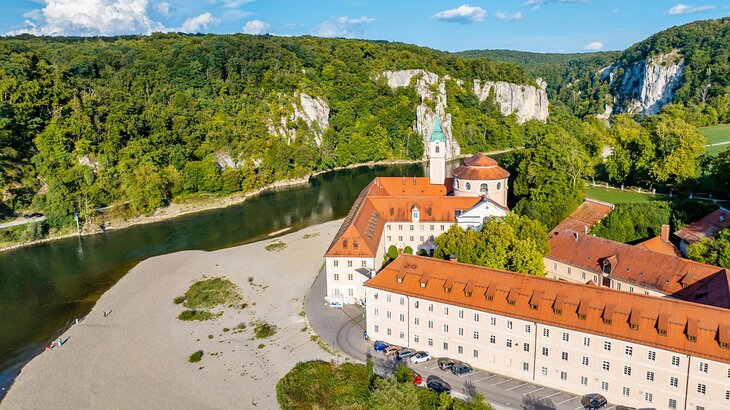
Carved about 200,000 years ago when a branch of the Danube wore through the limestone and changed the course of the river, the Danube Gorge is a five-kilometer ravine with rock walls as high as 70 meters.
One of the most beautiful spots along the Danube, the gorge is best experienced on a cruise. You can board a boat (be sure you get one with a return sailing) from the dock at Weltenburg Abbey. This formidable monastery sits beside a deep bend in the Danube and is believed to be the oldest in Europe, dating back to 620.
Be sure to see the Baroque abbey church, built and decorated by brothers Cosmas and Egid Asam, who were to later build the famous Rococo Asamkirche in Munich. Its architecture and decorative stucco work and frescoes make it one of the most important works of Baroque art in Europe.
You can take a 30-minute tour of the abbey and church, and be sure to stop for a slice of the Abbey's Asam layer cake at the open-air café. For spectacular views of the Abbey and Danube Gorge, you can hike along the top of the gorge.
More Related Articles on PlanetWare.com
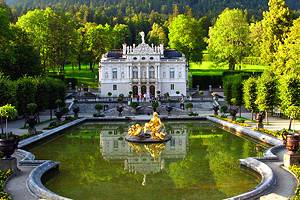
Discovering More of Bavaria: After seeing the highlights of Bavaria, you may want to see more of the top tourist attractions in Munich and explore its best museums and art galleries . You'll find more nearby places to visit with the help of our pages on the top day trips from Munich and the top attractions of Nuremberg (Nürnberg).
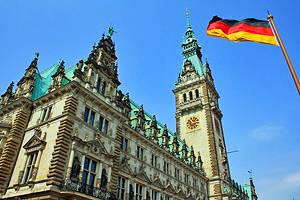
Exploring Germany: For a good overview of the country's best experiences, see our page on the top-rated tourist attractions in Germany . To discover more of the north, you might travel to the exciting capital city of Berlin and explore the historic port of Hamburg .

More on Germany

Shop my Scandinavia guide with 200+ tips and map

- City Guide , Featured , Germany , Travel
Visiting the Bavarian Alps: Top Things to Do in Garmisch Partenkirchen
- September 12, 2020

When you think about The Alps region, what countries do you think of. Often Switzerland comes to mind first… Then probably Austria and France, maybe even Italy. But often the German Alps are an overthought. This was my second time visiting the German Alps – also commonly known as the Bavarian Alps, because of it’s location in the Bavaria state of Germany. The first time I visited was earlier in my travelling days where just about everything seemed magical. And while I am still often very guilty of romanticizing travel experiences and enjoying every small detail, I was a bit worried that my return to Germany just wouldn’t be quite as special as it was the first time. Luckily, I was wrong.
As a more seasoned traveller, my summer trip to Germany focused on travelling a bit deeper in the country. I knew I wanted to return to the Alps. The last time I was in Germany, I visited to two locations that are typically at the top of every tourist itinerary: Berchtesgaden and the Füssen area (which is home to Neuschwanstein Castle). This time, my mountain adventures took me to the area of Garmisch Partenkirchen. A popular winter skiing destination in Germany, this area is home to Germany’s highest peak, Zugspitze, as well as many beautiful lakes, trails, and scaling mountains. So there is plenty of things to do in Garmisch Partenkirchen in the summer.
While this guide will focus mainly on things to do in Garmisch Partenkirchen (also known as GaPa … which is much easier to pronounce), I’ll also share some tips about things you must do in some of my other favourite Bavarian Alps regions.

Looking to extend your trip? Here's some Other towns in the Bavarian Alps to consider.
There are so many towns in the Bavarian Alps, it can be overwhelming to know which ones to visit. While I still have many spots in The German Alps to visit, here’s a couple of my other tops pics for first time visitors!
Füssen to see Neuschwanstein Castle
No trip to the German Alps is complete without visiting Neuschwanstein Castle. The famed castle is said to have been a huge inspiration for Walt Disney, and the parallels between this popular tourist spot and Cinderella’s Castle are uncanny. It is truly magical, and is only an hour away by car from GaPa, which makes it easy to visit both.
A few quick Neuschwanstein Castle tips:
- Arrive early, ideally as early as sunrise (or alternatively at sunset). This spot gets VERY busy with day trip visitors from Munich and is best experienced during these quiet hours,
- Make sure you take a tour! The stories of King Ludwig II were so interesting, and the interior is so special.
- Stay overnight in Füssen or Schwangau and enjoy the region. This area has so many more gems than just Neuschwanstein Castle to explore. Hohenschwangau Castle is another castle nearby, and although I didn’t do a tour, it was fun to explore the grounds. Schwansee and Alpsee are also really gorgeous lakes. And if you’re looking for a bit of a thrill in the mountains, the summertime luge tracks in Schwangau are really fun!

Things to Do in Malmö Sweden: A Local’s Perspective

Where to Eat in Malmö Sweden 2023: A Local Foodie’s Guide

Experience the arctic: Swedish Lapland adventures on a budget

The Vesterålen islands: Things to do in Northern Norway
Stay up to date, follow my daily life on instagram.

Discover More

Let's Connect
© 2022 Madeline Rae Away, All Rights Reserved. Photography and written content may not be reproduced without permission.

- The 10 Most Beautiful Towns...
The 12 Most Beautiful Towns in Bavaria, Germany

No doubt about it, Bavaria’s one heck of a beauty, filled with all the photogenic attractions that evoke Germany in an instant: time-warp castles with pencil towers; lakes of transparent Alpine clarity; extravagant buildings in ornate and swirly Baroque style; enormous tankards of foaming ale at the Oktoberfest – Munich’s festival of beer – and those half-timbered homes straight out of Hansel and Gretel.
Did you know you can now travel with Culture Trip? Book now and join one of our premium small-group tours to discover the world like never before.
Bavaria is a traveler’s paradise, drawing millions of visitors annually to towns rich in regional heritage and cultural traditions. Are you in a Bavaria state of mind already? Here are the most beautiful towns you should visit on your Bavarian travels. Have a great trip – or gute Reise , as they say in Germany.
Historical Landmark

Garmisch-Partenkirchen
Architectural Landmark

If you fancy a proper taste of the great Bavarian outdoors, make for Garmisch-Partenkirchen, a town, as its hyphenated name suggests, created from the merging of two villages for the 1936 Winter Olympics. Both places are set against a dramatic backdrop of Alpine peaks and each retains its own character, old-world and modern respectively. Here you’ll find some of the best hikes and skiing, right next door to Munich . The area works well as part of an itinerary taking in some of the grandest palaces belonging to the enigmatic ‘Mad King’ Ludwig II of Bavaria (born 1845, found drowned in Lake Starnberg, 1886). Among the finest examples are the nearby Schloss Linderhof, Jagdschloss Schachen and, for full-on Disney-esque Magic Kingdom fantasy, the magical Neuschwanstein castle .

One of the finest vacation destinations in southern Germany, Füssen has a history spanning 700 years, and has been on the map of must-visit Bavarian places for centuries. It’s at the southern end of the tourist-loved Romantic Road , which runs for 400km down from Würzburg, through picture-book scenes of beauty: lakes, vineyards and time-honoured half-timbered homes with window-boxes erupting in displays of floral pink. Until the demise of the industry in the 19th Century, Füssen was famed for its lute and violin-making – take a look at some of the finest historic specimens in the town museum. Check also what’s on at The Kaisersaal: concerts are part of the Füssen’s permanent cultural repertoire. What else? The romantic old town is famously lovely-looking, framed by dramatic mountain peaks and freshwater lakes, and perfect for visits to Neuschwanstein Castle.

Become a Culture Tripper!
Sign up to our newsletter to save up to $1,058 on our unique trips..
See privacy policy .

This vibrant medieval town (and Unesco World Heritage Site ) on the banks of the Danube is home to an impressive assortment of historic structures spanning two millennia – it was founded in AD179, during the rule of the Roman Emperor Marcus Aurelius, the Danube becoming essentially the Roman Empire’s northern border. The legion camp Castra Regina, aka the “fortress by the river Regen”, where it joins the Danube, was Regensburg’s very first footprint. In AD590 it became the first capital of Bavaria, playing host to numerous dukes, kings and bishops down through the centuries. Thankfully, Regensburg was spared the tragic devastation visited upon other cities during the wars, so today, it retains many architectural head-turners that illustrate how it must have looked during its zenith. Don’t miss the Roman City Gate, or Porta Praetoria, and the 12th-Century Old Stone Bridge, with its 16 arches marching over the Danube: a triumph of Medieval engineering.
Natural Feature, Architectural Landmark

Author Hermann Hesse once wrote of this town: “If I could choose my place of birth, I would consider Würzburg “, and the moment you clap eyes on it, it’s easy to understand why. It is an upbeat university town of outstanding beauty, rippling with Baroque facades in its elevated position on a hill amid landscapes of vineyards. The history dates back to 686, when it was a Franconian duchy and a pilgrimage point. Similarly today, the scenic town has much to offer to visitors. One of the high points is the Würzburg Residence, commissioned in 1720 by the Prince-Bishop Johann Philipp Franz von Schönborn, who summoned architects from across Europe to build his palace. There are frescoes by the great Italian artist Tiepolo, no less. Würzburg remains one of the most prominent blossomings of Baroque architecture in Germany. Coincidentally, it is also right in the heart of the country’s wine-producing region , making it a superb place to sample local fruits of the vine – the local wine culture dates back to Roman times. Look out for Silvaner and Bacchus grape varieties, and toast your good fortune for finding this town.
Rothenburg ob der Tauber

You couldn’t get a much-more-perfect day trip from nearby Nuremberg than Bamberg , a fascinating town with an Altstadt (old town) that, sure enough, has been anointed by Unesco as a World Heritage Site . It spreads over seven hills where numerous rivers and winding canals converge, a setting that explains why it is repeatedly voted among the most beautiful settlements in Germany. Bamberg’s narrow medieval streets are catnip for day-trippers, who idle away their time in its many pavement cafés, sampling local beer from its myriad city breweries. But there’s plenty of eye candy if you’re here to gain a historical perspective: the four-spired cathedral, the Baroque Residenz (residences) and the old Rathaus (town hall) will fill your Instagram feed faster than you can say “ wunderbar “.

Where three rivers – the Danube, the Inn and the Ilz – meet, you’ll discover Passau. The Venice of Germany, as it’s sometimes called, is a picturesque town that has been shaped by water down through the centuries. It has always been a wealthy hub of commerce, known for trading Bohemian salt (Central Europe’s white gold), as well as its close ties to the Holy Roman Empire – a church has stood here since the fifth century. The quaint town was deemed incredibly prestigious long ago for being the largest bishopric in the land, exquisitely built by powerful princes and bishops to form the winding lanes, tunnels and grand archways, many of which still stand today. A perfect spot to visit for a day on a river cruise, Passau also appeals to avid cyclists for its abundance of long-distance routes.
Oberammergau
More of a village than a town, this small alpine community is, from a distance, just another charming rural Bavarian town. However, Oberammergau is known across the country for its esteemed history in woodcarving, its beautiful fresco-painted houses and its NATO training centre. This place really punches above its weight once every 10 years, though, when the local population puts on their decennial ‘ passion plays ‘, enacting the death of Christ. Around 5,000 people live in Oberammergau, but passion play season has seen as many as half a million visitors flock to the village in the past. The tradition has been running since the 17th century, the plays now having a season once every 10 years, with local men growing their beards in preparation a year in advance, and most of the village coming together to put on the shows. You’ll have to wait until 2030 for the next production , but Oberammergau is worth a visit any time. Other shows run all year round, the village itself is a delight, and its well-placed position on the German Alpine Road makes it a convenient stop when visiting the nearby Linderhof Castle and Ettal Abbey . Recommended by Gethin Morgan.
Berchtesgaden
There are predominantly three things bringing visitors to this spectacularly scenic resort town in the most southeasterly nook of Germany. The first is easy access to some of the country’s best ski slopes, not to mention nearby Austria’s. The second is that it’s the final stop on the aforementioned German Alpine Road , one of Europe’s prettiest driving routes. The third is Berchtesgaden’s historical significance. Perhaps as a result of reasons one and two, this unassuming town became a hub for holiday homes and mountain retreats among the very upper echelons of the Nazi party, with the likes of Goebbels, Himmler and Hitler himself all owning properties here. This naturally meant that Berchtesgaden became a key seat of political power, a place where meetings were held and decisions were made. It is also watched over by the infamous Eagle’s Nest compound, set atop Kehlstein mountain. The darkness of this town’s modern history contrasts so strangely with its peaceful nature and scenic surrounds – this is without doubt one of the most beautiful towns in Germany, but it’s also one of the most historically fascinating. Recommended by Gethin Morgan.
Dinkelsbühl

The historical town of Dinkelsbühl is located in Central Franconia on the northern stretch of the Romantic Road. According to many historians, it is the best-preserved medieval town in Germany, having remained totally unscathed during the World Wars, except for a broken window in the gothic cathedral of St. George. The unspoiled townscape harks back over 800 years and is filled to the brim with striking churches, proud townhouses and timbered cottages among its many winding lanes.
Shaped by hundreds of years of history, Mindelheim is a journey of discovery in the heart of the Unterallgäu district. Located 56 miles (90 kilometers) west of Munich , it is the perfect stop on the way to Lindau. The town’s earliest history officially dates from 1365, when it came into the possession of the Dukes of Teck-Owen, but it was soon passed into the hands of the Württemberg counts. Today, Mindelheim reflects the structure of a typical medieval settlement, with its partially standing city wall, its array of churches and the town hall arranged around the market square.

Top 17 Things To Do And See In Hamburg, Germany

The 9 Best Day Trips From Hamburg

Exploring Art And History With Berlin’s 10 Best Cultural Tours

The 7 Best Day Trips From Dusseldorf

The 10 Best Day Trips from Leipzig

The 9 Best Castle Tours to Take in Germany

The 7 Best Day Trips from Frankfurt

Must-Visit Attractions in Dusseldorf

The 10 Best Day Trips from Cologne

The 11 Best Day Trips from Munich, Germany

The 10 Best Day Trips From Dresden

Must-Visit Attractions in Cologne
Culture Trip Fall Sale
Save up to $1,058 on our unique small-group trips! Limited spots.

- Post ID: 433321
- Sponsored? No
- View Payload
- Skip to primary navigation
- Skip to main content
- Skip to primary sidebar
- Skip to footer
TravelAwaits
Our mission is to serve the 50+ traveler who's ready to cross a few items off their bucket list.
The 7 Most Beautiful Cities And Towns In The Alps

Songtam Srinakarin / Shutterstock
- Activities and Interests
- Destinations
- History and Culture
- Outdoor Activities
- Sightseeing
If you’re looking for a pastoral paradise in the heart of Europe, head up to the mountains. The Alps encompass a massive swath of the continent and are dotted with quaint towns and cities that radiate charm and hospitality.
We’ve put together a list of the seven most gorgeous towns and cities in the Alps, spread across five countries. Check them out on your next Alpine adventure!

claupad / Shutterstock
1. Schwangau, Germany
Schwangau is the epitome of the Bavarian fairy-tale village and home to Neuschwanstein Castle , a breathtaking work of art dreamt up by King Ludwig II. Its splendor captured the attention of Walt Disney, who allegedly used it as a model for Cinderella’s and Sleeping Beauty’s castles. Nearby is King Ludwig’s childhood home, Hohenschwangau , an ornate and sprawling property that doesn’t share Neuschwanstein’s fame, but is still very much worth seeing.

emperorcosar / Shutterstock
As for King Ludwig himself, he met a sad fate near the end of his reign. He was pronounced unfit to serve, given the moniker “Mad King Ludwig,” and dethroned. There’s still plenty of controversy as to whether or not King Ludwig was really insane. Whether he was mad or simply misunderstood, it’s undeniable that the Alpine architectural masterpieces he left behind are superb.

SimonePolattini / Shutterstock
2. Glorenza, Italy
Glorenza is a miniature Italian Alpine town known for its medieval architecture and fusion of Italian and Austrian culture. It’s the smallest town in South Tyrol and is remarkably well preserved — a must-see for any history buff.

lorenza62 / Shutterstock
Once you’ve worked up an appetite traversing the pretty streets of tiny Glorenza, try canederli with speck , a hearty regional favorite consisting of Austrian comfort food with an Italian twist. You can wash down your delicious meal with some handcrafted spirits at the local distillery .
It should be noted that Glorenza is sometimes referred to as Glurns or Glorenza/Glurns.

kavalenkava / Shutterstock
3. Spiez, Switzerland
For astounding views of the Swiss Alps and magnificent architecture, head to the lovely town of Spiez .

ArdeaA / Shutterstock
Situated on the shore of azure Lake Thun , Spiez is the textbook example of Swiss Alpine charm, with its flower park, stunning views of the Alps, and famous castle . Spiez is also a great base from which to explore the remainder of the Bernese Alps.

Aishe / Shutterstock
4. Chamonix, France
Chamonix is home to Mont Blanc , one of the most famous peaks in the world, and the town has long been popular with skiing aficionados and winter-sports enthusiasts. Even those who don’t want to strap on a pair of skis will love Chamonix’s unique cable car . The Alpine gondola gives visitors a bird’s-eye view of Mont Blanc and is a bucket-list trip for sure!

Nataliya Nazarova / Shutterstock
Travel to Chamonix during the spring, summer, or fall to experience some fantastic hiking or golfing in the shadow of majestic Mont Blanc.

Kanuman / Shutterstock
5. Salzburg, Austria
When most people think of Austria, they picture the bustling streets of Vienna , but they shouldn’t overlook musical and magical Salzburg . Salzburg was the birthplace of Mozart and the idyllic setting of The Sound of Music . Fans of the musical can revisit many of its iconic scenes on a Sound of Music tour .

canadastock / Shutterstock
Alternatively, you could simply pass a beautiful afternoon strolling through the Old Town, a designated UNESCO World Heritage site . Salzburg is surrounded by the Alps, so you’ll see incredible natural beauty no matter where you look. Put this Austrian pearl on your bucket list if you’re looking for beautiful architecture, culture, history, and nature.

Victor FlowerFly / Shutterstock
6. Gimmelwald, Switzerland
The tiniest town on our list is pastoral Gimmelwald , a car-free slice of Heaven in the Swiss Alps. This village is accessible by cable car and occasionally by train or hiking, but Gimmelwald’s off-the-beaten-path location makes it even more alluring. It hasn’t hit the tourist map yet, so if you’re looking for an authentic taste of the Swiss Alps, Gimmelwald is it. The houses are built in the chalet style, and there are a limited number of places to eat and stay .

CHEN MIN CHUN / Shutterstock
Still, it is worth spending the night in Gimmelwald to enjoy rustic Swiss hospitality and to see the night sky in its full glory, free of light pollution. Although you won’t find too many modern amenities in Gimmelwald, you’ll find a ton of character and a side of the Swiss Alps that most people don’t get to see.

mimpki / Shutterstock
7. Thonon-Les-Bains, France
Thonon-les-Bains is not as sky-high as some of the other towns on this list, but it is a luxurious retreat in the Alpine foothills on the shore of gorgeous Lake Geneva , making it an attractive destination for summer swimming and boating and winter sports.

Year-round, tourists flock to Thonon-les-Bains to pamper and restore themselves with thermal baths and spa treatments.
The Alps are mesmerizing and magical mountains full of towns that you simply must see. Don’t miss out on these jewels the next time you’re traveling through Europe.
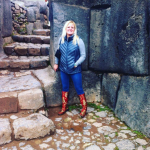
Elizabeth Lavis is a freelance writer who spends the majority of her time traveling the world and seeing exciting and fun new places. She likes physical challenges, such as mountain climbing, and enjoys interacting with interesting people and learning to appreciate new cultures and ways of doing things. Elizabeth is curious about the world around her and is always looking for ways to make it a friendlier and more welcoming place. Read more from Elizabeth on her personal site .
Get exclusive travel insights. Join now.

Get exclusive travel insights. Join now .
The Ultimate German Alpine Road Trip Through the German Alps
I want to transport you to the stunning German Alps, where nature’s beauty knows no bounds.
Imagine yourself surrounded by snow-capped mountains, lush green valleys, and picturesque alpine towns. Now, add to that image the thrill of a road trip on the German Alpine Road, and you’ve got an unforgettable adventure!
The German Alps are a true wonder of nature, and the Deutsche Alpenstrasse route is the perfect way to experience them.
I will share my Bavarian Alps road trip with you in hopes of inspiring you to plan your own. Allow this article to be your ultimate guide, serving as a detailed German Alpine Road map, navigating you from the starting point to the end, while uncovering exciting activities to make every moment in the middle of your trip truly memorable.
Table of Contents
This post may contain affiliate links. If you click on an affiliate link, at no additional cost to you, I will earn a small commission if you decide to book. Please check out my privacy policy and disclosure for more information.
What is the German Alpine Road?

This iconic route spans 450 kilometres and winds through some of the most breathtaking scenery in Germany. From the Bavarian foothills to the soaring peaks of the Alps, the road offers a diverse array of landscapes that will leave you awe-inspired at every turn.
So, what can you expect on your road trip along the Alpine Route in Germany?
For starters, you’ll be treated to some of the most stunning views of the German Alps you can imagine. You’ll also have the opportunity to explore charming Bavarian villages, historic castles, and sparkling lakes. And, of course, you’ll be free to stop and explore whenever the mood strikes you.
Where is the German Alpine Road route?
The Deutsche Alpenstrasse or German Alpine Road is located in the southern part of Germany. Spanning 450 km from Lindau on Lake Constance in the west to Berchtesgaden on Lake Königssee in the east.
The road winds its way through and over high mountain passes. This alpine Strasse is close to some of the region’s most famous attractions, including the Neuschwanstein Castle, the Königssee Lake, and the Zugspitze which is Germany’s highest mountain peak.
Starting Point: Alpine Road in German Alps in Berchtesgaden
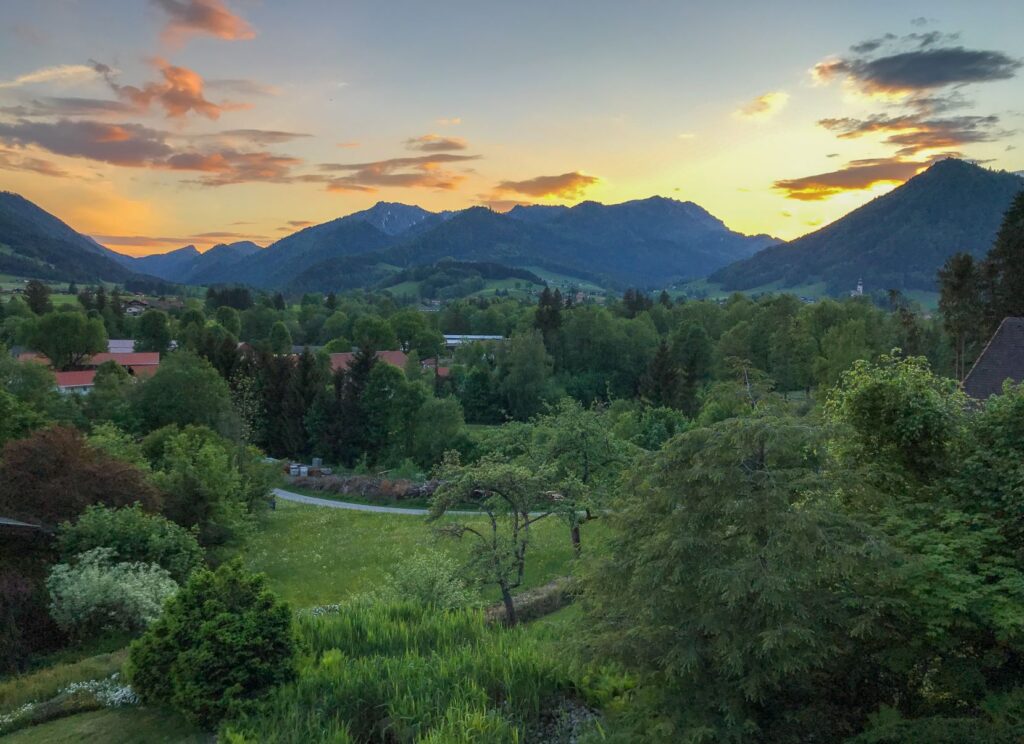
Starting your journey along the Alpine Road in Berchtesgaden is a great way to experience the beauty of southern Germany.
The quaint town of Berchtesgaden is just a short drive from Munich, making it an easily accessible starting point for your adventure. Driving from Munich to the Alps near Berchtesgaden is about 154 km or 2 hours, or by train a little less than 2 hours.
As you leave Munich behind and head south towards Berchtesgaden, the scenery changes dramatically. The hustle and bustle of the city give way to the tranquil beauty of the Bavarian countryside.
The landscape becomes increasingly mountainous, and the air feels fresher and cooler.
I choose to stay in Ruhpolding, Germany. Ruhpolding is a tiny village close to Berchtesgaden National Park, Lake Chiemsee, and Salzburg, Austria.
The name of this tiny town might sound familiar to sports enthusiasts. It hosted the World Biathlon Championships not once, but four times.
Nestled in the German Alps, Ruhpolding couldn’t be any more beautiful.
This is where I stayed
A 1-bedroom traditional alpine chalet with a private balcony and mountain view. The hosts couldn’t be any more welcoming, leaving me fresh eggs in the morning and chocolates at night. The view from my balcony is above.
Now, for what you can see and do in the nearby area.
1. Berchtesgaden National Park – a natural heaven

A visit to Berchtesgaden National Park is a must!
Covering an area of 210 sq/km, the park is home to some of the most breathtaking natural landscapes in the region!
The park is a popular destination for hiking, with numerous trails winding through the stunning scenery. However, the park is accessible to everyone.

The highlight of the park is undoubtedly Königssee, an emerald-green lake lined with dramatic alpine surroundings.
You can only access it from an electric ferry.
This quiet boat glides across the lake making 2 stops for you to explore. The first is St Bartholomew’s Church, and the second one is Salent.
2. Berchtesgaden – a charming alpine town

Berchtesgaden is a charming town nestled in the shadow of the majestic Watzmann mountain range.
It exudes old-world charm and is a popular destination for tourists. Berchtesgaden is known for its beautiful natural surroundings, with hiking trails that wind through the mountains and forests.
The town also has a rich history and is home to numerous historic landmarks, including the Old Salt Works and the Royal Palace.
Come here and indulge in the local cuisine, which includes hearty Bavarian dishes like schnitzel and sausages and people-watch in the public square. I ate at Gasthof Neuhaus serving traditional dishes right near the market square.
3. Bad Reichenhall – a beautiful spa town

Bad Reichenhall is a charming spa town surrounded by majestic mountains.
This picturesque town is known for its salt production, healthy spa treatments and beautiful gardens.
Stroll the main street and admire the town’s historic buildings and tiny shops.
With its serene atmosphere and stunning surroundings, Bad Reichenhall is the perfect place to unwind and recharge while on your Alpine Road journey.
4. Inzell – an outdoor lover’s paradise

Inzell is a charming town known for its outdoor activities.
In the winter, downhill skiing and ice rinks in the surrounding mountains. In the summer months, hiking, cycling, and swimming in the crystal-clear lakes are popular.
Inzell is also home to numerous cultural landmarks, including the beautiful St. Michael’s Church and the old town square.
5. Salzburg – a romantic Austrian city
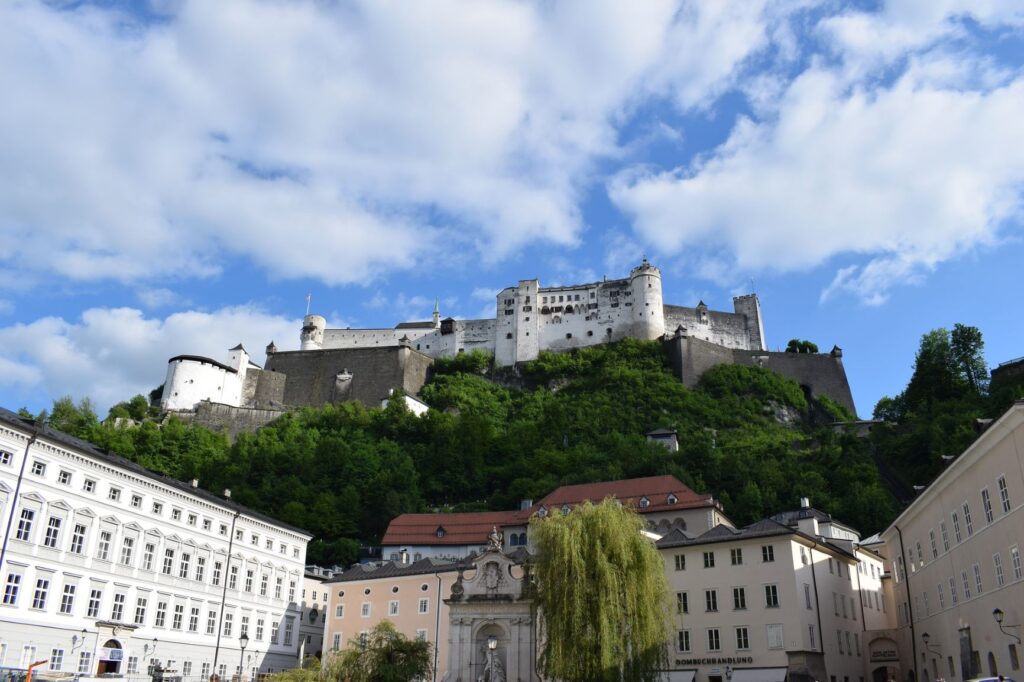
No trip to the Alpine Road is complete without a visit to Salzburg, Austria’s charming city of music and culture.
Just a 40-minute drive from Berchtesgaden, Salzburg offers a stunning blend of historic architecture, cultural landmarks, and natural beauty.
The city is home to numerous attractions, including the Hohensalzburg Fortress, the Salzburg Cathedral, and the Mirabell Palace and Gardens.
Spending one day in Salzburg is not to be missed along the German Alpine Road.
Mid-Way Point: Alpine Road in the German Alps in Garmisch
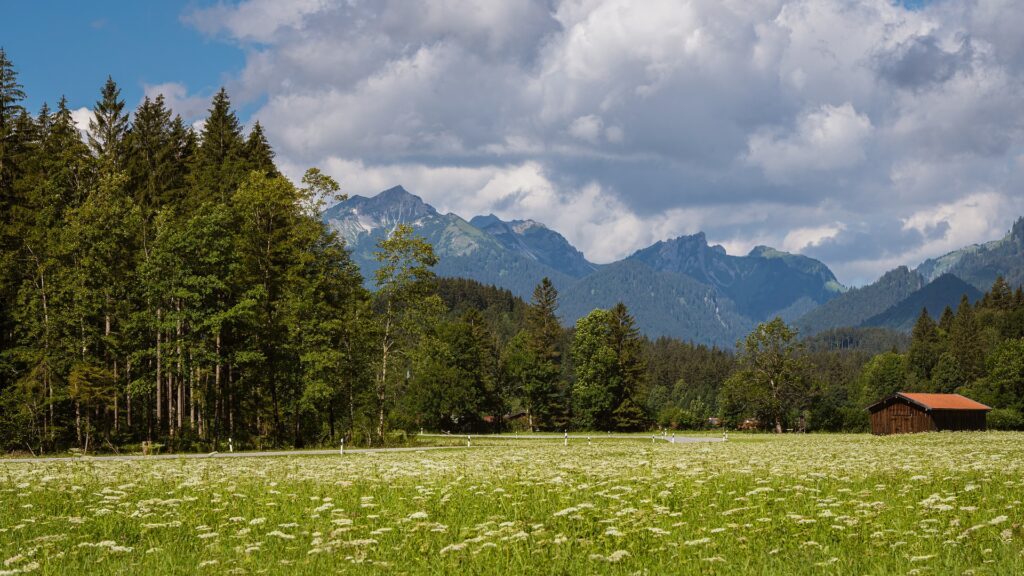
Leaving Berchtesgaden and heading west towards Garmisch is a highlight of the Alpine Road Germany journey.
As you travel through the winding roads, you’ll be surrounded by some of the most stunning natural landscapes in Germany.
This is the point of the Alpenstrasse that takes you through three spectacular mountain passes with panoramic views – the Griessneralm, the Wochenbrunneralm, and the Kitzbühlerhorn.
The route takes you through the picturesque towns of Reit im Winkl and Bad Tölz. Each offers its unique charm and worthy stops for a quick tour of the town.
As you approach Garmisch, the scenery becomes increasingly dramatic, with towering peaks and glaciers in the distance.
Garmisch serves as the mid-way point of the Alpine Road, so let’s explore.
1. Garmisch Partenkirchen – two towns into one

Historically, Garmisch-Partenkirchen were two separate towns but have now blended as one. Although you can see subtle differences as you move through the town.
Garmisch Partenkirchen is large and offers a lot of amenities like accommodations, restaurants and shopping. But it’s the Old Town where you’ll want to go.
Explore the quaint cobblestone streets and admire the traditional Bavarian architecture, including the beautifully painted facades of the houses.
Pop into the little shops where you can see the local handicrafts. I have several wooden Christmas ornaments that adorn my tree from Garmisch.
Enjoy a traditional Bavarian meal in an old-world tavern full of charm and warm hospitality. I especially enjoyed the afternoon tradition of kaffee und kuchen , coffee and cake and many of the cute cafes in Old Town offer it.
In Garmisch, the recommended areas to visit are Frühlingsstraße and the fußgangerzone (pedestrian-friendly) from Marienplatz up to Richard-Strauss-Platz.
And, in Partenkirchen, walk through the historic Ludwigstraße where you will find wonderful Lüftlmalereien (painted murals) telling a story of the past inhabitants’ lives.
2. Zugspitze – Germany’s highest peak

Ah, Zugspitze, the majestic king of the Bavarian Alps! Standing at an impressive height of 2,962 meters, it offers unparalleled views that take your breath away.
The towering peak commands attention, and those brave enough to ascend to your summit are rewarded with panoramic vistas of rolling mountain ranges, crisp alpine lakes, and picturesque valleys.
And if that’s not enough, you’ve got to see its awe-inspiring glaciers! My favourite memory was drinking a beer at the outdoor restaurant at the peak. What a view!
Sit back and relax while taking a comfortable tour bus to the highest peak in Germany, Zugspitze. Ride the new cable car and enjoy the breathtaking views over the peaks of the Alps, check prices and book your dates for this top-rated tour.
3. Innsbruck – an alpine Austrian town

Oh, Innsbruck , what a charming city you are!
Where the vibrant streets are lined with colourful buildings and quaint cafes. From the iconic Golden Roof to the magnificent Imperial Palace, this small alpine town offers a plethora of historic landmarks that transport visitors back in time.
And when it comes to outdoor adventures, you won’t be disappointed! Whether it’s skiing, hiking, or simply soaking up the stunning Alpine vistas, there’s something for everyone in Innsbruck.
The Old Town may be small, but it’s overloaded with charm.
Best Places to Stay in Garmisch-Partnerkirchen

Unfortunately, the place I stayed in Garmisch has changed ownership. So I had to search for something similar for you and found two that if going again, I would stay!
Stay outside of Garmisch Partenkirchen with one of these properties.
- Whittled Wood – a 1-bedroom with a cozy fireplace and balcony
- Snowfall Snug – a 3-bedroom modern chalet with sauna, includes a free shuttle to Skigebieten der Tiroler Zugspitzarena
Ending Point: Leaving Germany Alps to Lake Constance

Leaving Garmisch behind, I set off on a scenic journey along the stunning Alpine Route Germany toward Lake Constance.
Here were the places I stopped along the way.
1. Oberammergau

The picturesque alpine village of Oberammergau is famous for its vibrant frescoes and world-renowned Passion Play.
Here, I strolled through the quaint streets, admiring the colourful facades of the houses and soaking up the warm Bavarian hospitality.
2. Neuschwanstein Castle
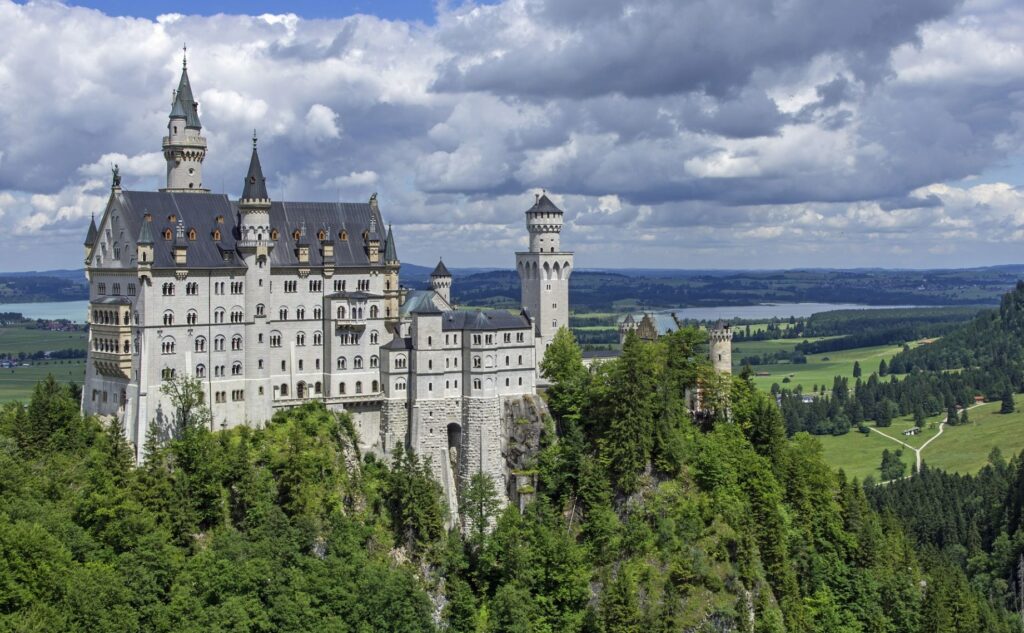
Further west is the awe-inspiring Neuschwanstein Castle, a fairy-tale-like palace nestled amidst the lush greenery of the Alps.
This was the second time I saw this Disney-inspired castle, so for me, it was a quick drive by. But, if you’ve never been here before, you’re going to want to visit here for a few hours.
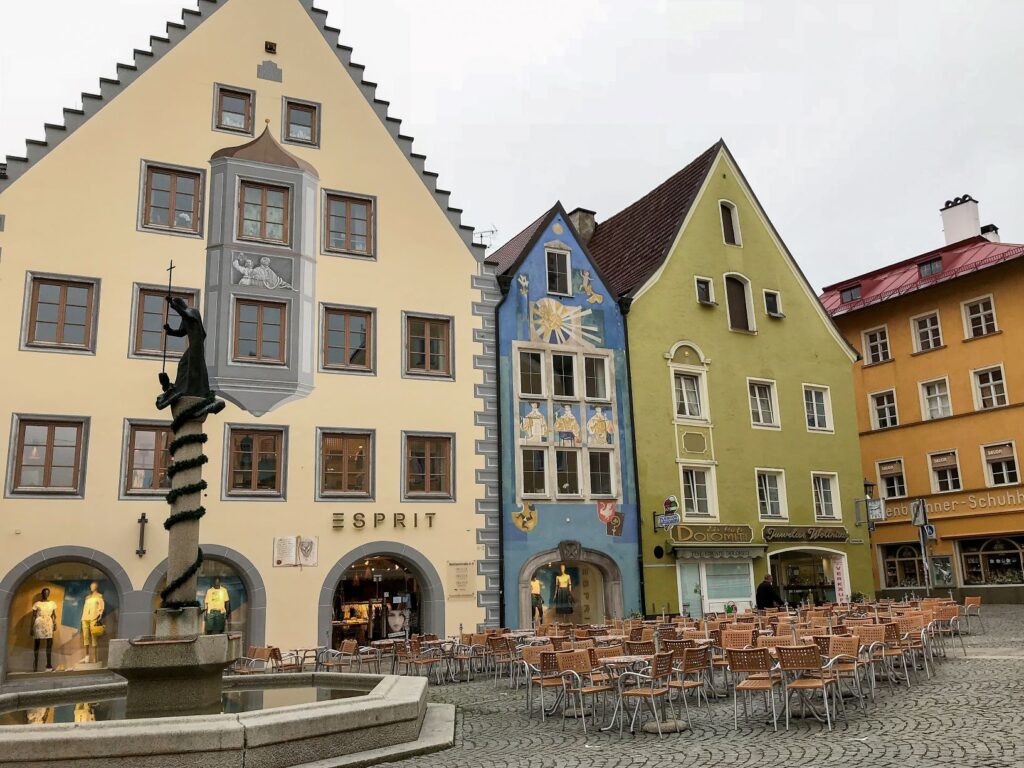
The charming town of Fussen is full of colourful buildings and cozy cafes lining the streets. I spent a couple of hours wandering through the narrow alleys, soaking up the quaint charm of this delightful town. I would’ve liked to stay for longer.
Leaving Füssen I was immediately struck by the change in landscape.
The towering peaks and rugged terrain of the Bavarian Alps give way to rolling hills and verdant valleys. Now, the sea air becomes warmer and more humid, and the landscape becomes dotted with lush vineyards and orchards.
The closer I got to Lake Constance, the more the landscape began to shift toward a holiday feel.
The sun-drenched shoreline, the abundance of flowers and gardens and picturesque harbour towns gave way. I felt like I was in another country altogether.
At last, I arrived at the relaxing holiday spot of Lake Constance and the end of the German Alps road trip!
Where I stayed in Lake Constance
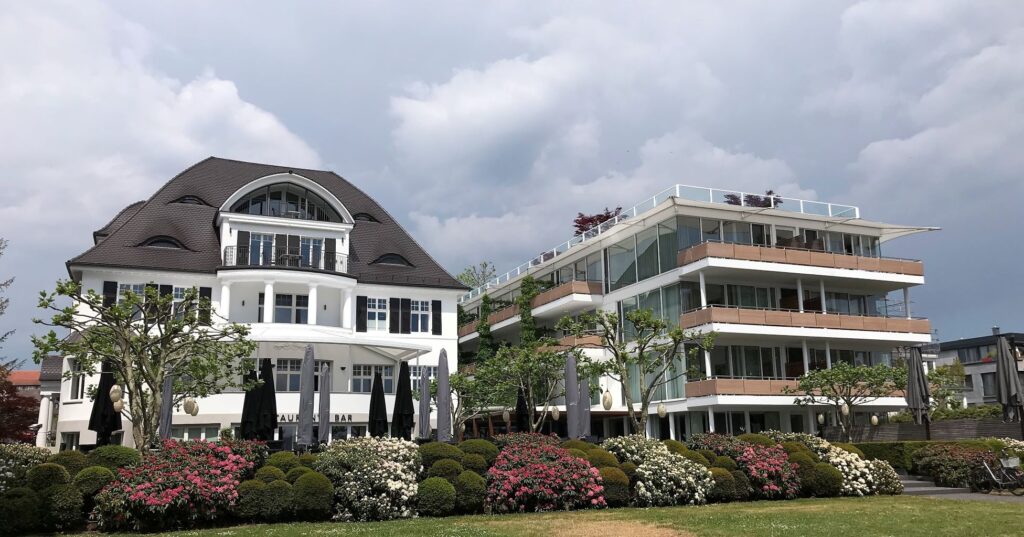
Highly recommend staying in Konstanz (or Constance) at the RIVA boutique hotel . This luxury waterfront property offers 5-star dining, spa and wellness and a gorgeous rooftop pool.
FAQ: German Alpine Road
How long does it take to drive the german alpine road.
The German Alpine Road, or Deutsche Alpenstraße, is about 450 km long and can take around 7-10 days to fully experience . However, the driving time will depend on your pace and stops along the way.
How long is it to travel from Berchtesgaden to Garmisch?
The travel time from Berchtesgaden to Garmisch is about 2.5 hours and is almost 200 km in distance.
Which part of Germany has Alps?
The southern part of Germany has the Alps mountain range, particularly the states of Bavaria and Baden-Württemberg.
What are popular road trips in Germany?
Explore the Germany Romantic Road, Black Forest High Road, and the Fairy Tale Road for picturesque landscapes, charming villages, and historic castles.
As a Holidaymaker
Driving the German Alpine route is a trip of a lifetime! Hopefully, this has inspired your next trip to Germany.
To help plan your trip, and get to know Germany better as a travel destination, visit my Travel Guide to Germany . It’s here that you will find all of my articles too.
Before you go, I’ve got another exciting German road trip that led me to nine incredible places that are UNESCO-listed destinations starting and ending in Berlin. This was created when I lived in Berlin for three months, but have adapted it as a great 10 to 14-day trip. Be sure to check it out too!

Founder, Creator of Dream Plan Experience
She specializes exclusively in European travel, focusing on five countries: France, Germany, Italy, Portugal, and Spain. For over 35 years, she has explored Europe extensively, embracing the slow travel philosophy to uncover hidden gems and authentic experiences. Living in Germany twice, she revisits these countries to create in-depth travel itineraries and destination guides tailored to those who seek immersive cultural experiences.
Through her customized services, she helps travellers plan their European trips with a focus on savouring each moment. As a co-partner in a woman-led company, she offers luxury retreats that emphasize slow travel and deep cultural connections.

Visiting Zugspitze: the Tallest Mountain in Germany
Please share if you enjoy this content!
Zugspitze is the highest peak in all of Germany and a top place to see in the Bavarian Alps. It’s located near Munich, making it a great day trip from there or Garmisch-Partenkirchen.
It’s located on the border between Germany and Austria. In this post, I’ll share how to get there from Germany, and what to do on the mountain.
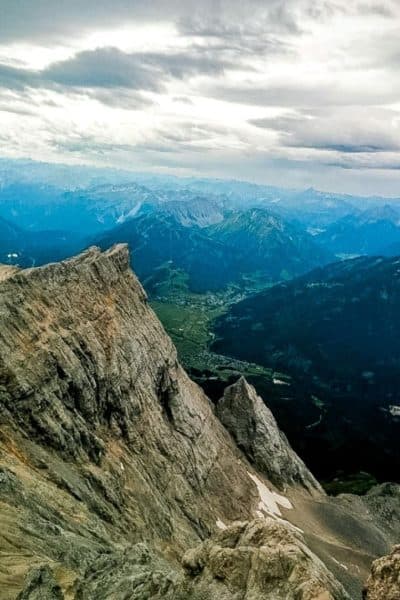
Some links in this article may be affiliate links, which means that if you purchase through them, I receive a small commission. This will never cost you extra. Please read the disclosures to learn more.
Zugspitze: The Highest Peak in the German Bavarian Alps
Zugspitze towers over Germany at 9,700 feet (almost 3,000 meters). You can’t help but feel so high up at the top! From the peak, you can enjoy stunning views of the Bavarian Alps towering into the distance, as well as the gorgeous green valleys below.
The Zugspitze marks the border of Germany and Austria, and at one time, you needed to show your passport to get to the peak between them. Now, you can ascend from both sides. Either way you go, you’ll see modern feats of engineering making the ascent with a cable car or a cog railroad.
At the top, there are two separate terraces marking each country, connected by a narrow walkway called Bavarian and Tirolian. You can’t go wrong on either side, and the views are stunning.
The peak is used for communication purposes by both the Germans and Austrians. The Austrians track data for the Innsbruck Airport air traffic control system. While it is the tallest peak in the area, I read that it was actually even a little taller.
World War II left its mark as the Germans blew off the top (of what is the Austrian side) to erect a tower to target Allied airplanes).
If you’d rather take a tour than navigate yourself, here’s a great Zugspitze tour option from Munich !
How to Get to Zugspitze
There are two primary ways to get to Zugspitze from Garmish-Partenkirchen: by gondola or cog railway. Due to traffic, it’s highly recommended that you take the train. It can take twice as long to get there if you drive.
Zugspitze Gondola (Eibsee-Seibahn Cable Car)
The Zugspitzebahn (Zugspitze train station) is separate from the Bahnhof (train station) but right next to it. Get off at Eibsee (likely with the crowd) and head towards the mountain.
The train takes approximately 30 minutes to get from Garmisch-Partenkirchen to Eibsee. It’s a short walk to the base of the mountain.
There are three ticket options to take the gondola to the Zugspitze summit. Discounts are available for families and groups. A ticket includes entrance to the museum (usually €4 or $ USD).
- Tiroler Zugspitzbahn ticket costs €51 (around $51 USD) for a round-trip ticket and €33 (around $33 USD) for a one-way ticket. It’s a 100-passenger gondola offering panoramic views. It climbs to the top in ten minutes.
- Rundreise ticket to see the glacier is € 59,50 ($ USD).
- They also offer a combination ticket with the Ehrwalder Almbahn, another cable car that goes over near the glacier, for € 61,50 ($ USD). The combination ticket may also be used for one or two days, whereas the Tiroler Zugspitzbahn ticket is for one day only.
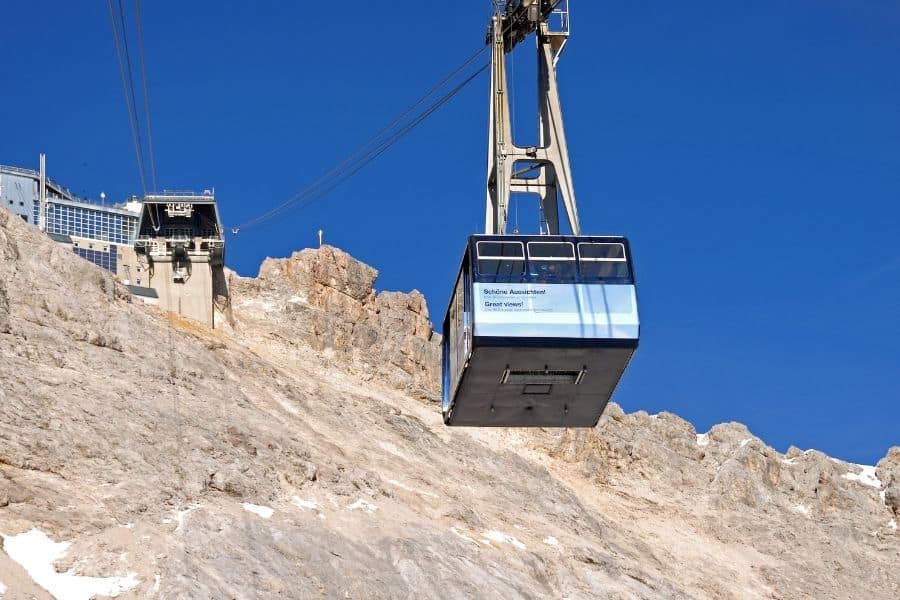
My Experience on the Zugspitze Gondola
I will admit that the gondola pretty much terrified me. I’m very afraid of heights and have done other gondolas before. However, this one climbs fast and has particularly-steep drop-offs.
And, whenever it goes over the two towers, it gives a hearty shake and drops, which did nothing for my confidence. I lived to tell about it and, thankfully, didn’t eat lunch before I went.
For those not fearful of heights, I’m sure the views during the climb were amazing. For me, I was grateful for the huge Saudi Arabian family I rode with, who spoke some English and partially blocked my view.
And the kids took turns entertaining me to provide a distraction. You make a lot of different connections when you travel solo, and this group was one of my favorite memories.
Zugspitzbahn Cog Railway
This Bayerische Zugspitzbahn cog railway is one of only a few operating in Germany. It takes you up to the plateau of the Zugspitze, around two-thirds of the way to the peak.
The train starts in Garmisch-Partenkirchen at the Zugspitzebahn. (It’s the same route, regardless if you take the cog railway or gondola up.) The train stops at several stations, including Alpspitz and Grainau. Then it continues to Eibsee and up the Zugspitze.
The cog railway stops at the Zugspitze Glacier Plateau, or Zugspitzplatt, near the peak. From there, you must take the Gletscherbahn aerial cable car to the summit. It takes a little over an hour to get there from Garmisch (or 35 minutes from Eibsee).
It costs € 59,50 (around $70 USD), including the train cost and visiting the peak.
Pro Tip: A round-trip ticket will cost the same, regardless of whether you take the train and the gondola, or the cog railway. You have the option to try both and see which you like better. If you do have a heart condition or are sensitive to high altitudes, you may be better to ascend by the cog railway train as it’s slower.
You also have the option to hike up and down or even just down. However, you must pay to hike. It costs € 46 (around $54 USD). And, if you want to bring your dog, you can for € 5.
From Munich
To get to the Zugspitze from Munich, you will take the Deutch Bahn train to Garmisch-Parternkirchen. Then, choose how you want to ascend the peak and follow those instructions for the gondola or the cog railway. The train cost starts at $21.50 USD.
Things to Do on Zugspitze
Many people visit Zugspitze and the viewing platforms at the top of the peak on both the German and Austrian sides. There are two large viewing platforms with space to walk around, restaurants, a museum, and even a Biergarten! You can also see a large glacier at the top as well.
If you love skiing and have always wanted to ski in the Alps, this is your chance! Zugspitze gets natural snow at least six months out of the year, and you can ski to your heart’s content on the highest peak in Germany. An all-day ski pass costs € 49,50 ($58 USD).
You can also hike if you’re up for the challenge. There are five hiking trails ranging in difficulty. Most of them take over 8 hours one-way, and there is an alpine hut you can stay in to break up the trek. You have the option to hike up and down, or you can take the gondola one way.
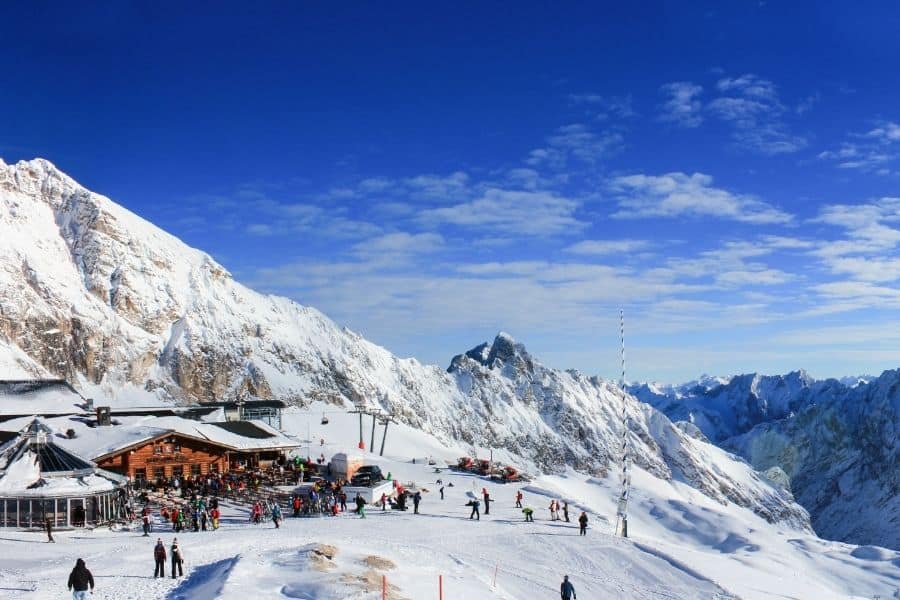
Zugspitze Viewing Platform
There are two viewing platforms at the top of the Zugspitze: one on the German side and one on the Austrian. You can now get to both when you visit from either side, though you do pass through the old passport control area on the way.
At the top, you will have plenty of company of people as well as some large black birds. They appeared quite fearless and came right over close to me when I was at the railing looking down (down, down, down!) I’m guessing people feed them.
In clear weather, you can see over 400 peaks in four different countries. How’s that for a view?
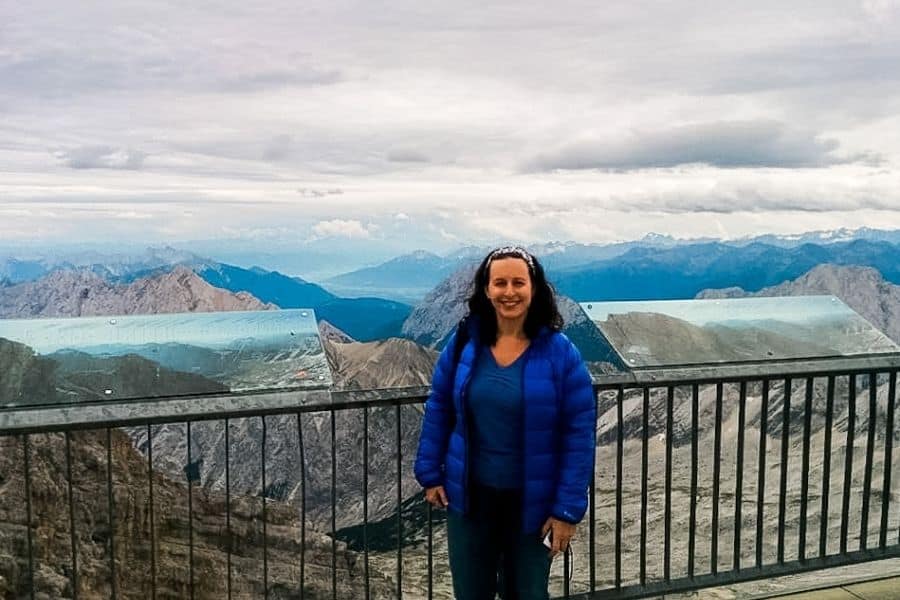
German Platform
On the German side, you can see the Zugspitzplatt Glacier near the top shrinking due to global warming. In the summer, the Germans spread a reflector over it to try to slow the melt, and the metal ski lift towers are wrapped in reflective material as well.
There is also a wedding chapel, Hochzeitskapelle, near the peak, as well as an old weather tower made of metal and wood erected back in 1900. There is also a mountaineers’ hut built in the early 1900s that is actually cinched down with heavy cables as the winds can be quite bad.
A golden cross marks the highest point in Germany. The original summit cross was placed by a priest and his friends who hiked up to the summit in 1851. Apparently, what is there is a replacement as the original was badly damaged during World War II.
You can actually go out to the cross (no, thank you!) when the weather is good. I read that there are steps and handrails to help you along the way.
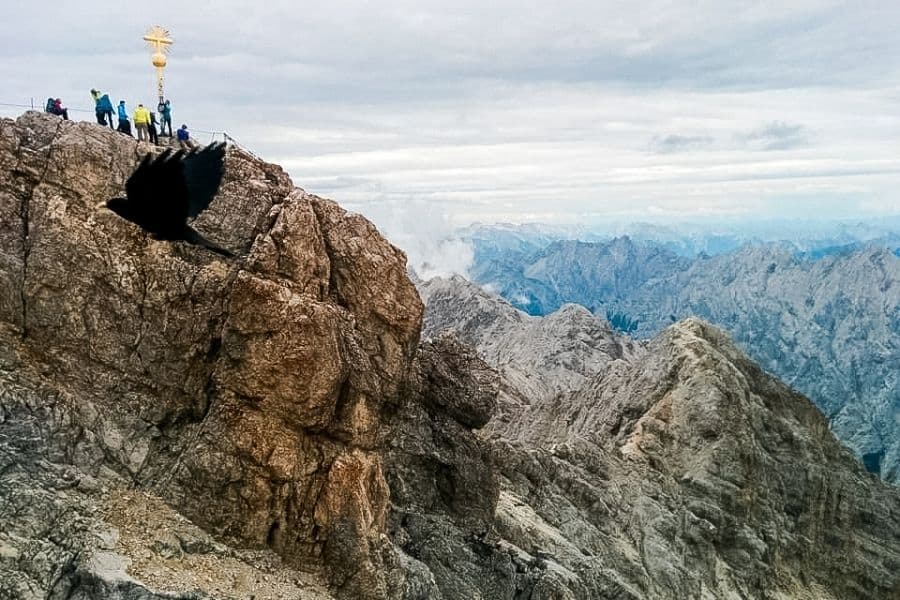
There is also a German restaurant on the platform and a large Biergarten, the highest in the country. Inside are many beautiful photos and paintings, and you can see pictures of the priest and the gold cross.
Austrian Platform
When you ascend the Zugspitze, you get access to both the German and Austrian platforms. The Austrian station has the same gorgeous views as the German side.
It also has a nice small museum that shares the story of the Zugspitze from its first documented ascent in 1820. There are also a few interesting movies, including one on the making of the lift.
When you go to leave, make sure you are on the German side and not the Austrian side. I was thankful there was a diligent woman at the Austrian gondola!
I visited the Zugspitze on the day I arrived due to the weather when I was crazy jetlagged and hadn’t slept on the flight to Germany. Thankfully, she was paying more attention than I did when I attempted to descend there! Otherwise, it may have been a much longer trip back to my apartment!
Zugspitze Weather/When to Visit the Zugspitze
Temperatures are much colder on the summit than down below, so it’s something to consider when you visit.
I went in September and was wearing thin long sleeves and jeans in Garmisch, but I brought a down jacket and gloves for the summit. It was still quite cold, but it was tolerable, especially as you can go inside to warm up.
It can snow at any time of the year on the Zugspitze. Skiing with natural snow is generally from November to early May, so it is more consistent then. The area gets rain or snow a little over half of the days of the year, though not always for the entire day. April is the wettest month, and October is the driest.
Temperatures hit a high of 43°F (6°C) in July and August. Lows at this time average around 33°F (.56). The coldest months are January and February, where highs average 17° to 20°F (around -8 to -9°C) and lows average 7° and 8°F (-13° and -14°C).
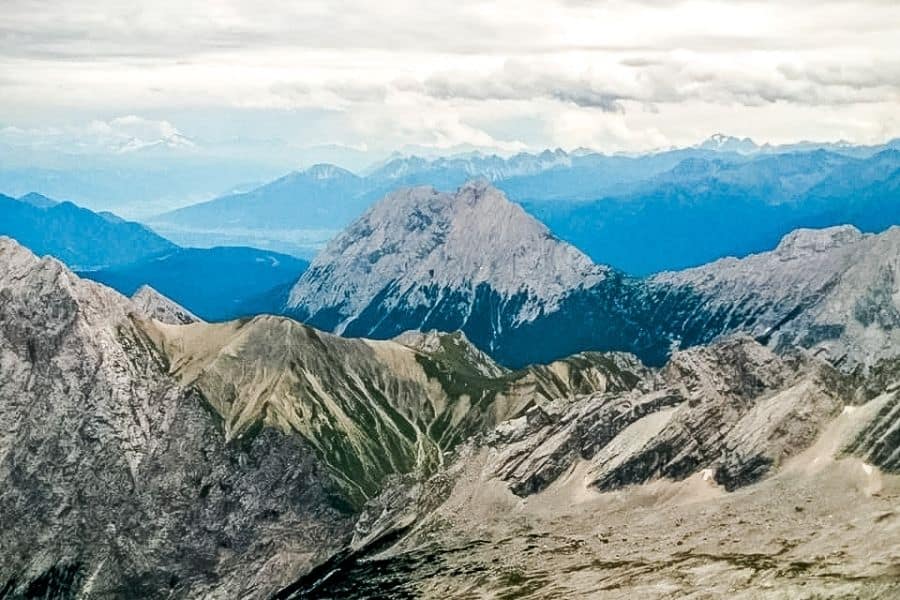
Where to Stay to Visit
Garmisch-Partenkirchen is a great place to stay when you want to visit the Zugspitze. It’s known as a ski town due to its proximity to the Zugspitze and other popular ski areas.
They were formerly two separate towns, Garmisch and Partenkirchen. However, they were joined just before the 1936 Winter Olympic Games. The town is often called “Garmisch” or “GP”; however, its true name is Garmisch Partenkirchen.
I stayed in an Airbnb apartment that was a five-minute walk to the train station. It was a small but nicely decorated and appointed studio apartment with mountain views.
The host, Mario, was wonderful! He was very responsive, gave me some great recommendations, and was actually in Garmisch when I was there and graciously offered to drive me to Munich for my next stop.
Driving on the Autobahn (even as a passenger) is a thrill! Definitely consider an apartment if you go.
You May Also Like Why You Should Visit Garmisch-Partenkirchen
Garmisch-Partenkirchen Hotels
As GP is a tourist town, there are a lot of hotels to choose from. Here is a couple that caught my eye.
Staudacherhof —If you’re looking for a cozy splurge oozing Bavarian charm, this is the place for you. It’s located near the center of Garmish, and the room decor is in Alpine style. There is a spa with an indoor and an outdoor pool, and a full buffet breakfast with local and international foods is included.
Hotel & Gasthof Fraundorfer —In a popular tourist area like Garmisch-Partenkirchen, it’s not easy to find affordable places. This one is reasonably priced and perfectly located! It’s on Partenkirchen’s historic Ludwigstraße Street. (The “ß” is pronounced like a double-S.) The rooms are lovingly decorated in a Bavarian rustic style, and the staff oozes with hospitality. They also offer typical Bavarian music and entertainment in the restaurant, along with their popular local specialties.
Hotel Königshof —If you’re looking for a place to stay that’s convenient to the slopes and the city, this is the hotel for you! It’s only a 2-minute walk from the train station and within walking distance of the cable car leading to the Zugspitze. They have mountain views, free Wi-Fi, and a great breakfast buffet. There’s also a fitness center, a sauna, and space for mountain bikes and skis.
Things to Do in Garmisch-Partenkirchen
Though one of the main draws to visiting GP is the Zugspitze, there are so many other things to do as well. It’s a great place for outdoor sports all year round.
Hike or ski the many Bavarian Alps peaks. Hike the stunning Parnatch Gorge or take in the incredible views from the many gondolas.
Stroll the beautiful streets of historic Partenkirchen or go shopping in some unique upscale stores. Garmisch-Partenkirchen offers all of this and more.
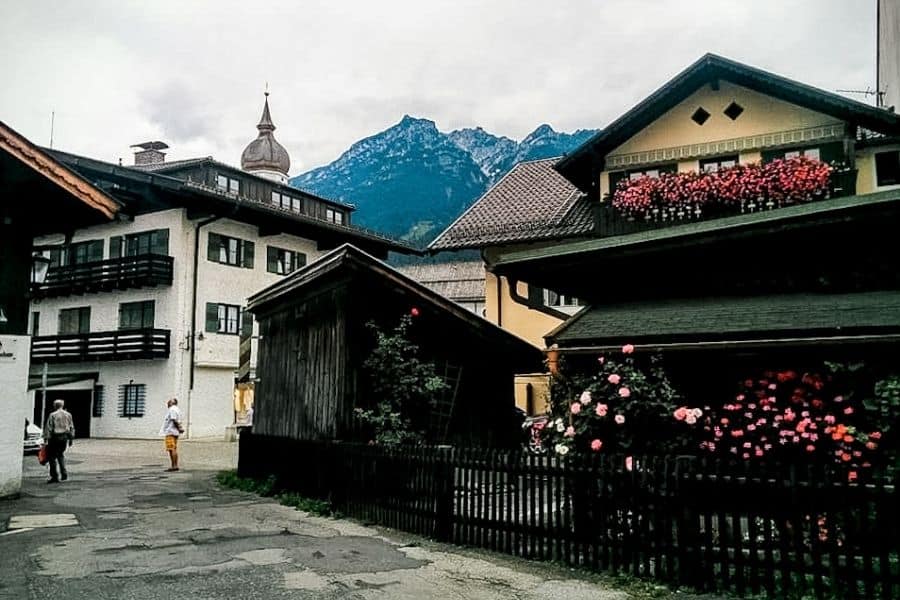
Visiting the Zugspitze is one of the highlights of a trip to the Bavarian Alps in Germany. Whether you go in the summer or in the winter, you’ll be rewarded with some of the most breathtaking views.
A visit to this area will stay with you well past your visit, leaving you wanting to return.
You Might Also Like
- The Best Places to Visit in Germany
- Neuschwanstein—One of the Most Famous Castles in Germany
- Why You Should Visit Garmisch-Partenkirchen
- 16 Interesting and Unique Things to Do in Munich
- How to Make the Most of One Day in Salzburg
- Top Ten Fun & Quirky Things to Do in Berlin
- Top 10 Things to Do in Potsdam in One Day
Like it? Pin it!
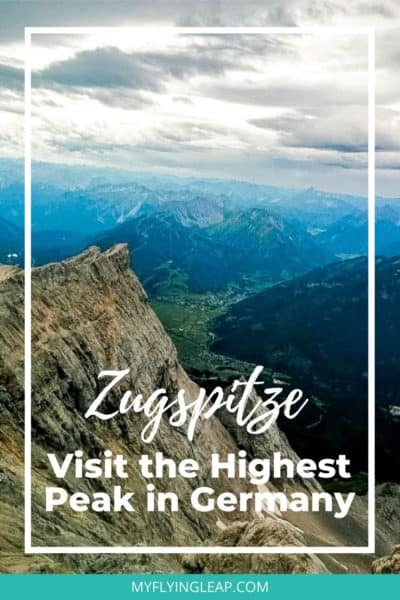
Sam is a travel-obsessed animal lover on a quest to create a life of travel with her dog. She loves learning new things, snuggling a dog, architecture, hiking, and bold red wine. Join her in creating a life to dream about!
Leave a Reply Cancel reply
Your email address will not be published. Required fields are marked *
AFFILIATE NOTICE
This website uses affiliate links, meaning I may earn a commission if you make a purchase through a link. As an Amazon Associate, I earn from qualifying purchases. Learn more .
- Exciting destinations
- Solo travel
- Travel Tips
- Travel Guides & Itineraries
- Traveling with Pets
- Work with me
The Alps and eastern Bavaria Travel Guide
Book your individual trip , stress-free with local travel experts
Select Month
- roughguides.com
- the-alps-and-eastern-bavaria
- Travel guide
- Itineraries
- Local Experts
- Travel Advice
- Accommodation
Plan your tailor-made trip with a local expert
Book securely with money-back guarantee
Travel stress-free with local assistance and 24/7 support
All the images that foreigners think most typically Bavarian accumulate in profusion in the region south of Munich, where “Mad” King Ludwig’s palaces preside over dramatically scenic alpine settings. Here, onion-domed church towers rise above brilliant green meadows, impossibly blue lakes fringe dark forests and the sparkling snow-capped peaks of the Bavarian Alps define the southern horizon.
Along the Danube
The befreiungshalle and donaudurchbruch, berchtesgaden, chiemsee and around, ettal and schloss linderhof, schloss neuschwanstein, garmisch-partenkirchen, oberammergau, steingaden and the wieskirche, walchensee and kochelsee.
Villages are tourist-brochure quaint, while traditional Tracht is by no means the fancy dress it can sometimes seem in Munich. Politically and socially, this is Bavaria at its most Catholic and conservative, though sheer numbers of visitors nowadays add a certain cosmopolitan sheen, particularly to major resorts such as Füssen or Garmisch-Partenkirchen – Germany’s highest, and most famous ski centre.
Eastern Bavaria could scarcely be more different: in place of a wall of mountains, it is defined by one of the great cultural and trading thoroughfares of Central Europe, the River Danube. Consequently its ancient cities – notably the perfectly preserved, former imperial free city of Regensburg and the prince-bishopric of Passau – bear the legacy of Rome and the influence of Italy with considerable grace, while even relatively modest towns such as Straubing and Landshut preserve architectural wonders from their distant golden ages. Only along its eastern boundary with the Czech Republic do natural wonders again triumph over cultural richness, in the vast, relatively sparsely populated forests of the Bayerischer Wald (Bavarian Forest).
Getting around the region is remarkably easy: Regensburg, Passau, Garmisch-Partenkirchen and the Berchtesgadener Land are all linked into the Autobahn network, while train services connect Munich with the major towns and reach into the Alps as far as Füssen, Garmisch-Partenkirchen and Berchtesgaden. Where train services end, buses take over, with services linking at least the most important tourist sites relatively frequently.
Travel ideas for Germany
Created by local experts
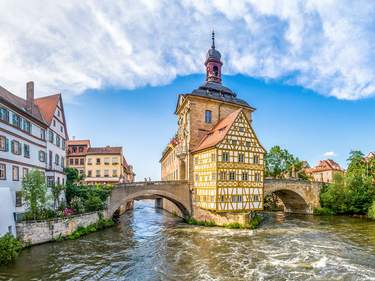
A self drive exploration of UNESCO Sites in Southern Germany
Explore UNESCO World Heritage Sites across different German states. This self drive trip allows you to design your own days with recommendations stated for each day.
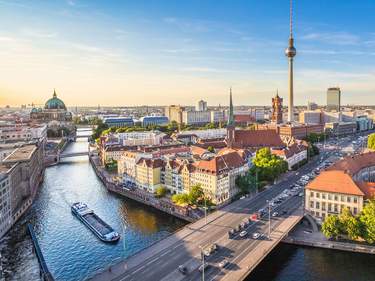
Explore Berlin and Potsdam in depth
The German capital Berlin has plenty to offer: from historical sites to world-class museums and a vibrant nightlife. Enjoy this private tour to explore a wide range of activities in Berlin and Potsdam, including several UNESCO World Heritage Sites.
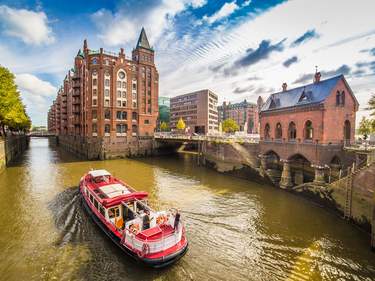
Explore Northern Germany on Your Own
From Bremen to Stralsund - Northern Germany offers plenty of gems to explore. With well-developed public transportation links, this itinerary is suited for everyone wanting to explore on their own - getting lost on the cobble-stoned streets of many UNESCO World Heritage Highlights.
_listing_1640546826392.jpeg)
Capitals of Europe - Berlin, Prague, Vienna and more
This trip is ideal for all city & culture lovers: the Reichstag in Berlin, the castle in Prague, historical Cesky Krumlov, St Stephen's Cathedral in Vienna, the fortress above Salzburg and Schloss Neuschwanstein near Munich - these are just some of the highlights of this incredible roundup trip.
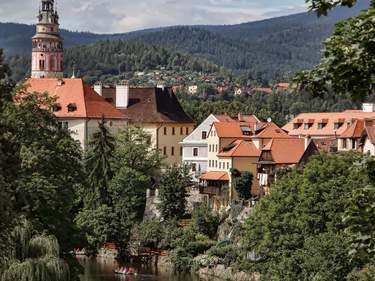
Castles across Austria and Czechia
Austria and Czechia are home to some of the world's most beautiful architecture and culture gems, such as Schloss Schönbrunn in Vienna, Prague castle, the fortress above Salzburg and many more. Finish your tour with a visit to Schloss Neuschwanstein before flying out of Munich.
_listing_1640551981693.jpeg)
Best of Germany
Germany has a lot to offer to visitors: history buffs will enjoy guided tours in Berlin and Dresden, children (and those at heart) will marvel at Schloss Neuschwanstein, scenery lovers will appreciate Rothenburg and the Black Forest. This trip truly has something for everybody!
Topography has determined the character of Eastern Bavaria every bit as much as the Alps have shaped the south of the state. A vast, uninterrupted belt of forested upland – the Bayerischer Wald or Bavarian Forest – guards Bavaria’s eastern flank on the border with the Czech Republic. It’s a sparsely populated and – compared with much of the rest of Bavaria – still relatively little-visited tract, which was for decades a sort of rural cul-de-sac running northwest to southeast along the Iron Curtain. In contrast, immediately to the west of the Bayerischer Wald, the valley of the Danube runs parallel to the border, and is one of the great natural trade routes of Central Europe. Strung out along it is a series of attractive small cities, each of which has known some glory in its past: Regensburg , the largest of them, is a former free imperial city with one of the best-preserved medieval cityscapes in Central Europe; in the south, Passau is a former prince-bishopric with more than a touch of Italy in its monuments. Between the two, Straubing looks back to a distant golden age as the capital of a strange medieval Duchy that straddled Bavaria and the Netherlands. Not to be forgotten is Landshut on the River Isar, the ancestral seat of the Wittelsbach dynasty.
Capital of Lower Bavaria for the past eight hundred years and for a brief period in the thirteenth century Munich’s predecessor as the Wittelsbachs’ main seat, LANDSHUT has architectural splendours that quite outshine its present status as a bustling but essentially provincial town midway between Munich and Regensburg. Its glory days came under the so-called “rich dukes” between 1393 and 1503, when it was the seat of government for the duchy of Bayern-Landshut. The 1475 wedding of one of the dukes, Georg, to Jadwiga (Hedwig in German) – daughter of the Polish king – was one of the most lavish celebrations of the late Middle Ages, and it provides a template for the town’s most celebrated festival – the Landshuter Hochzeit or Landshut Wedding – to this day.
With a memorable – and flood-prone – location on the Austrian border at the confluence of the rivers Inn, Ilz and Danube, PASSAU has a lively, cosmopolitan feel that quite belies its modest size. A city of just 50,000 inhabitants, it has nevertheless long been an important place. There was a Roman fort on the site from around 80 AD, a bishopric was founded here in 739 AD and this was raised to the status of an independent prince-bishopric in 1217, a status it retained for centuries until, secularized and annexed, it shared the fate of the other Bavarian prince-bishoprics at the start of the nineteenth century. Passau also rates a mention in the Nibelungenlied , the epic poem that formed the basis for Wagner’s Ring , as the heroine Kriemhild is welcomed to the city by her uncle Bishop Pilgrim.
The Altstadt
Passau’s long history of independence has left it with an impressive array of monuments gracing its Altstadt, which occupies a narrow wedge of land between the Inn and Danube. There’s a blend of Central European and Italian Baroque architectural influences similar to that other great ecclesiastical city-state, Salzburg, though here the ice-cream colours add a sunny, southern glow that not even Salzburg can match. Add to that a mighty, photogenic fortress and the buzz created by its university and the cruise ships that depart its quays for Vienna, Bratislava and Budapest, and Passau is well worth an overnight stop.
The most distinctive feature of Passau’s Altstadt is its location on a tapering peninsula at the point where the Danube and Inn meet, and the best place to experience the drama of its situation is in the little park at the eastern tip of the peninsula, or Dreiflüsseeck . Almost tucked out of sight behind the fifteenth-century Veste Niederhaus – the lower part of Passau’s massive medieval fortress complex – is the Ilz, very much the junior of the three rivers, which flows into the Danube from the north just before its confluence with the Inn.
Spared from devastation in the twentieth century’s wars, timeless REGENSBURG (Ratisbon in English, though the name is nowadays little used) preserves the appearance of an important medieval trading-city better than just about anywhere else in Central Europe. It’s the only major medieval city in Germany to remain intact. The Regensburg you see today to a remarkable extent preserves its fourteenth-century street layout and much of the architecture – secular and religious – that reflects how it must have looked during its medieval zenith.
Straddling routes to Italy, Bohemia, Russia and Byzantium, Regensburg had trading links that stretched as far as the Silk Road. Trade brought cultural interchange too, and the mighty tower houses of the city’s medieval merchants – so reminiscent of Italy – are found nowhere else north of the Alps. No wonder UNESCO added the old Town of Regensburg and Stadtamhof to its list of World Heritage Sites in 2006.
Glorious though its architectural heritage may be, this vibrant city is no museum piece. What makes it particularly special is the way its thousand or so historic monuments act as a backdrop for the very contemporary tastes and concerns of its modern citizens, who include large numbers of students. For visitors, Regensburg is a surprisingly multifaceted place, well worth a stay of a few days or so.
Brief history
Remarkably, the city is actually even older than it looks. The Romans founded a fort here as part of the empire’s Limes, or military frontier, in the then-uninhabited region of Donaubogen in 80 AD; it was destroyed in an attack by Marcomanni tribes in 167 AD, only to be re-established as a legion fortress under the name Castra Regina on the site of the present-day Altstadt. As the western Roman Empire died in the fifth century AD, the Roman inhabitants were gradually replaced by Germanic settlers. A bishopric from 739 AD, Regensburg also became a free imperial city in 1245.
STRAUBING stands at the heart of the Gäuboden, a rich grain-producing district that stretches along the Danube midway between Passau and Regensburg. The Lower Bavarian town experienced a relatively brief but glorious heyday between 1353 and 1425 as the capital of the lesser, Bavarian portion of the eccentric independent Duchy of Straubing-Holland, the greater portion of whose territories lay in the present-day Netherlands.
Southwest of Regensburg at KELHEIM , on a romantic bluff high above the river, the Befreiungshalle (Liberation Hall) was Ludwig’s monument to the wars of liberation against Napoleon and to the idea of German unity. It was begun in 1842 by Friedrich von Gärtner but completed after Gärtner’s death by Leo von Klenze. From the outside, the drum-shaped building looks a little like a Neoclassical gasometer fashioned from painted stucco; the spectacular interior is ringed by 34 winged goddesses of victory with the names of Austrian, Prussian and Bavarian generals picked out in gold above them. A narrow staircase ascends to an internal gallery from which you can better admire the sheer spaciousness of the hall; beyond it, a stone staircase leads to an exterior gallery, well worth the climb for the views over Kelheim and the lovely Donaudurchbruch , a narrow, cliff-rimmed stretch of the Danube to the west of the town that is one of the region’s most beloved excursions.
Kloster Weltenburg
The Donaudurchbruch ends at Kloster Weltenburg , wedged scenically between the river and cliffs. The baroque abbey church is the work of the Asam brothers, but Weltenburg is altogether more famous for its brewery, which claims to be the world’s oldest abbey brewery and produces the excellent Barock Dunkel beer. You can sample it at the Klosterschänke in the main courtyard. The most popular way to reach Weltenburg is on a boat trip from Kelheim, but hiking trails through the gorge allow a more leisured appreciation of the exceptional landscape, which forms the Weltenburger Enge nature reserve. The closest route to the gorge follows the north bank; there’s a simple ferry across the river to the abbey at Weltenburg itself.
Shaped like a figure of eight and pushing south deep into Austria’s Salzburger Land, the compact territory of Berchtesgadener Land contains some of Germany’s loveliest Alpine scenery and, in the south, its third highest mountain, the 2713m Watzmann . Reached most easily via Austria and almost walled in by its mountains, the rugged southern part of the Land has the feel of a separate little country. For much of its history it was an independent bishopric growing fat on its precious salt deposits, in many ways a smaller version of its eastern neighbour, Salzburg; their ways only diverged after the 1803 secularization, with Salzburg ultimately passing to Austria and Berchtesgaden to Bavaria. The region attracted notoriety in the 1930s and 1940s as the preferred holiday-home (and putative last redoubt) of Adolf Hitler, whose “ Eagle’s Nest ” has since become one of its most popular attractions. In the summer months, the Nationalpark Berchtesgaden is a paradise for hikers and day-trippers alike; in winter, there’s skiing on the Jenner , at Rossfeld and on the Hirschkaser west of Berchtesgaden, though at times the region’s scenic beauty can be wreathed in dense, icy fog. Capital and natural focus of the Land is the little town of BERCHTESGADEN itself, also known as Markt Berchtesgaden to distinguish it from the wider Land; deep eaves, chalet-style architecture and elaborate Lüftmalerei images give it a quaintly Alpine look, reinforced by the exhilarating mountain views available from much of the town. A second focus for visitors is provided by the prim spa-town of Bad Reichenhall to the north.
Obersalzberg and the Eagle’s Nest
Though its mountain panoramas are as breathtaking as any in the German Alps, Nazi associations hang over OBERSALZBERG like an evil spell from some Grimm tale. Hitler knew and loved the scattered settlement 3km east of Berchtesgaden long before he came to power; after 1933 the new regime expropriated locals to turn the entire mountainside into a sprawling private fiefdom for Nazi bigwigs, many of whom had their holiday homes here. The most notable of these was Hitler’s Berghof , bought and extended with the royalties from sales of Mein Kampf ; the dictator invited diplomatic guests here – including British prime minister Neville Chamberlain at the time of the Sudetenland crisis in 1938 – to be overawed by the scenic setting and the magnificent panorama from its famous picture-window. As war progressed and Allied air raids on German cities underlined the vulnerability of the site to air attack, a vast system of bunkers was built beneath the mountainside, but in the event the feared “last stand” of the SS never happened here. British bombers destroyed much of the complex in 1945; afterwards, the ruins were largely demolished.
Dokumentation Obersalzberg
Close to the site of the Berghof stands the Dokumentation Obersalzberg , a fascinating exhibition on the rise, fall and crimes of the Nazi movement, its mythology and its association with Obersalzberg. As you reach the latter stages of the exhibition, you descend into a decidedly spooky preserved section of the bunker complex, which was built from 1943 onwards.
The Eagle’s Nest
Frequent buses depart from the terminus on the far side of the car park by the Dokumentation Obersalzberg, climbing the spectacular 6.5km Kehlsteinstrasse in the first stage of the ascent to Hitler’s celebrated teahouse, the Kehlsteinhaus , or Eagle’s Nest as it is known in English, which is preserved in more or less its original condition. The ascent is very much part of the experience: the narrow, twisting cobbled road – blasted from solid rock in just thirteen months in 1937 and 1938 – ascends 700m and passes through five tunnels. The buses make the journey at a cracking pace, so anyone prone to vertigo may want to sit on the side of the bus away from the view. You alight next to the tunnel leading to the lift which ascends through solid rock to the teahouse; before you enter, you have to decide which bus you’re going to return on and get your ticket stamped accordingly.
Once you reach the teahouse itself – now a restaurant – how long you stay depends on the weather conditions: if it’s clear, the views are genuinely breathtaking and it’s worth wandering across the narrow summit for the views back to the building; if not, a quick glance at the photographic exhibition will suffice. The Kehlsteinstrasse and teahouse were commissioned by Martin Bormann as the Nazi party’s fiftieth birthday present to Hitler using funds donated to the party by industrialists, but after an initial rush of enthusiasm in 1938 Hitler rarely visited, fearing lightning strikes and attack from the air. Eva Braun used it more frequently: since she didn’t officially exist, she had to make herself scarce during diplomatic visits to the Berghof, and would come here to sunbathe.
A shimmering expanse of silvery waters with a backdrop of distant Alps, Chiemsee is often referred to as the Bavarian Sea. Sheer size alone would justify the claim, for the lake covers eighty square kilometres and is tidal. But its origins also make the tag appropriate, for Chiemsee is a remnant of the primeval Thetis Sea which once covered half of Europe. In summer, it’s a magnet for active tourism, notably sailing; in winter, much of the lake freezes over, particularly at the placid southern end. The lake’s most famous attraction is Ludwig II’s Schloss on the island of Herrenchiemsee , an extravagant (and unfinished) attempt to re-create the palace of Versailles in a Bavarian setting. The best place to stay for exploring Chiemsee is the spirited lakeside town of Prien ; it’s connected by rail to the mountain resort of Aschau im Chiemgau to the south, which makes an excellent base for hiking across the border into Austria.
Outdoor activities in Chiemsee
The real reason to come to Prien is to get away from it, with plenty of options for exploring the lake area. Prien’s tourist office also has information on many other activities in the area, from ballooning over the lake to Nordic walking, paragliding, rafting and canyoning.
From Prien, a cycle route – the Chiemsee Uferweg – circuits the lakeshore for 60km, sticking close to the shore and in many places passing suitable bathing spots. You can rent bikes from Chiemgauer Radhaus at Bahnhofsplatz 6 (08051 46 31) or Fahrradhaus Prien, Hallwanger Str. 22 (08051 59 34). Numerous other cycle routes radiate from the shore of the lake into the surrounding countryside.
A route for hikers , the Priental-Weg, links Prien with Aschau, and there’s another relatively short hiking trail, the Uferweg Chiemsee, hugging the western shore of the lake to the north and south of Prien. From mid-May to early October, a hikers’ and cyclists’ bus (#9586) circuits the lake daily with a trailer to take bikes.
If you want to learn to sail , head for the Segelschule Prien am Chiemsee, Gladiolenweg 3 (08051 34 38, segelschule-prien.de ), which offers two-and-a-half-day practical and theoretical courses at €195.
Swimming and sauna
There’s also a very fancy beach , pool and sauna complex, Prienavera , right on the lakefront at Seestr. 120 (pool Mon–Fri 10am–9pm, Sat & Sun 9am–9pm; beach May–Sept daily 9am–8pm; pool from €4.50; 08051 60 95 70, prienavera.de).
Slotted into a narrow gap in the mountains between Oberammergau and Oberau and, if possible, even more improbably pretty than Oberammergau, the tiny village of ETTAL is utterly dominated by its magnificent Benedictine abbey, Kloster Ettal .
Kloster Ettal
Kloster Ettal was rebuilt in its present, showily Baroque form between 1744 and 1753 by Joseph Schmuzer, who was required to replace the still-incomplete work of his fellow architect Enrico Zuccalli after the church was devastated by fire in 1744. Despite the overwhelmingly Baroque appearance of his work, bits of the old church were incorporated into the present structure – you pass through a fourteenth-century Gothic portal on your way into the church. The domed interior is quite breathtaking, with frescoes by the Tyroleans Johann Jakob Zeiller and Martin Knoller. After you’ve admired the church, you can stock up on carvings, candles, liqueurs and Ettaler beer in the abbey shop.
Schloss Linderhof
Tucked into a narrow valley some 11.5km west of Ettal, Ludwig II’s Schloss Linderhof was originally a hunting lodge belonging to Ludwig’s father Maximilian II. The palace was enlarged and re-clad between 1870 and 1878 by Georg Dollmann, who was later to design Schloss Herrenchiemsee. Unlike that palace, Linderhof was actually completed during Ludwig’s lifetime. It looks relatively modest from the outside, but the elaborate neo-Rococo interiors are anything but: the riot of gold leaf reaches a crescendo in the king’s staggeringly ornate bedroom, which is the largest room in the house.
The park surrounding the Schloss is delightful, and is particularly known for its fountains , which perform every half-hour from April to mid-October. There are several highly theatrical follies in the grounds, including the Maurische Kiosk (Moorish kiosk) and the spectacular Venus-Grotte , an artificial cave with a lake, fake stalactites and stalagmites, and a golden barge with cupid as a figurehead – all inspired by Wagner’s opera, Tannhäuser .
The first – or last – stop on the Romantic Road is FÜSSEN , in a beautiful setting on the River Lech at the southwest end of the broad Forggensee hard by the Austrian border. The town is dominated by its Late-Gothic Schloss Neuschwanstein and by the impressive buildings of the former Benedictine abbey of St Mang, and is much the liveliest place in the district, with a compact Altstadt that fizzes with activity at any time of year.
No mere tourist spot, Füssen is also a garrison town, home to a couple of battalions of the German army’s mountain troops. With a direct rail connection from Munich, moreover, it’s the most practical base from which to explore the sights of the eastern Allgäu, including the royal castles at Hohenschwangau. It likewise makes an ideal base for hikers and cyclists, with an extensive network of walking and bike trails fanning out into the surrounding district, including some that cross the border into Austria.
The vision of the pinnacled and turreted castle of Neuschwanstein , perched high on its crag and rising above the mist, is perhaps the most reproduced of all tourist images of Germany, a Disney-like fantasy amid a setting of breathtaking alpine beauty. Neuschwanstein is not the only royal castle at Hohenschwangau: if it weren’t literally and figuratively overshadowed by Neuschwanstein, Hohenschwangau , in the valley below Ludwig’s castle at the southern end of the village, might be more widely famous.
Schloss Hohenschwangau
Standing on a low wooded hill above Alpsee, Schloss Hohenschwangau was a ruin when Ludwig’s father, Maximilian II, bought it in 1832 while still crown prince, and had it rebuilt in a prettily romantic neo-Gothic style. Ludwig II spent much of his childhood here, and it was here that he first encountered the legend of Lohengrin , the Swan Knight; the Schloss is decorated with frescoes on the theme by Michael Neher and Lorenz Quaglio. Schloss Hohenschwangau still belongs to a Wittelsbach trust, not to the state of Bavaria, and part of its charm is that it feels altogether more homely than its showy neighbour.
“Mad” King Ludwig II
For someone who was so shy and reclusive in life, King Ludwig II has achieved remarkable and lasting popularity in death. Born at Schloss Nymphenburg in 1845, he had spirited good looks not unlike those of his cousin, the Austrian Empress Elisabeth, and cut quite a dash when he came to the Bavarian throne in 1864 at the age of 18. Ludwig was fascinated with the French royal dynasty, the Bourbons, to which his own family was related. This developed into a fixation with the most illustrious of the Bourbons, Louis XIV, whose absolute power contrasted so starkly with the relative powerlessness of the Bavarian monarchy after its defeat alongside Austria in the 1866 war against Prussia. Seemingly overcompensating for this political impotence, the king retreated increasingly into an extravagant fantasy world, becoming steadily more eccentric and – towards the end of his life – rather corpulent.
He was a patron of Richard Wagner, whose fantastical operas fired the king’s own vivid imagination, and though he disapproved of Wagner’s anti-Semitism he continued to support the composer financially, even planning a lavish festival theatre to host the composer’s operas in Munich, which was to remain unbuilt. A political reactionary but at the same time a romantic, Ludwig devoted his attention to fabulous but ruinously expensive projects to realize his fantasies in built form: a castle straight from the age of chivalry at Neuschwanstein , a homage to the Sun King at Herrenchiemsee and an eclectic but breathtakingly opulent “villa” at Linderhof . Eventually his spending caught up with him, as foreign banks threatened to foreclose. Ludwig’s refusal to react to this crisis in rational fashion prompted the Bavarian government to act unconstitutionally, declaring him insane and removing him from the throne. He was interned at the castle of Berg on Starnberger See, where he and his doctor were discovered drowned in mysterious circumstances on June 13, 1886. Very shortly afterwards his palaces – which had been intensely private places during his life – were opened to the paying public.
If Schloss Neuschwanstein seems too good to be true, that’s no surprise. The most theatrical of all “Mad” King Ludwig II’s castles has its origins in his desire to rebuild an existing ruin in the style of the German Middle Ages. Ludwig was inspired by the recently restored Wartburg in Thuringia; his architects, Eduard Riedel and Georg Dollmann – who would go on to design Linderhof and Herrenchiemsee – worked from drawings by theatre designer Christian Jank. Work began in 1869, the castle was “topped out” in 1880 and the king was able to move into the (still unfinished) Pallas, or castle keep, in 1884. Ludwig chopped and changed the plans as he went along, incorporating a huge throne room that required modern steel-framed construction methods to make it viable.
The exterior of Neuschwanstein, in a sort of exaggerated Romanesque, is theatrical enough, but the real flights of fancy begin inside, where the decorative schemes are inspired by Wagner’s operas Tannhäuser and Lohengrin . The Byzantine-style Thronsaal (Throne Room), inspired by the church of Hagia Sophia in Istanbul, was intended to represent the Grail Hall from Parsifal and was completed in the year of Ludwig’s death, 1886. Ludwig’s bedroom is in a heightened Gothic style, with the king’s four-poster bed more closely resembling some fifteenth-century church altar than a place in which to sleep. The highlight – and peak of the king’s Wagnerian obsession – however, is the Sängersaal , or Singers’ Hall, which occupies the entire fourth floor and was inspired by the famous hall at the Wartburg that was the scene of the Singers’ Contest from Tannhäuser .
If you’ve not seen it on your way from the bus, it’s worth strolling uphill to the Marienbrücke after the tour finishes for the dramatic views down into the Pöllat gorge and across to the castle.
As the hyphen in its name suggests, the chic skiing resort of GARMISCH-PARTENKIRCHEN was originally not one alpine village but two, which faced each other across the Partnach stream and were united in a shotgun wedding in time for the 1936 Winter Olympics. The Games were an enormous success – so much so that the town was slated to host the 1940 Winter Games after the Japanese city of Sapporo withdrew. In the event, of course, war intervened and the 1940 Games didn’t take place, but Garmisch-Partenkirchen has been on the international winter-sports map ever since, which gives the resort a relatively cosmopolitan air. Though any clear distinction between Garmisch and Partenkirchen has long since vanished, the two halves of the town do have sharply contrasting characters: Garmisch is lively and international, while Partenkirchen better preserves its original alpine charm. Looming over them both is the Zugspitze , at 2962m Germany’s highest mountain. In summer, the town’s mountainous setting attracts hikers and climbers.
The Zugspitze massif
To get to the top of the Zugspitze , Germany’s highest peak, take the Zugspitzbahn cogwheel railway from the Bahnhof Zugspitzbahn alongside Garmisch-Partenkirchen’s Hauptbahnhof at least as far as Eibsee , where you can either stay on the cog railway, or else transfer to the dramatic (and much faster) Eibseeseilbahn cable car, which ascends nearly 2000m to the summit in ten minutes. If you stick with the train, you’re deposited on the Schneefern glacier on the Zugspitzplatt plateau below the peak, from where you complete the journey to the summit on the ultramodern Gletscherbahn cable car. At the summit, there’s a second cable-car station – the top of the Tiroler Zugspitzbahn , which ascends from the Austrian side. There’s a redundant frontier post between the two stations. Descent back to the valley is via the Eibseeseilbahn cable car with a transfer to the cogwheel railway for the remainder of the return journey down to Garmisch Partenkirchen.
From November to April the Zugspitzplatt offers Germany’s highest skiing , with powder snow, a range of red and blue runs and spectacular views, extending in clear weather as far as Italy and Switzerland. For a brief period in midwinter you can also stay in an igloo hotel ( iglu-dorf.com ; €99 per person per night). In summer, there is a limited selection of short hikes, including one which crosses the glacier to the Windloch observation point, from which you have good views of Ehrwald in Tyrol, 2000m below. The descent on foot to Garmisch-Partenkirchen is only for the fit, and takes seven to ten hours, though many choose to break the journey overnight at the Reintalangerhütte (refuge operated by the German Alpine Association;00821 7089743; dorm or double €13 per person; half-board €20 per person).
Nestling at the foot of the Ammergauer Alpen between the distinctive peaks of Kofel (1342m) and Laber (1684m), the highly photogenic village of OBERAMMERGAU has achieved international fame thanks to the Passion Play , which depicts the life of Jesus and is performed by local people every ten years in a purpose-built theatre; it will be performed again in 2020. It has its origins in a promise by the villagers in the seventeenth century to perform a play if God would spare them the effects of the plague, which was then ravaging the region.
Smaller and less developed than its neighbour, Schliersee has a similarly sublime mountain backdrop and clear waters, but where Tegernsee has a sophisticated air, in Schliersee cows graze in the centre of the village. Dominating the lakefront is the big modern Vitalwelt spa complex, which contains a pool, sauna, solarium, whirlpool and water slides (daily 10am–8pm; €4.50 for 90min, €8 for 3 hr, Tageskarte €10). Boats of the Schlierseeschifffhahrt depart the nearby landing stage for 45-minute cruises to the island of Wörth in the centre of the lake (hourly; €5). On the eastern side of the village a cable car ascends to the 1061m Schliersbergalm (daily: 8.30am–10pm; €7 return, €4 single) for panoramic views over the lake; there’s also mini-golf and a summer toboggan run.
The Romantic Road reaches one of its highlights at STEINGADEN , which stands in rolling countryside 21km northeast of Füssen in the placid rural district known as the Pfaffenwinkel, or Clerics’ Corner – so called because of its numerous churches and monasteries. In most respects it’s a fairly modest country town, clustering around the Welfenmünster , a handsome former abbey church that preserves its Romanesque exterior appearance and cloister but is otherwise flamboyantly Baroque.
The Wieskirche
Fine though the Welfenmünster is, this is not the church that brings visitors from across the world to Steingaden. They come instead to see the Wieskirche , or meadow church, in the tiny hamlet of Wies 5km southeast of town. In 1738 farmer’s wife Maria Lory spotted tears coming from the eyes of an abandoned figure of a scourged Christ; the site became a place of pilgrimage, and two years later a tiny chapel was built to accommodate the flow of pilgrims. Sheer visitor numbers soon overwhelmed it, however, and so the present church was begun in 1745 to the designs of Dominikus Zimmermann. It was consecrated in 1754.
Though the exterior is handsome enough, nothing prepares you for the overwhelming grace and beauty of the interior – a vision of a Rococo heaven in pastel shades, with ceiling frescoes by Dominikus’s elder brother Johann Baptist, whose work also graces the monastery of Kloster Andechs and the Wittelsbachs’ summer palace at Nymphenburg.
The church is generally regarded as one of the pinnacles of the Rococo style, and it was added to UNESCO’s World Heritage list in 1983. The church is busy with tour groups in summer, but it’s a magical (if freezing cold) experience to visit in midwinter, when you might just have the place to yourself. In the summer months it is also the venue for evening concerts.
With its crystal waters dotted with boats, beautiful mountain backdrop and neat lakeside villages, Tegernsee is a classic Alpine lake resort, the terminus of a direct rail link with Munich. It’s a chic spot, its upmarket status buttressed by smart hotels and a brace of 18-hole golf courses , though it’s also popular for cycling , with an annual mountain-biking festival in the late spring and a number of biking trails in the surrounding mountains. The lake’s obvious focus is the village of Tegernsee itself, which stretches along the eastern shore. Pride of place on the lakefront is taken by the Strandbad Tegernsee , a modern bathing complex that includes a beach, café and sauna (Mon–Thurs 10am–11pm, Fri & Sat 10am–midnight, Sun 10am–9pm; from €12).
A little way back from the shore is Schloss Tegernsee , a former Benedictine abbey which is now the seat of the ducal line of the Wittelsbach dynasty. You can visit the former abbey church of St Quirinus , whose airy Baroque interior is enriched with frescoes by Georg Asam. After a visit to the Olaf Gulbransson Museum you could hire a boat from Rixner by the Schloss-Café (€5 per person for 30min) or take a lake cruise with the Schifffahrt Tegernsee (Seestr. 70a; May–Oct 10am–6.30pm, departures approx. every 30min–1hr; €12.90; seenschifffahrt.de).
North of Mittenwald, the unequal twin lakes of Walchensee and Kochelsee are connected by a twisting, scenic pass across the narrow ridge of the Kocheler Berge . The 300m difference in altitude between the two has been used to generate electricity since 1924, and there’s a visitor centre at the hydroelectric power station, Erlebniskraftwerk Walchensee (daily 9am–5pm). Walchensee is the bigger and higher of the two lakes, ringed by wooded mountains and with enough wind to ensure it’s a popular spot for windsurfing and dinghy sailing in summer. Kochelsee is altogether less wild, the mountains on its southern shore giving way to a gentle, pastoral landscape to the north.
The Rough Guides to Germany and related travel guides
In-depth, easy-to-use travel guides filled with expert advice.

Find even more inspiration for Germany here

Planning your own trip? Prepare for your trip
Use Rough Guides' trusted partners for great rates
written by Rough Guides Editors
updated 27.04.2021
Ready to travel and discover Germany?
Get support from our local experts for stress-free planning & worry-free travels.
- Travel advice
- Where to stay
- 0 Shopping Cart € 0,00 -->

Top 10 photo spots – The most beautiful places in the Bavarian Alps
The steep mountains, gentle hills and picturesque lakes of the Bavarian Alps are breathtaking locations for outdoor photographers and attract them like magnets. All along the German alpine Road, the most spectacular places in Germany line up for photographers like a buffet.
Many of these photo spots are not hidden gems, but rather world famous sights for photographers .
Mountain Moments Tip : Be inspired by these tips but be sure to discover your own photo locations.
It’s important to us that you observe the following basic rules when searching for a photo location:
- Don’t leave any garbage! In case of any doubt, leave the photo spot in a cleaner condition than you found it.
- Always follow the special rules on site : Some of the photo spots mentioned in this article are located on private property. Please treat these locations as if it were your own property and treat the owners with respect and gratitude. Some specific rules apply to the publication of photographs at these locations, you should follow them as well.
- Respects other photographers, people, animals and nature . We only have one life and one planet, it would be a pity if we couldn’t enjoy the beauty of nature together, as well as not preserving it for posterity.
If you follow these basic rules, you will not only ensure yourself an amazing experience, but you will also be able to continuously enjoy these photographic landscapes together with others in the future. It is a well known fact that joy multiplies when you share it.
We welcome you to share your ‘hidden gems’ with us by up-loading pictures of photo locations you have discovered to our gallery of the best photo spots in the Alps and Europe . Please feel free to share any discovered photo locations with us!

The best photo spots in the Bavarian Alps – handpicked by a pro mountain photographer
Our tips for beautiful places in the Bavarian Alps are ideal for a week away of landscape photography . Please also consider the environmental aspect: Try to save energy by travelling in carpools or, as far as possible, by public transport. Those who travel particularly far should also consider staying on site for several days rather than just a weekend. In our experience, patience is one of the most important design tools in photography anyway.
Neuschwanstein Castle

Germany is a magical land of castles and palaces . Neuschwanstein Castle – a fairytale castle par excellence – lies in the Bavarian foothills of the Alps and attracts hundreds of thousands of visitors each year.
Sure, it’s teeming with tourists and is photographically no uncharted territory. Nevertheless, the view of the castle from all angles is a cultural treat that is unique in the known world. Especially in autumn after fresh snowfall or when the first snow already blankets the higher regions of the Alps, Neuschwanstein Castle unfolds its dreamlike character onto your landscape exposures.
We hold one of our most popular photo workshops nearby, which includes hiking and an overnight stay in a traditional hut. The Bavarian foothills of the Alps are one of our favourite region in Germany and not without reason.
Insider tip: the Geroldsee lake

Our favourite place among the Bavarian and Alpine lakes is the Geroldsee lake. A classic postcard motif of: alpine huts scattered in pastures, a perfectly formed lake and a view of the impressive Karwendel massif .
Important: When photographing please pay attention to the environment and property, this photo spot is on private ground.
The most beautiful photo spots and hikes in the German Alps – experience this hiking tour and 29 other exceptional regions now.

Fancy more hikes in the mountains – and beautiful photos? Get out into nature! Experience the best hikes and locations with our new book: German Alps – Photo and Hiking Guide. The 90 best Photo Locations and 30 most panoramic Hikes.
Here we have compiled the most beautiful locations and photo opportunities . 30 hikes with 90 photo spots are selected and described in such a way that you can easily experience these wonderful landscapes in Bavaria for yourself – including GPS tracks and hiking map and all other information.
You can take a closer look at the ebook here – – why not give it as a
The kings view: Herzogstand mountain

It’s not without reason that we offer a unique photo workshop here at Herzogstand mountain . Although Bavaria’s Alps are only a small part of the entire range, they are enormously suitable for photography.
The Herzogstand mountain is one of the northernmost vantage points in the Bavarian Alps and is surrounded by the Walchensee and Kochelsee lakes . This natural location results in a classic photo motif. Another highlight not to be missed is the hike to Heimgarten summit .
Kaiser Wilhelm discovered this alpine jewel and created a private accommodation in the form of a small shelter on the summit. Nowadays, Herzogstand can be reached with a cable car ride followed by a 30-minute hike.
The ascent by gondola and the easy accessibility from Munich fascinates thousands of mountain lovers , especially on weekends.
Tipp: Get the ultimate experience and book your private photo tour with us. We guide you safely to the best spots (listed here and beyond) and bring your photography game to the next level. Book your private photo tour now .
Natural paradise: Kochelsee lake

The Kochelsee lake is located just south of the town of Penzberg , near Kochel am See , and is one of the most stunning natural gates to the Northern Alps .
In spring, winter and autumn the mountainous conditions of this lake produce a veil of mist which mystically blankets the lake. With a little luck, the sun will break through the foggy banks during the course of the day and open up to a awe inspiring view of Kochelsee lake .
On the northern shore of the lake, you will find untouched shores with some old weathered fishermen’s huts.
Attention : this is a nature reserve. Please stay on the marked paths only!
The postcard pictures: The church of Maria Gern and the Watzmann

The almost inconspicuous church of Maria Gern has been a classic postcard motif, as well as a popular location for hundreds of years. As you glance towards the street, you can place the church in the foreground with the impressive Watzmann mountain range contrasting in the background.
Photo spots at Königsee lake and the church of Saint Bartholomä

In Berchtesgaden, visitors encounter a wonderful combination of mountain culture and nature . The market town lies in the southeastern corner of Upper Bavaria, at the foot of the 2713 metre high Watzmann mountain.
The Königssee lake – advertised as Germany’s cleanest lake and the Obersee lake – with its old fisherman’s hut both form fascinating landscapes with the dividing mountain walls serving as a majestic backdrop.
From a hired boat, you can take spectacular photos of the pilgrimage church of St. Bartholomä with Watzmann’s east wall in the background. The church in Ramsau and Hintersee lake are other popular photo motifs that can be found in the Area.

E-Book: German Alps – Photo and Hiking Guide
(E-Book) German Alps – Your Photo and Hiking Guide – Discover the 90 most beautiful photo spots and 30 hikes in Bavaria – this book is a hiking guide, photo book and photo course in one.
The Instagram spot: Hintersee Lake in Berchtesgaden

The Hintersee lake, near the Baverian region of Berchtesgaden, is particularly popular with landscape photographers. A walk around the lake invites you to lose yourself and linger around the area for a little while. The most popular photo location here is on the eastern shore of the lake where trees grow on a small rocky island in the middle of the lake. A tripod is advantageous here.
Photo hike at the Wallberg

The Wallberg is one of the most famous local mountains in Munich . On a perfect weekend, tens of thousands of pilgrims from Munich flock to the region around Tegernsee lake, armed with selfie sticks they come to see – and be seen. Situated at the southern end of Tegernsee lake, the Wallberg cable car effortlessly brings you up to the top of the mountain.
The views from Wallberg mountain, over Tegernsee lake and the surrounding well-kept alpine pastures, are particularly attractive here, beckoning you to take a photographic hike.
Photographic immersion: the Partnachklamm (Partnach Canyon) near Garmisch
In the Bavarian Alps, water has gradually eroded its ancient path over millions of years. Grain after grain, the flowing water gnaws small rivulets into the mountain landscape and finally forms deep valleys into the rock.
A nice example is the Partnachklamm canyon . Here, as in other similar geographically interesting streams, you can admire the power of the water and cool off on a hot summer day.
Mountain Moments Tip: Take a tripod and splash water protection with you, in daylight an ND filter can also be useful.
Germany’s highest photo point: Zugspitze mountain

Every day, Germany’s highest mountain attracts a lot of people that want to get a taste of the thin, clean air at 3000m above sea level. The ascent on foot is quite sporty from all sides. With an altitude difference of almost 2000 meters, assent is recommended for experienced mountain hikers only. On the other hand, amateurs will find it much easier to reach the pre-summit when heading from either the Garmisch/Partenkirchen town side or the Tyrolean side by way of cable car or rack railway.
The sunrise and sunset are especially impressive here – as one can imagine. You can view a spectacular and impressive view of Zugspitze from Guesthouse Zugspitzblick on the Fernpass-Road.
Tour tip : If you can’t manage the difficult ascent on foot, you can shamelessly take the cable car from Ehrwald or Garmisch-Partenkirchen to the summit. On beautiful weekend days the summit is heavily overcrowded. The view is nevertheless breathtaking. Experienced mountain hikers won’t be caught dead taking one of the well-known climbs to Zugspitze , ironically though, only one of the easiest climbs goes over the Gatterl – a scenic border between Austria and Germany .

Hi, i am Marius, i love exploring the mountains and nature. Friends say, i know the mountains better than most locals, but actually i get lost all the time while photographing ;). Read more about the Mountain Moments Team .
You might also like

Leave a Reply
Leave a reply cancel reply.
Your email address will not be published. Required fields are marked *
Save my name, email, and website in this browser for the next time I comment.
- Photography Workshops, Classes & Tours
- Private Photo Workshop


IMAGES
VIDEO
COMMENTS
Five towns and villages caught my attention; from east to west, they are Berchtesgaden, Mittenwald, Garmisch-Partenkirchen, Oberammergau, and Hohenschwangau. These locations provide quick access to the top attractions in the Bavarian Alps and memorable outdoor adventures like: Konigssee. Eagle's Nest. Salt Mine.
Zugspitze: Visit Germany's Highest Peak. It takes one very long or two days to hike the highest mountain in Germany. Fortunately, if that's too intense, you can still reach the 2962 meter mountain peak by cable car. Enjoy a beer at Germany's highest beer garden. This tour includes pickup from ...
Europe. Stretching west from Germany's remote southeastern corner to the Allgäu region near Lake Constance, the Bavarian Alps (Bayerische Alpen) form a stunningly beautiful natural divide along the Austrian border. Ranges further south may be higher, but these mountains shoot up from the foothills so abruptly that the impact is all the more ...
Discover the best attractions in Bavarian Alps including Schloss Linderhof, Schloss Neuschwanstein, and Schloss Hohenschwangau. Lonely Planet. Destinations. Planning. Inspiration. Shop. Search. Saves. ... For an easy hike accompanied by achingly quaint, chocolate-box views head to Germany's highest Kirchdorf (basically a hamlet with a church ...
430. Ski & Snowboard Areas. One of several quality ski resorts located in the Bavarian Alps. 8. Ettal Abbey. 826. Points of Interest & Landmarks. Historic abbey set in the Bavarian Alps, showcasing a sunlit dome, intricate paintings, and statues. Includes a brewery for beer sampling and a serene cafe.
The southern German state of Bavaria (Bayern in German) is one of the most popular parts of Germany for travelers to visit.Not only can you visit Munich, the largest city in Bavaria and home of Oktoberfest, you can spend time in the German Alps, drive the Romantic Road area and visit picturesque towns and villages along the way, tour the famous fairytale Neuschwanstein castle - and much more!
Day 10: Regensburg. Today is your final day in the beautiful Bavaria area, but we actually have one of my favorite Bavaria Germany cities to visit still to see. Today, on your way back to Munich, from Nuremberg, we are going to do a quick day trip and pit stop in a truly underrated city, Regensburg!
THE 30 BEST Things to Do in Bavarian Alps, Germany. Places to Visit in Bavarian Alps. Check out must-see sights and activities: Zugspitze, Schloss Linderhof, Churches & Cathedrals, Sacred & Religious Sites. Explore popular experiences. See what other travellers like to do, based on ratings and number of bookings.
Things to do in Bavarian Alps, Germany: Best hikes. 1. Breitachklamm - hiking in Bavarian Alps. The Breitachklamm is one of the deepest and most spectacular rock gorges in Central Europe, carved out of the rocks by the Breitach River. The gorge is known for its wild beauty and dramatic rock formations. Pin.
Get information on The Bavarian Alps Travel Guide - Expert Picks for your Vacation hotels, restaurants, entertainment, shopping, sightseeing, and activities. Read the Fodor's reviews, or post your ...
Bavarian Alps. Germany's most picturesque corner lies two hours south of Munich, a timeless land of fairy-tale castles, painted buildings shared by cows and farmers, and locals who still yodel when they're happy. Life moves more slowly here in Germany's Catholic, largely rural far south. The otherworldly "King's Castles" of Neuschwanstein and ...
Explore Zugspitze and the Bavarian Alps Zugspitze. Bavaria's Zugspitze is part of the Wetterstein Alpine mountain range that spans the frontier between Austria and Germany. Surrounded by steep valleys, its 2,962-meter eastern summit is reached by cable car from Eibsee, or by the Bayerische Zugspitzbahn cog railway, a trip that begins in either Eibsee or in Garmisch-Partenkirchen.
The Alps are a sight to see and shouldn't be missed; these are a few of the best towns to explore in the Bavarian Alps. 1. Kochel. I wasn't planning on stopping in Kochel, however, the train from Munich stopped in Kochel and did not continue onto my desired destinations. I was pleasantly surprised to find the most quaint and adorable ...
The German Alps are a source of seemingly endless natural beauty throughout the year. A powdery paradise for skiers and those in search of a winter wonderland during the colder months, the region's snow melts as the year progresses. The end of the snow season reveals beautiful hiking trails, rolling hills carpeted with wildflowers, and the rustic sound of cowbells...
Lake Eibsee is a top attraction in the GaPa region and when you see it, you'll understand why. This lake is the perfect hue of turquoise, with a stunning view of Zugspitze sitting atop the lake. The best time to visit Lake Eibsee: While Lake Eibsee is beautiful at any time of the day, it can get quite busy in the afternoon with tourists.For that reason, I suggest getting up at sunrise like ...
One of the finest vacation destinations in southern Germany, Füssen has a history spanning 700 years, and has been on the map of must-visit Bavarian places for centuries. It's at the southern end of the tourist-loved Romantic Road, which runs for 400km down from Würzburg, through picture-book scenes of beauty: lakes, vineyards and time-honoured half-timbered homes with window-boxes ...
6. Gimmelwald, Switzerland. The tiniest town on our list is pastoral Gimmelwald, a car-free slice of Heaven in the Swiss Alps. This village is accessible by cable car and occasionally by train or hiking, but Gimmelwald's off-the-beaten-path location makes it even more alluring.
Sit back and relax while taking a comfortable tour bus to the highest peak in Germany, Zugspitze. Ride the new cable car and enjoy the breathtaking views over the peaks of the Alps, check prices and book your dates for this top-rated tour. 3. Innsbruck - an alpine Austrian town.
Zugspitze towers over Germany at 9,700 feet (almost 3,000 meters). You can't help but feel so high up at the top! From the peak, you can enjoy stunning views of the Bavarian Alps towering into the distance, as well as the gorgeous green valleys below. The Zugspitze marks the border of Germany and Austria, and at one time, you needed to show ...
Along the Danube. Topography has determined the character of Eastern Bavaria every bit as much as the Alps have shaped the south of the state. A vast, uninterrupted belt of forested upland - the Bayerischer Wald or Bavarian Forest - guards Bavaria's eastern flank on the border with the Czech Republic. It's a sparsely populated and - compared with much of the rest of Bavaria - still ...
1. Fortress Hohensalzburg. 12,175. Speciality Museums. Historic castle with panoramic views, state rooms, and a variety of exhibits including a puppet museum. Enjoy scenic walks or a convenient funicular ride to the top. See ways to experience (22) 2024. 2.
Our favourite place among the Bavarian and Alpine lakes is the Geroldsee lake. A classic postcard motif of: alpine huts scattered in pastures, a perfectly formed lake and a view of the impressive Karwendel massif. Important: When photographing please pay attention to the environment and property, this photo spot is on private ground. The most beautiful photo spots and hikes in the German Alps ...
4. Salzburger Altstadt. 9,062. Historic Sites. Festive Christmas market in the heart of the Old Town, alive with handmade chocolates and traditional crafts amidst historic Baroque architecture and cobblestone streets. See ways to experience (57) 2024. 5. Schloss Mirabell & Mirabellgarten.
Answer 1 of 2: Heading to Bavarian alps from Sept 24-29th and then to Munich. Will do 1-2 days of October fest but looking for other suggestions to do in city while there? Fun classes? Must see things? TIA Hopefully rain will stop!!!